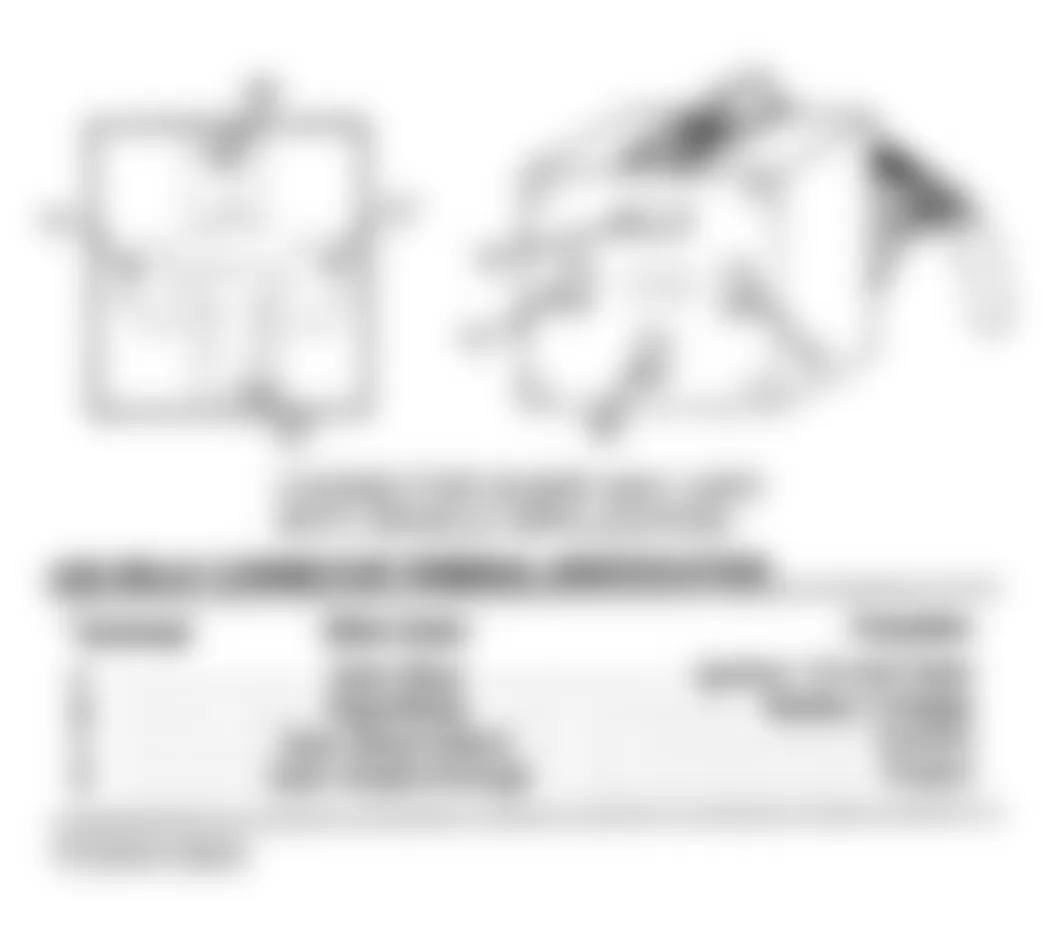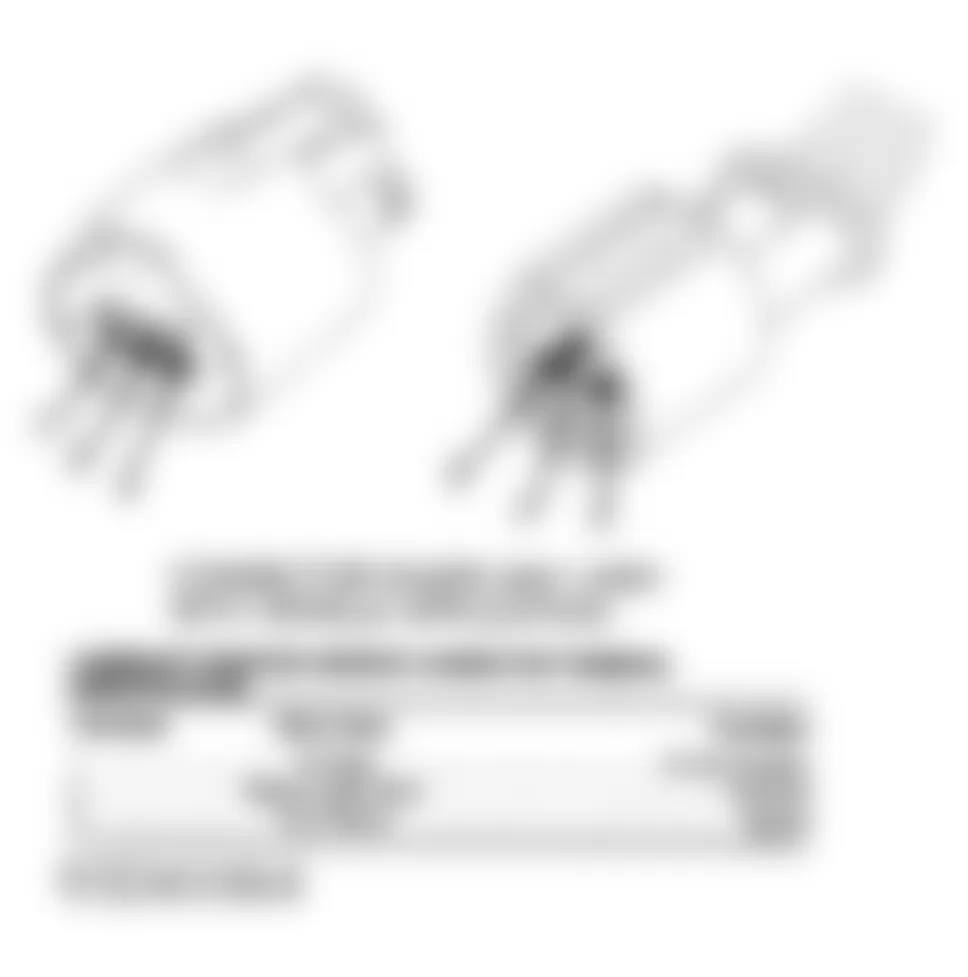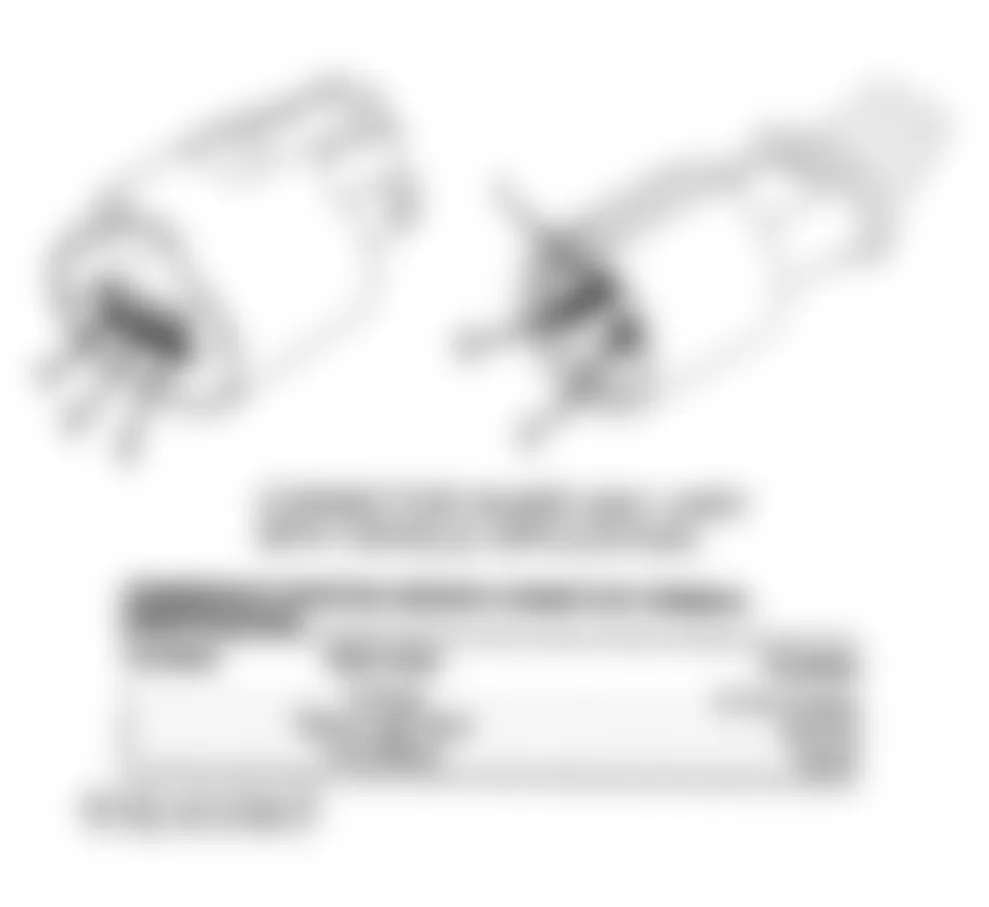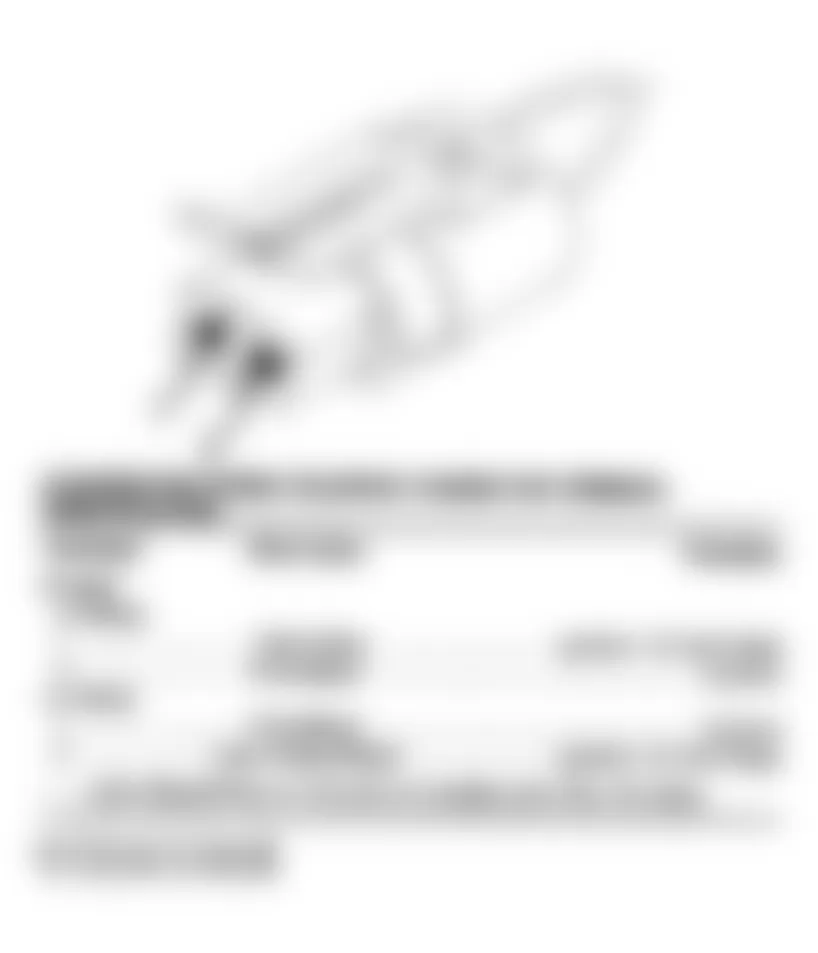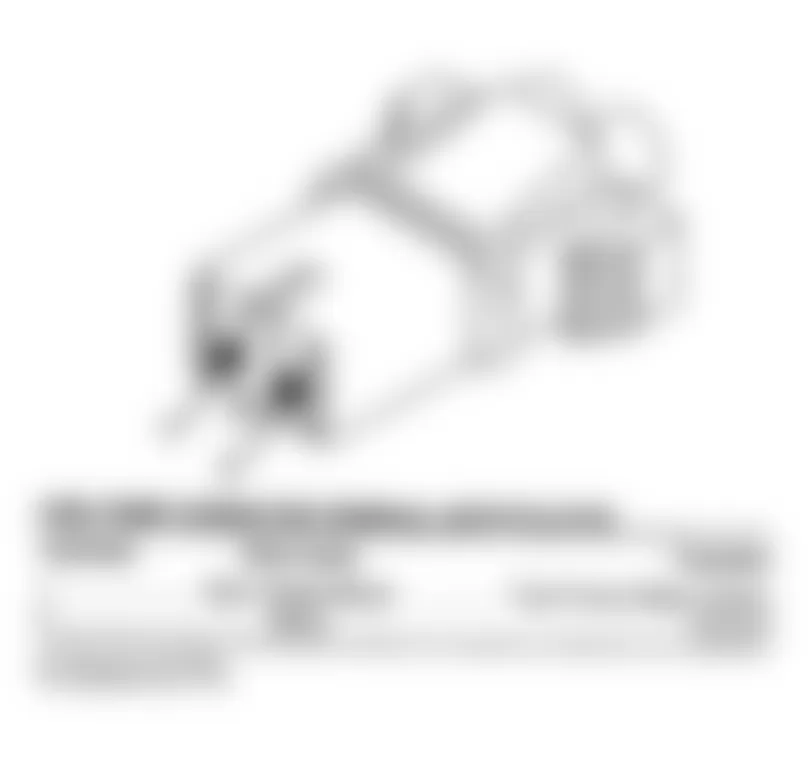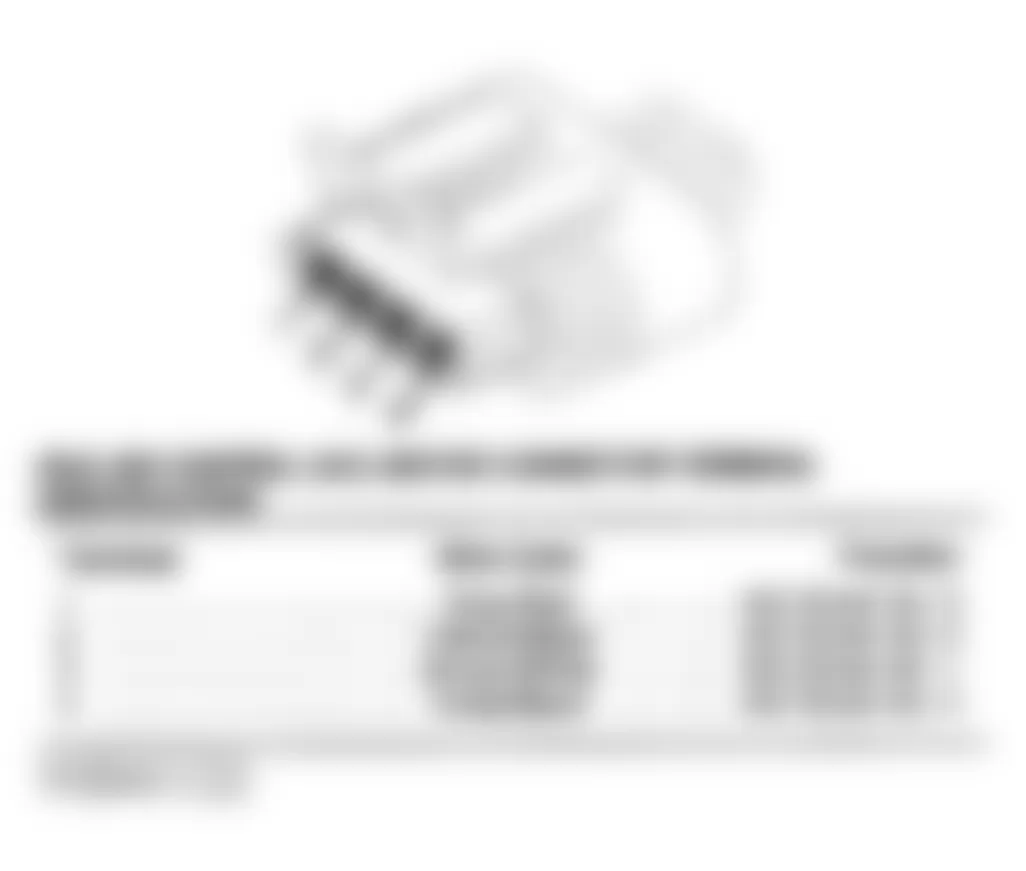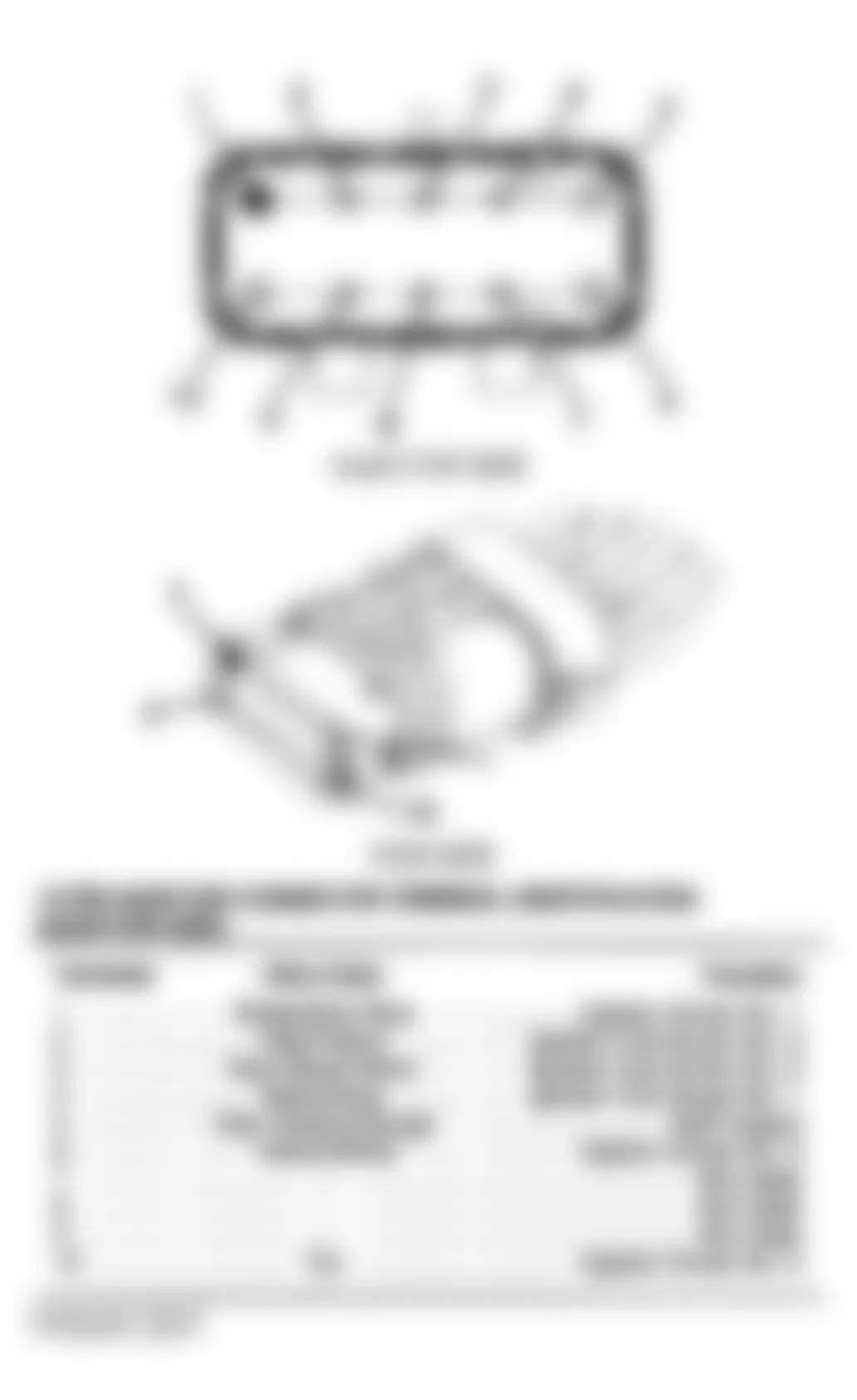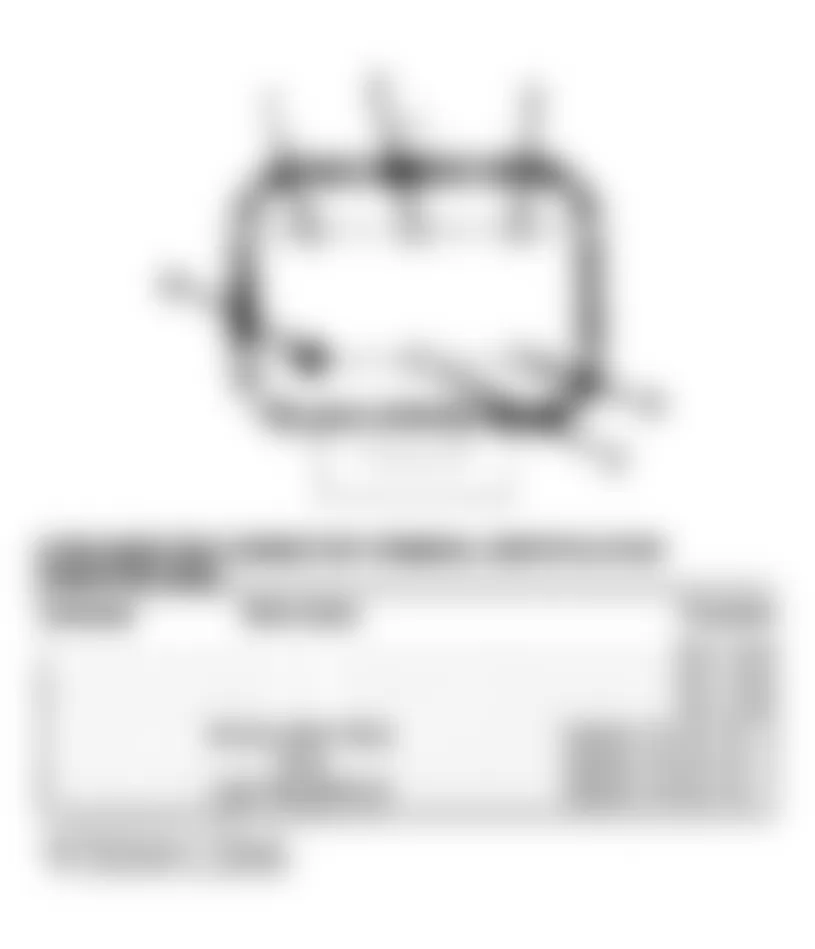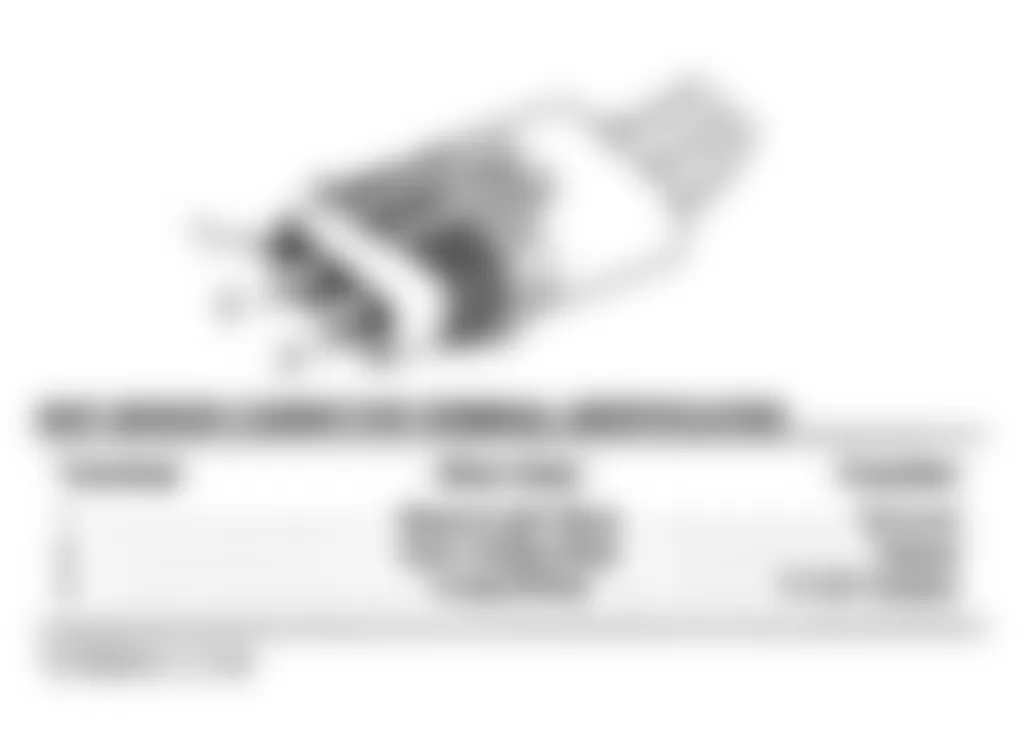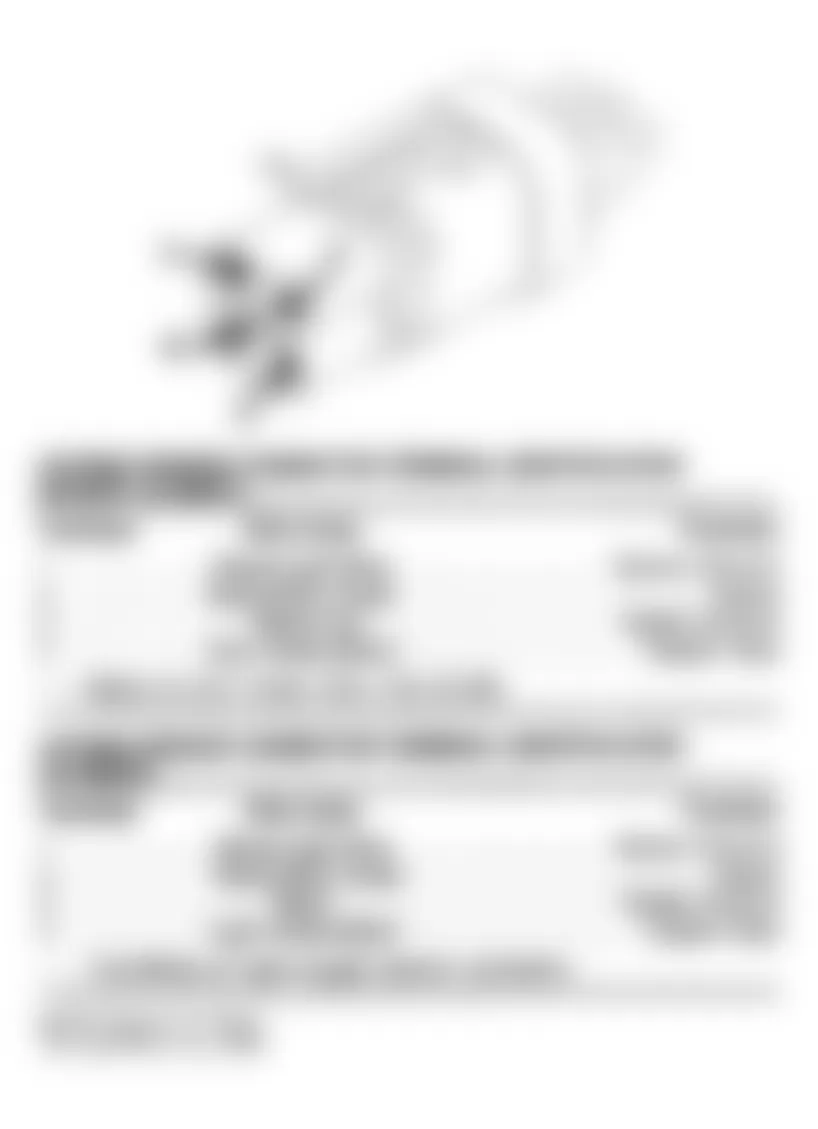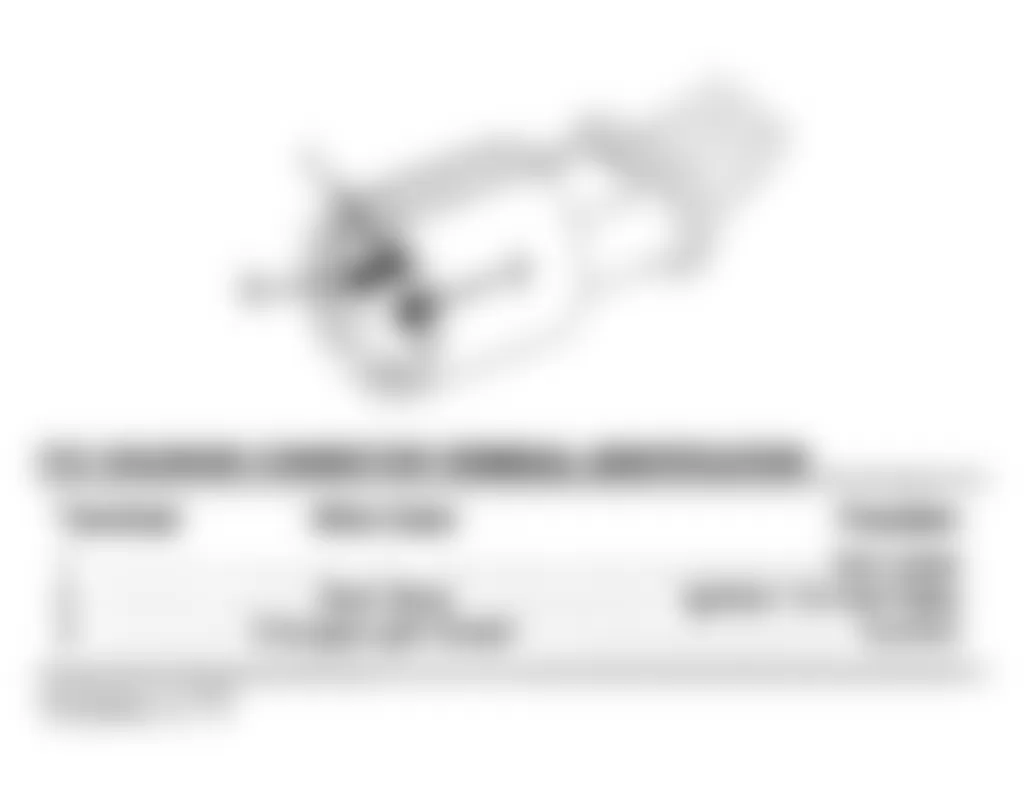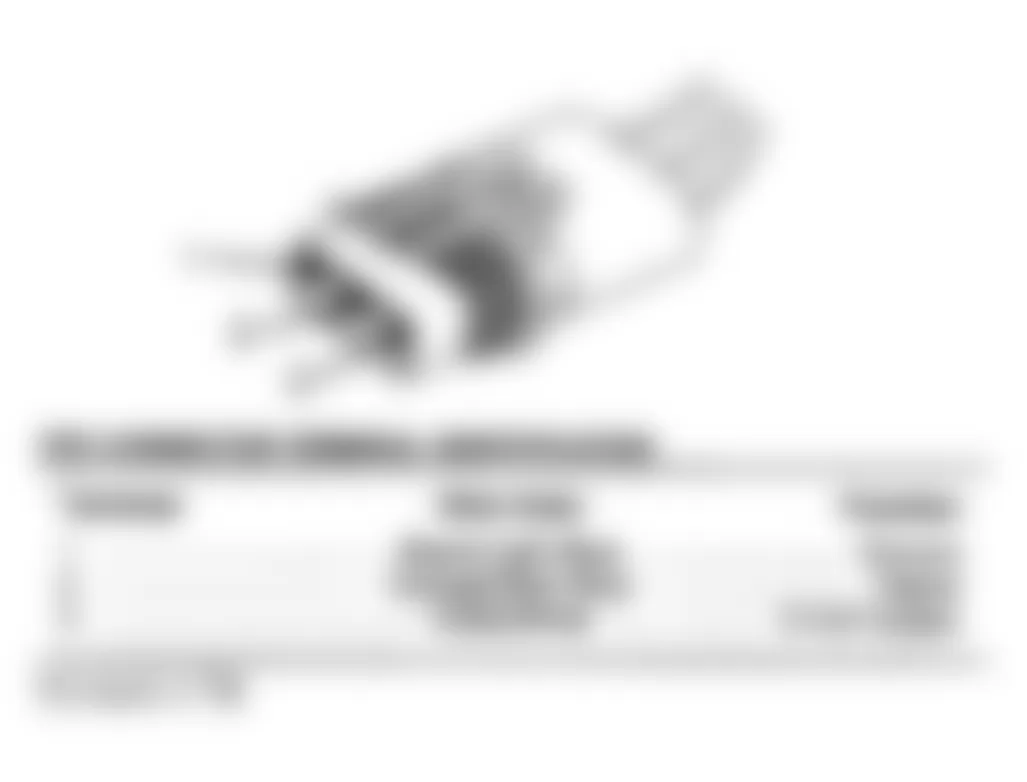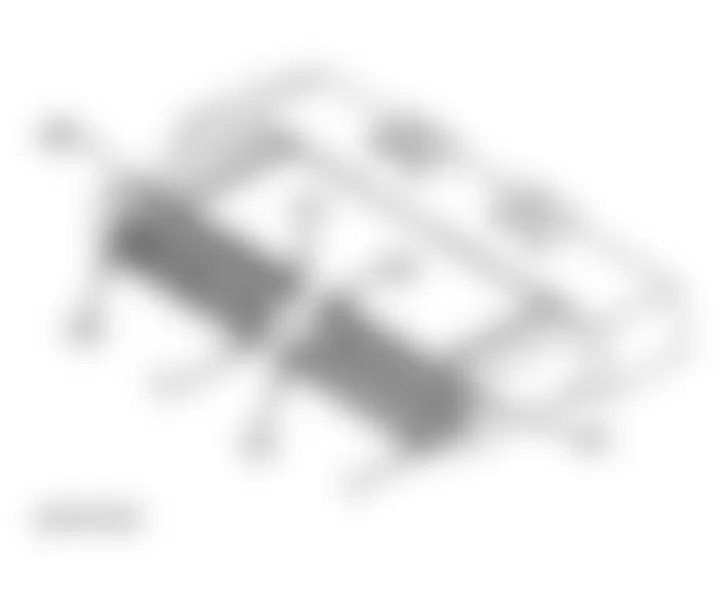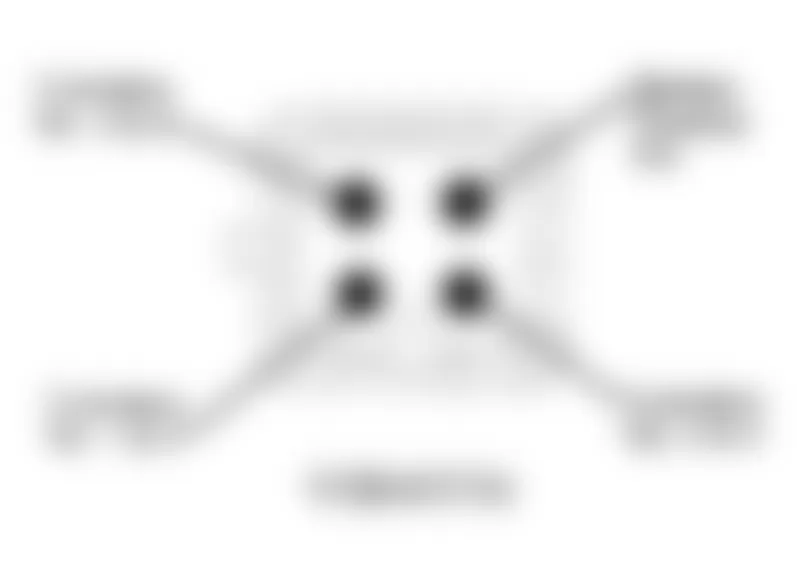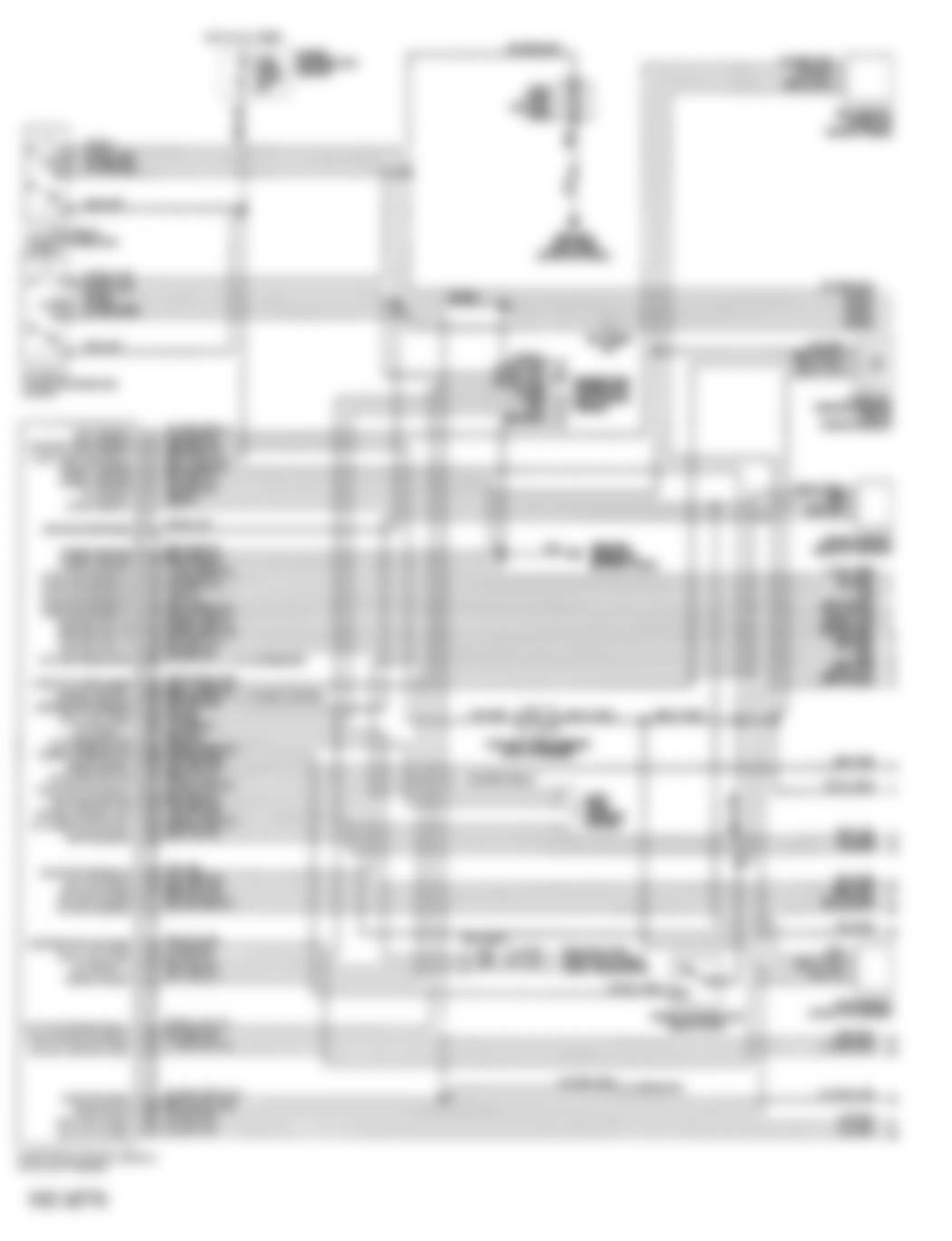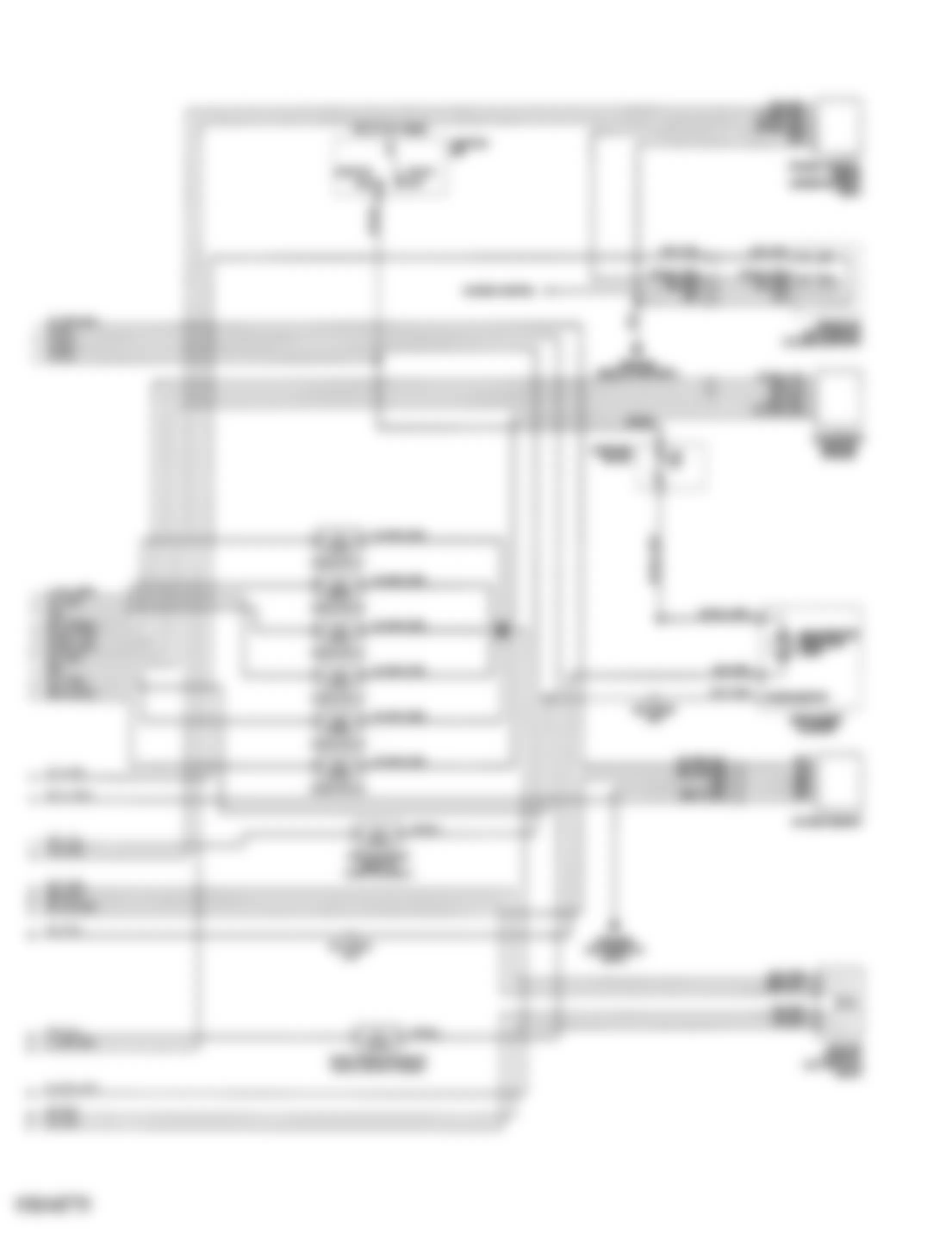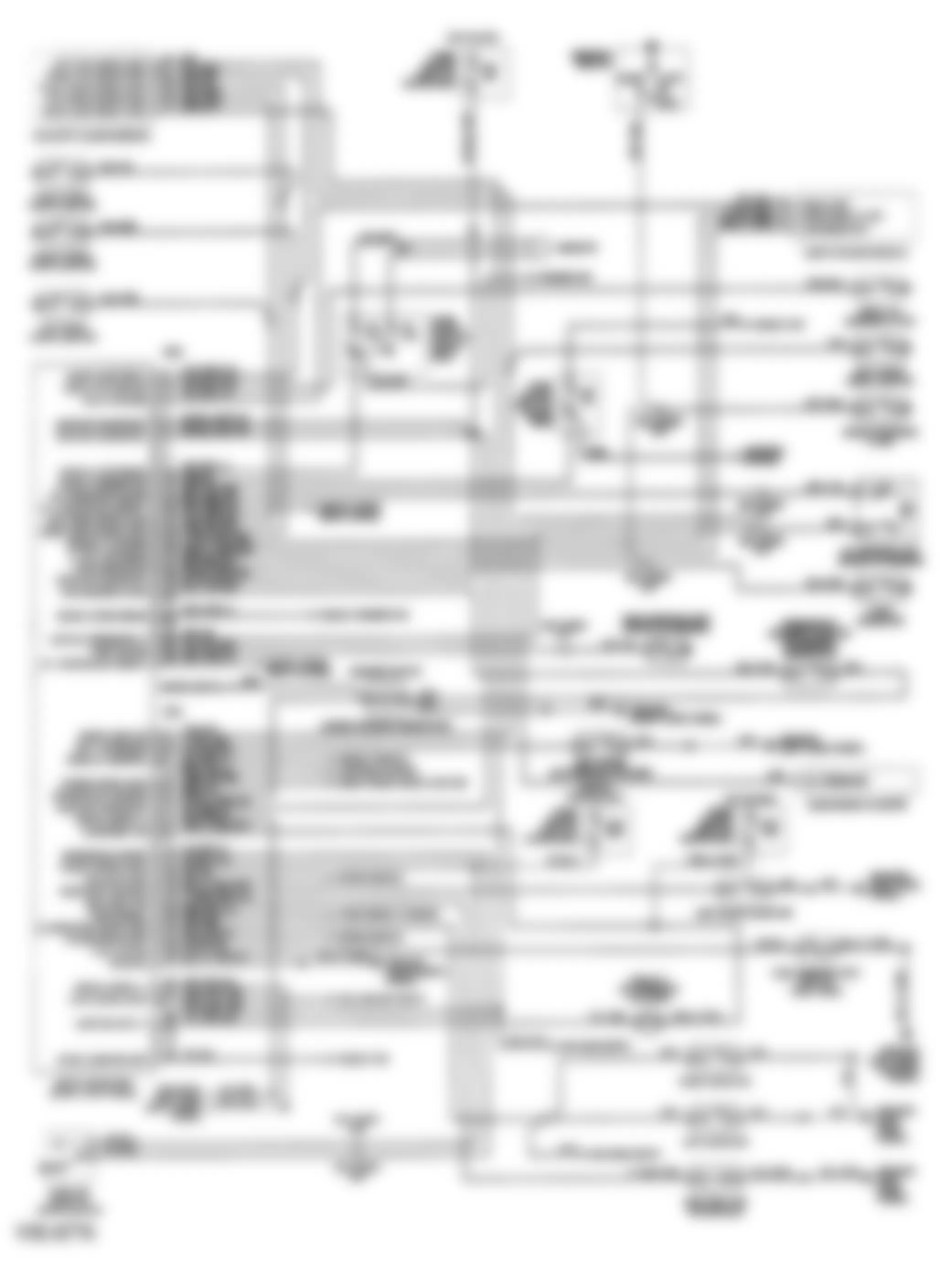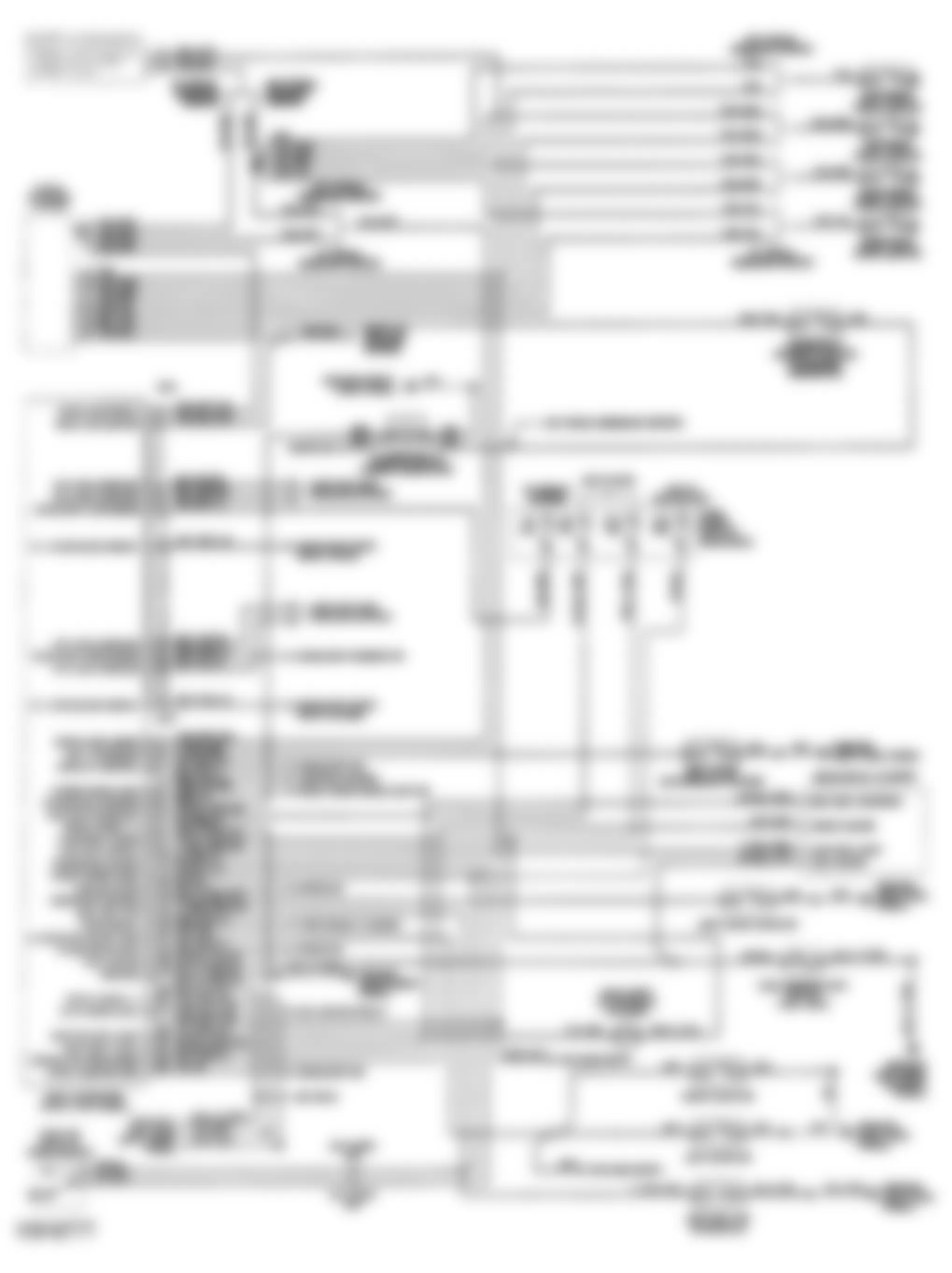Chrysler New Yorker Salon 1993 - 1993 ENGINE PERFORMANCE Tests W/Codes - 3.3L/3.8LTests-3.3L (VIN R) & 3.8L SFI
Chrysler New Yorker Salon 1993 - INTRODUCTION SYSTEM DIAGNOSTICS
The self-diagnostic capabilities of this system, if properly utilized, can simplify testing. The Powertrain Control Module (PCM) monitors several different engine control system circuits.
If a problem is sensed with a monitored circuit, PCM memory stores a fault, the CHECK ENGINE light glows and PCM enters limp-in mode. In limp-in mode, PCM compensates for component failure by substituting information from other sources. This allows vehicle operation until repairs can be made.
Test circuits and repair or replace components as required. If problem is repaired or ceases to exist, the PCM cancels fault after 50 ignition on/off cycles.
A specific fault results from a particular system failure. A fault does not condemn a specific component; component is not necessarily the reason for failure. Faults only call out a probable malfunction area.
Chrysler New Yorker Salon 1993 - Hard Failures
Hard failures cause CHECK ENGINE light to glow and remain on until the malfunction is repaired. If light comes on and remains on (light may flash) during vehicle operation, cause of malfunction must be determined using self-diagnostic tests. If a sensor fails, PCM will use a substitute value in its calculations, allowing engine to operate in limp-in mode. In this condition, vehicle will run, but driveability may be poor.
Chrysler New Yorker Salon 1993 - Intermittent Failures
Intermittent failures may cause CHECK ENGINE light to flicker or stay on until the intermittent fault goes away. However, the corresponding fault will be retained in PCM memory. If related fault does not reoccur within a certain time frame, related fault will be erased from PCM memory. Intermittent failures can be caused by a faulty sensor, bad connector or wiring related problems.
Chrysler New Yorker Salon 1993 - MODEL IDENTIFICATION
Chrysler New Yorker Salon 1993 VEHICLE BODY IDENTIFICATION
Model Name Body Type Dynasty & New Yorker AC Fifth Avenue & Imperial AY
Chrysler New Yorker Salon 1993 - SELF-DIAGNOSTIC SYSTEM SERVICE PRECAUTIONS
Before proceeding with diagnosis, the following precautions must be followed:
- ALWAYS relieve fuel pressure before disconnecting any fuel injection-related component. DO NOT allow fuel to contact engine or electrical components. See FUEL PRESSURE RELEASE .
- When battery is disconnected, vehicle computer and memory systems may lose memory data. Driveability problems may exist until computer systems have completed a relearn cycle. See COMPUTER RELEARN PROCEDURES article in GENERAL INFORMATION before disconnecting battery.
- Vehicle must have a fully charged battery and functional charging system.
- Probe PCM 60-pin connector from pin side. DO NOT backprobe PCM connector.
- DO NOT cause short circuits when performing electrical tests. This will set additional faults, making diagnosis of original problem more difficult.
- DO NOT use a test light instead of a voltmeter.
- When checking for spark, ensure coil wire is NO more than 1/4" from ground. If coil wire is more than 1/4" from ground, damage to vehicle electronics and/or PCM may result.
- DO NOT prolong testing of fuel injectors or engine may hydrostatically (liquid) lock.
- Always repair lowest fault code number (CHECK ENGINE light) or first fault displayed (DRB-II) first.
- Always perform verification procedure test after repairs are made.
- Always disconnect DRB-II after use.
- Always disconnect DRB-II before charging battery.
Chrysler New Yorker Salon 1993 - VISUAL INSPECTION
Most driveability problems in the engine control system result from faulty wiring, poor electrical connections or leaking air and vacuum hose connections. To avoid unnecessary component testing, perform a visual inspection before beginning self-diagnostic tests.
Chrysler New Yorker Salon 1993 - DIAGNOSTIC PROCEDURE
NOTE: DO NOT skip any steps in self-diagnostic tests or incorrect diagnosis may result. Ensure self-diagnostic tests apply to engine being tested.
If no faults were found while performing BASIC DIAGNOSTIC PROCEDURES, proceed with self-diagnostics. Always perform a visual inspection before attempting to diagnose engine control system problems. See VISUAL INSPECTION . Enter on-board diagnostics, and retrieve fault code(s) using CHECK ENGINE light or retrieve fault messages using DRB-II. See ENTERING ON-BOARD DIAGNOSTICS . If faults are not present and/or DRB-II (Diagnostic Readout Box-II) is used, proceed to TEST FC-1A. Perform indicated VERIFICATION PROCEDURE test after repairs.
Chrysler New Yorker Salon 1993 - ENTERING ON-BOARD DIAGNOSTICS
NOTE: Although other scan testers are available, manufacturer recommends using DRB-II (Diagnostic Readout Box II) to diagnose the system. CHECK ENGINE light function can be used but has limited diagnostic capability.
Chrysler New Yorker Salon 1993 - CHECK ENGINE Light Diagnostic Mode
- Start engine (if possible). Move transmission shift lever through all positions, ending in Park. Turn A/C switch on and then off (if equipped).
- Turn engine off. Without starting engine again, turn ignition on, off, on, off and on within 5 seconds. Record 2-digit fault codes as displayed by flashing CHECK ENGINE light.
- For example, fault code 23 is displayed as flash, flash, 4-second pause, flash, flash, flash. After a slightly longer pause, other codes stored are displayed in numerical order.
- When CHECK ENGINE light begins to flash fault codes, it cannot be stopped. Start over if count is lost. Code 55 indicates end of fault code display.
- - DTC & FAULT CODES/MESSAGE table to translate trouble code number to a DRB-II fault message. Once trouble area is identified, refer to TEST FC-1A. Use DRB-II fault messages to find appropriate test.
- As an example, a 3.0L engine starts and runs but has a driveability problem. CHECK ENGINE light indicates a Code 14. - DTC & FAULT CODES/MESSAGES to translate trouble code number to a DRB-II fault message.
- When DRB-II fault message is obtained, refer to appropriate test number. To clear fault codes, see CLEARING FAULTS .
Chrysler New Yorker Salon 1993 - DRB-II Diagnostic Mode
- Turn ignition off. Connect DRB-II to engine diagnostic connector. Engine diagnostic connector is located in engine compartment, near PCM.
- Start engine (if possible). With foot on brake, move transmission shift lever through all positions, ending in PARK. Turn A/C switch on and then off (if equipped).
- Turn engine off. Without starting engine again, turn ignition on. Enter FUEL/IGN FAULTS menu. Press "2" key selecting READ FAULTS. DRB-II will display fault messages.
- When DRB-II fault message is obtained, refer to appropriate test number. To clear fault codes, see CLEARING FAULTS .
Chrysler New Yorker Salon 1993 - CLEARING FAULTS
CAUTION: When battery is disconnected, vehicle computer and memory systems may lose memory data. Driveability problems may exist until computer systems have completed a relearn cycle. See COMPUTER RELEARN PROCEDURES article in GENERAL INFORMATION before disconnecting battery.
- If DRB-II is not available, go to step 3). If DRB-II is available, press "1" key selecting FUEL/IGNITION. Press "2" key selecting READ FAULTS. Press down arrow key selecting next screen. Press "2" key selecting ERASE.
- DRB-II will display ERASE FAULTS ARE YOU SURE? (ENTER TO ERASE). Press ENTER key. When DRB-II is finished erasing faults, screen will display FAULTS ERASED.
- Fault codes may be cleared by disconnecting negative battery cable for at least 15 seconds, allowing PCM to clear faults.
Chrysler New Yorker Salon 1993 - INACTIVE FAULT CONDITION
This procedure applies if you have been sent here from diagnostic charts and have just attempted to simulate the condition that initially set the fault message. The following additional checks may assist in identifying a possible intermittent problem:
- Visually inspect related wiring harness connectors for broken, bent, pushed out or corroded terminals.
- Visually inspect related wiring harnesses for chafed, pierced or partially broken wires.
- Check all pertinent TECH SERVICE BULLETINS (TSBs).
Chrysler New Yorker Salon 1993 - USING DRB-II
NOTE: Although other scan testers are available, manufacturer recommends using DRB-II (Diagnostic Readout Box II) to diagnose the system.
Ensure DRB-II is connected to engine diagnostic connector located in engine compartment. Ensure correct cartridge is installed in DRB-II for vehicle and system being diagnosed. Menu selections will vary depending on vehicle and system being diagnosed. Follow DRB-II screen prompts to actuate, adjust, monitor, reset, test and diagnose system as necessary.
DRB-II is grounded through engine diagnostic connector, only one volt-ohmmeter test lead is required when using volt-ohmmeter option. DRB-II volt-ohmmeter should only be used when self-diagnostic tests require the use of this option.
If DRB-II has a blank screen or displays RAM TEST FAILURE, CARTRIDGE ERROR, KEY PAD TEST FAILURE or LOW OR HIGH BATTERY, this indicates a DRB-II failure. To diagnose and correct these conditions, see TESTS W/CODES - 3.3L/3.8L article in this Section.
Chrysler New Yorker Salon 1993 - FUEL PRESSURE RELEASE
CAUTION: When battery is disconnected, vehicle computer and memory systems may lose memory data. Driveability problems may exist until computer systems have completed a relearn cycle. See COMPUTER RELEARN PROCEDURES article in GENERAL INFORMATION before disconnecting battery.
Chrysler New Yorker Salon 1993 - Multi-Point Injection (MPI)
- Turn ignition off. Disconnect negative battery cable. Slowly open fuel tank cap to release pressure in tank. Remove fuel rail pressure test port cap. Place open end of Fuel Pressure Release Hose (C-4799-A) in approved gasoline container.
- Connect other end of pressure release hose to test port. As fuel pressure release hose is tightened onto fuel rail pressure test port, fuel pressure will bleed-off into container.
CAUTION: DO NOT energize only one injector to relieve fuel pressure. Energize 3 different injectors. Energizing only one injector to relieve all fuel pressure may hydrostatically lock engine. DO NOT ground injector for more than 5 seconds.
Chrysler New Yorker Salon 1993 - DTC & FAULT CODES/MESSAGES
NOTE: DRB-II display may vary depending on vehicle application. Not all fault codes apply to all vehicles. Some fault codes have more than one meaning. When a fault code has more than one meaning, CHECK ENGINE light is unable to distinguish between different failures.
Chrysler New Yorker Salon 1993 - FAULT CODES/MESSAGES
NOTE: For DTC table, see TEST FC-1A under
Chrysler New Yorker Salon 1993 - Code 11
DRB-II displays NO CRANK REFERENCE SIGNAL AT PCM. Condition is: no distributor or camshaft reference signal picked up during cranking.
Chrysler New Yorker Salon 1993 - Code 13
DRB-II displays SLOW CHANGE IN IDLE MAP SENSOR SIGNAL. Condition is: Manifold Absolute Pressure (MAP) sensor output change slower and/or smaller than expected.
Chrysler New Yorker Salon 1993 - Code 13
DRB-II displays NO CHANGE IN MAP FROM START TO RUN. Condition is: no difference recognized between Manifold Absolute Pressure (MAP) reading and barometric (atmospheric) pressure reading at start-up.
Chrysler New Yorker Salon 1993 - Code 14
DRB-II displays MAP VOLTAGE TOO LOW. Condition is: Manifold Absolute Pressure (MAP) sensor input less than minimum acceptable voltage.
Chrysler New Yorker Salon 1993 - Code 14
DRB-II displays MAP VOLTAGE TOO HIGH. Condition is: Manifold Absolute Pressure (MAP) sensor input more than maximum acceptable voltage.
Chrysler New Yorker Salon 1993 - Code 15
DRB-II displays NO VEHICLE SPEED SENSOR SIGNAL. Condition is: no Vehicle Speed Sensor (VSS) signal detected with road load conditions.
Chrysler New Yorker Salon 1993 - Code 16
DRB-II displays KNOCK SENSOR #1 CIRCUIT or KNOCK SENSOR #2 CIRCUIT. Condition is: open or shorted condition detected in knock sensor circuit.
Chrysler New Yorker Salon 1993 - Code 17
DRB-II displays ENGINE IS COLD TOO LONG. Condition is: coolant temperature stays less than normal operating temperature during vehicle operation.
Chrysler New Yorker Salon 1993 - Code 21
DRB-II displays O2S STAYS AT CENTER. Condition is: no rich or lean signal detected from oxygen sensor input.
Chrysler New Yorker Salon 1993 - Code 21
DRB-II displays O2S SHORTED TO VOLTAGE. Condition is: oxygen sensor input voltage maintained at more than normal operating range.
Chrysler New Yorker Salon 1993 - Code 22
DRB-II displays ECT SENSOR VOLTAGE TOO LOW. Condition is: Engine Coolant Temperature (ECT) sensor input less than minimum acceptable voltage.
Chrysler New Yorker Salon 1993 - Code 22
DRB-II displays ECT SENSOR VOLTAGE TOO HIGH. Condition is: Engine Coolant Temperature (ECT) sensor input more than maximum acceptable voltage.
Chrysler New Yorker Salon 1993 - Code 23
DRB-II displays INTAKE AIR TEMPERATURE SENSOR VOLTAGE LOW. Condition is: Intake Air Temperature (IAT) sensor input less than minimum acceptable voltage.
Chrysler New Yorker Salon 1993 - Code 23
DRB-II displays INTAKE AIR TEMPERATURE SENSOR VOLTAGE HIGH. Condition is: Intake Air Temperature (IAT) sensor input more than maximum acceptable voltage.
Chrysler New Yorker Salon 1993 - Code 24
DRB-II displays THROTTLE POSITION SENSOR VOLTAGE LOW. Condition is: Throttle Position Sensor (TPS) input less than minimum acceptable voltage.
Chrysler New Yorker Salon 1993 - Code 24
DRB-II displays THROTTLE POSITION SENSOR VOLTAGE HIGH. Condition is: Throttle Position Sensor (TPS) input more than maximum acceptable voltage.
Chrysler New Yorker Salon 1993 - Code 25
DRB-II displays IDLE AIR CONTROL MOTOR CIRCUITS. Condition is: open or shorted condition detected in one or more Idle Air Control (IAC) motor circuits.
Chrysler New Yorker Salon 1993 - Code 27
DRB-II displays INJECTOR #1-6 CONTROL CIRCUIT. Condition is: injector output driver does not respond properly to Powertrain Control Module (PCM) control signal.
Chrysler New Yorker Salon 1993 - Code 31
DRB-II displays EVAP PURGE SOLENOID CKT. Condition is: open or shorted condition detected in purge solenoid circuit.
Chrysler New Yorker Salon 1993 - Code 32
DRB-II displays EGR SOLENOID CIRCUIT. Condition is: open or shorted condition detected in Exhaust Gas Recirculation (EGR) transducer solenoid circuit.
Chrysler New Yorker Salon 1993 - Code 32
DRB-II displays EGR SYSTEM FAILURE. Condition is: Powertrain Control Module (PCM) did not detect required air/fuel change during diagnostic test.
Chrysler New Yorker Salon 1993 - Code 33
DRB-II displays A/C CLUTCH RELAY CIRCUIT. Condition is: open or shorted condition detected in A/C clutch relay circuit.
Chrysler New Yorker Salon 1993 - Code 33
DRB-II displays A/C PRESSURE SENSOR HIGH. Condition is: open condition detected in A/C pressure sensor circuit.
Chrysler New Yorker Salon 1993 - Code 33
DRB-II displays A/C PRESSURE SENSOR LOW. Condition is: shorted condition detected in A/C pressure sensor circuit.
Chrysler New Yorker Salon 1993 - Code 34
DRB-II displays SPEED CONTROL SOLENOID CIRCUITS. Condition is: open or shorted condition detected in Speed Control (S/C) vacuum or vent solenoid circuits.
Chrysler New Yorker Salon 1993 - Code 35
DRB-II displays RADIATOR FAN RELAY CIRCUIT. Condition is: open or shorted condition detected in radiator fan relay circuit.
Chrysler New Yorker Salon 1993 - Code 35
DRB-II displays LOW SPEED FAN CTRL RELAY CIRCUIT. Condition is: open or shorted condition detected in low speed radiator fan relay circuit.
Chrysler New Yorker Salon 1993 - Code 35
DRB-II displays HIGH SPEED FAN RELAY CIRCUIT. Condition is: open or shorted condition detected in high speed radiator fan relay circuit.
Chrysler New Yorker Salon 1993 - Code 36
DRB-II displays TC WASTEGATE SOLENOID CIRCUIT. Condition is: open or shorted condition detected in turbocharger wastegate control solenoid circuit.
Chrysler New Yorker Salon 1993 - Code 37
DRB-II displays TORQUE CONVERTER CLUTCH SOLENOID CIRCUIT. Condition is: open or shorted condition detected in Torque Converter Clutch (TCC) solenoid circuit.
Chrysler New Yorker Salon 1993 - Code 41
DRB-II displays GENERATOR FIELD NOT SWITCHING PROPERLY. Condition is: open or shorted condition detected in alternator field circuit.
Chrysler New Yorker Salon 1993 - Code 42
DRB-II displays AUTO SHUTDOWN RELAY CONTROL CIRCUIT. Condition is: open or shorted condition detected in Auto Shutdown (ASD) relay circuit.
Chrysler New Yorker Salon 1993 - Code 43
DRB-II displays IGNITION COIL #1-3 CONTROL CIRCUIT. Condition is: open or shorted condition detected in ignition coil driver circuit.
Chrysler New Yorker Salon 1993 - Code 44
DRB-II displays BATTERY TEMP SENSOR VOLTS OUT OF LIMIT. Condition is: Powertrain Control Module (PCM) failure.
Chrysler New Yorker Salon 1993 - Code 45
DRB-II displays TURBO BOOST LIMIT EXCEEDED. Condition is: turbo boost has exceeded a preset value stored in Powertrain Control Module (PCM).
Chrysler New Yorker Salon 1993 - Code 46
DRB-II displays CHARGING SYSTEM VOLTAGE TOO HIGH. Condition is: battery voltage sense input more than target charging voltage during engine operation.
Chrysler New Yorker Salon 1993 - Code 47
DRB-II displays CHARGING SYSTEM VOLTAGE TOO LOW. Condition is: battery voltage sense input less than target charging voltage during engine operation.
Chrysler New Yorker Salon 1993 - Code 51
DRB-II displays O2S STAYS BELOW CENTER (LEAN). Condition is: oxygen sensor input indicates lean air/fuel ratio during engine operation.
Chrysler New Yorker Salon 1993 - Code 52
DRB-II displays 02S STAYS ABOVE CENTER (RICH). Condition is: oxygen sensor input indicates rich air/fuel ratio during engine operation.
Chrysler New Yorker Salon 1993 - Code 53
DRB-II displays INTERNAL PCM FAILURE. Condition is: Powertrain Control Module (PCM) detects internal failure.
Chrysler New Yorker Salon 1993 - Code 54
DRB-II displays NO CAM SYNC SIGNAL AT PCM. Condition is: open or shorted condition detected in cam sync signal circuit.
Chrysler New Yorker Salon 1993 - Code 55
DRB-II display will be blank. Completion of fault code display by CHECK ENGINE light.
Chrysler New Yorker Salon 1993 - Code 61
DRB-II displays BARO READ SOLENOID CIRCUIT. Condition is: open or shorted condition detected in barometric read solenoid circuit.
Chrysler New Yorker Salon 1993 - Code 62
DRB-II displays PCM FAILURE SRI MILE NOT STORED. Condition is: Powertrain Control Module (PCM) detects internal failure.
Chrysler New Yorker Salon 1993 - Code 63
DRB-II displays PCM FAILURE EEPROM WRITE DENIED. Condition is: unsuccessful attempt to write to an EEPROM location by PCM.
Chrysler New Yorker Salon 1993 - Code 64
DRB-II displays FLEX FUEL SENSOR HIGH. Condition is: methanol concentration sensor input more than maximum acceptable voltage.
Chrysler New Yorker Salon 1993 - Code 64
DRB-II displays FLEX FUEL SENSOR LOW. Condition is: methanol concentration sensor input less than maximum acceptable voltage.
Chrysler New Yorker Salon 1993 - Code 65
DRB-II displays MANIFOLD TUNE VALVE SOLENOID CIRCUIT. Condition is: open or shorted condition detected in Manifold Tuning Valve (MTV) solenoid circuit.
Chrysler New Yorker Salon 1993 - Code 66
DRB-II displays NO CCD MESSAGE FROM TCM. Condition is: Powertrain Control Module (PCM) did not receive messages from transmission control module.
Chrysler New Yorker Salon 1993 - Code 66
DRB-II displays NO CCD MESSAGE FROM BODY CONTROL MODULE. Condition is: Powertrain Control Module (PCM) did not receive messages from body control module.
Chrysler New Yorker Salon 1993 - Code 77
DRB-II displays SPEED CONTROL POWER RELAY CIRCUIT. Condition is: open or shorted condition detected in speed control power relay circuit.
Chrysler New Yorker Salon 1993 - CONNECTOR IDENTIFICATION
Chrysler New Yorker Salon 1993 CONNECTOR IDENTIFICATION DIRECTORY
Connector See
Fig.re Auto Shutdown (ASD) Relay Fig. 1 Barometric Pressure Solenoid Fig. 2 Camshaft Position Sensor Fig. 3 Crankshaft Position Sensor Fig. 4 Distributor Connector (Harness Side) Fig. 5 Engine Coolant Temperature (ECT) Sensor Fig. 6 Evaporative Purge Solenoid Fig. 7 Fuel Pump Fig. 8 Fuel Pump Relay Fig. 9 Idle Air Control (IAC) Motor Fig. 10 Ignition Coil Fig. 11 Injector Connector Fig. 12 & Fig. 13 Intake Air Temperature (IAT) Sensor Fig. 14 Manifold Absolute Pressure (MAP) Sensor Fig. 15 Manifold Tuning Valve (MTV) Solenoid Fig. 16 Oxygen Sensor Fig. 17 Radiator Fan Relay Fig. 18 & Fig. 19 Torque Converter Clutch Solenoid Fig. 20 Throttle Position Sensor (TPS) Fig. 21 Wastegate Solenoid Fig. 22 Powertrain Control Module (PCM) Fig. 23
Chrysler New Yorker Salon 1993 ASD RELAY CONNECTOR TERMINAL IDENTIFICATION
Terminal Wire Color Function A Dark Blue Ignition 12-Volt Feed B Red/White Battery Voltage C Dark Blue/Yellow Control D Dark Green/Orange Output
Chrysler New Yorker Salon 1993 BAROMETRIC PRESSURE SOLENOID CONNECTOR TERMINAL IDENTIFICATION
Terminal Wire Color Function 1 Dark Blue/White Ignition 12-Volt Feed 2 Light Blue Control
Chrysler New Yorker Salon 1993 CAMSHAFT POSITION SENSOR CONNECTOR TERMINAL IDENTIFICATION
Terminal Wire Color Function 1 Orange 8-Volt Supply 2 Black/Light Blue Ground 3 Tan/Yellow Signal
Chrysler New Yorker Salon 1993 CRANKSHAFT POSITION SENSOR CONNECTOR TERMINAL IDENTIFICATION
Terminal Wire Color Function 1 Orange 8-Volt Supply 2 Black/Light Blue Ground 3 Gray/Black Signal
Chrysler New Yorker Salon 1993 DISTRIBUTOR CONNECTOR TERMINAL IDENTIFICATION
Terminal Wire Color Function 1 Gray/Black Crankshaft Signal 2 Tan/Yellow Camshaft Signal 3 Black/Light Blue Ground
Fig. 5: Chrysler New Yorker Salon 1993 - Component Locations - Distributor Connector Terminal ID
Chrysler New Yorker Salon 1993 ENGINE TEMP COOLANT (ECT) SENSOR CONNECTOR TERMINAL ID
Terminal Wire Color Function 1 Tan/Black Signal 2 Black/Light Blue Ground
Chrysler New Yorker Salon 1993 EVAPORATIVE PURGE SOLENOID CONNECTOR TERMINAL ID
Terminal Wire Color Function 1 Dark Blue Ignition 12-Volt Feed 2 Pink/Black Control
Chrysler New Yorker Salon 1993 FUEL PUMP CONNECTOR TERMINAL IDENTIFICATION
Terminal Wire Color Function 1 Dark Green/Black Fuel Pump Relay Output 2 Black Ground
Fig. 8: Chrysler New Yorker Salon 1993 - Component Locations - Fuel Pump Connector Terminal ID
Chrysler New Yorker Salon 1993 FUEL PUMP RELAY CONNECTOR TERMINAL IDENTIFICATION
Terminal Wire Color Function A Dark Blue Ignition 12-Volt Feed B Red/White Battery Voltage C Dark Blue/Yellow ASD Relay Control D Dark Green/Black Fuel Pump Relay Output
Fig. 9: Chrysler New Yorker Salon 1993 - Component Locations - Fuel Pump Relay Connector Terminal ID
Chrysler New Yorker Salon 1993 IDLE AIR CONTROL (IAC) MOTOR CONNECTOR TERMINAL IDENTIFICATION
Terminal Wire Color Function 1 Gray/Red IAC Driver No. 3 2 Yellow/Black IAC Driver No. 2 3 Brown/White IAC Driver No. 1 4 Violet/Black IAC Driver No. 4
Chrysler New Yorker Salon 1993 IGNITION COIL CONNECTOR TERMINAL IDENTIFICATION
Terminal Wire Color Function 1 Red/Yellow Ignition Coil Driver No. 3 2 Black/Gray Ignition Coil Driver No. 1 3 Dark Blue/Tan Ignition Coil Driver No. 2 4 Dark Green/Orange ASD Relay Output
Fig. 11: Chrysler New Yorker Salon 1993 - Component Locations - Ignition Coil Connector Terminal ID
Chrysler New Yorker Salon 1993 10-PIN INJECTOR CONNECTOR TERMINAL ID (INJECTOR SIDE)
Terminal Wire Color Function 1 White/Dark Blue Injector Driver No. 1 2 Red/Yellow Ignition Coil Driver No. 3 3 Dark Blue/Yellow Ignition Coil Driver No. 2 4 Black/Gray Ignition Coil Driver No. 1 5 Dark Green/Orange ASD Output 6 Yellow/White Injector Driver No. 3 7 Not Used Not Used 8 Not Used Not Used 9 Not Used Not Used 10 Tan Injector Driver No. 2
Chrysler New Yorker Salon 1993 6-PIN INJECTOR CONNECTOR TERMINAL ID (INJECTOR SIDE)
Terminal Wire Color Function 1 Not Used Not Used 2 Not Used Not Used 3 Not Used Not Used 4 Brown/Dark Blue Injector Driver No. 6 5 Gray Injector Driver No. 5 6 Light Blue/Brown Injector Driver No. 4
Fig. 13: Chrysler New Yorker Salon 1993 - Component Locations - 6-Pin Injector Connector Terminal ID
Chrysler New Yorker Salon 1993 INTAKE AIR TEMPERATURE SENSOR CONNECTOR TERMINAL ID
Terminal Wire Color Function 1 Black/Red Signal 2 Black/Light Blue Ground
Chrysler New Yorker Salon 1993 MAP SENSOR CONNECTOR TERMINAL IDENTIFICATION
Terminal Wire Color Function 1 Black/Light Blue Ground 2 Dark Green/Red Signal 3 Violet/White 5-Volt Supply
Chrysler New Yorker Salon 1993 MANIFOLD TUNING VALVE SOLENOID CONNECTOR TERMINAL IDENTIFICATION
Terminal Wire Color Function 1 Violet/White Control 2 Light Green/Black Ignition 12-Volt Feed
Chrysler New Yorker Salon 1993 OXYGEN SENSOR CONNECTOR TERMINAL IDENTIFICATION
Terminal Wire Color Function 1 Black/Light Blue Sensor Ground 2 Black/Dark Green Signal 3 Black Heater Ground 4 Dark Green/Black Heater Feed
Fig. 17: Chrysler New Yorker Salon 1993 - Component Locations - Oxygen Sensor Connector Terminal ID
Chrysler New Yorker Salon 1993 RADIATOR FAN RELAY CONNECTOR TERMINAL IDENTIFICATION
Terminal Wire Color Function A White Ignition 12-Volt Feed B Gray Battery Voltage C Dark Blue/Pink Control D Light Green Output
Chrysler New Yorker Salon 1993 RADIATOR FAN RELAY CONNECTOR TERMINAL IDENTIFICATION
Terminal Wire Color Function A Dark Blue Ignition 12-Volt Feed B Gray Battery Voltage C Dark Blue/Pink Control D Light Green Output
Chrysler New Yorker Salon 1993 TORQUE CONVERTER CLUTCH SOLENOID CONNECTOR TERMINAL ID
Terminal Wire Color Function 1 Not Used Not Used 2 Dark Blue Ignition 12-Volt Feed 3 Orange/Light Green Control
Chrysler New Yorker Salon 1993 THROTTLE POSITION SENSOR (TPS) CONNECTOR TERMINAL ID
Terminal Wire Color Function 1 Black/Light Blue Ground 2 Orange/Dark Blue Signal 3 Violet/White 5-Volt Supply
Chrysler New Yorker Salon 1993 WASTEGATE SOLENOID CONNECTOR TERMINAL IDENTIFICATION
Terminal Wire Color Function 1 Dark Blue/White Ignition 12-Volt Feed 2 Light Green/Black Control
CAUTION: When battery is disconnected, vehicle computer and memory systems may lose memory data. Driveability problems may exist until computer systems have completed a relearn cycle. See COMPUTER RELEARN PROCEDURES article in GENERAL INFORMATION before disconnecting battery.
Chrysler New Yorker Salon 1993 - SELF-DIAGNOSTIC TESTS
NOTE: In following self-diagnostic tests, illustrations are courtesy of Chrysler Corp.
Chrysler New Yorker Salon 1993 - FAULT CODE TESTS TEST FC-1A - CHECKING FOR FAULTS
NOTE: For connector terminal identification, see CONNECTOR IDENTIFICATION . For appropriate wiring diagram, see WIRING DIAGRAMS at end of article.
- Battery must be fully charged before proceeding. Attempt to start engine. If engine will not start, crank engine for at least 10 seconds. Connect DRB-II to engine diagnostic connector. Record DRB-II fault messages.
- If DRB-II has a blank screen or displays RAM TEST FAILURE, CARTRIDGE ERROR, KEY PAD TEST FAILURE, or LOW OR HIGH BATTERY, DRB-II failure is indicated. To diagnose and correct, see appropriate TESTS W/CODES - 3.3L/3.8L article in this section.
- If DRB-II displays NO RESPONSE, go to TEST NS-6A. If fault messages are displayed, see DTC & DRB-II FAULT MESSAGES table. If no fault messages are displayed and a driveability problem is present, go to TEST NF-1A. If no fault messages are displayed and a no-start problem is present, go to TEST NS-1A.
Chrysler New Yorker Salon 1993 DTC & DRB-II FAULT MESSAGES
DTC DRB-II Message Test No. Code 11 NO CRANK REFERENCE SIGNAL AT PCM FC-2A Code 54 NO CAM SYNC SIGNAL AT PCM FC-3A Code 13 NO CHANGE IN MAP FROM START TO RUN FC-4A Code 14 MAP SENSOR VOLTAGE TOO LOW FC-5A Code 14 MAP SENSOR VOLTAGE TOO HIGH FC-6A Code 15 NO VEHICLE SPEED SENSOR SIGNAL FC-7A Code 21 O2S SHORTED TO VOLTAGE FC-8A Code 21 O2S STAYS AT CENTER FC-9A Code 52 O2S STAYS ABOVE CENTER (RICH) FC-10A Code 51 O2S STAYS BELOW CENTER (LEAN) FC-11A Code 22 ECT SENSOR VOLTAGE TOO HIGH FC-12A Code 22 ECT SENSOR VOLTAGE TOO LOW FC-13A Code 24 THROTTLE POSITION SENSOR VOLTAGE HIGH FC-14A Code 24 THROTTLE POSITION SENSOR VOLTAGE LOW FC-15A Code 25 IDLE AIR CONTROL MOTOR CIRCUITS FC-16A Code 27 INJECTOR #1 CONTROL CIRCUIT FC-17A Code 27 INJECTOR #2 CONTROL CIRCUIT FC-18A Code 27 INJECTOR #3 CONTROL CIRCUIT FC-19A Code 27 INJECTOR #4 CONTROL CIRCUIT FC-20A Code 27 INJECTOR #5 CONTROL CIRCUIT FC-21A Code 27 INJECTOR #6 CONTROL CIRCUIT FC-22A Code 31 EVAP PURGE SOLENOID CIRCUIT FC-23A Code 32 EGR SOLENOID CIRCUIT FC-24A Code 32 EGR SYSTEM FAILURE FC-25A Code 33 A/C CLUTCH RELAY CIRCUIT FC-26A Code 35 RAD FAN CONTROL RELAY CIRCUIT FC-27A Code 42 AUTO SHUTDOWN RELAY CONTROL CIRCUIT FC-30A Code 42 NO ASD RELAY VOLT SENSE AT PCM FC-31A Code 43 IGNITION COIL #1 PRIMARY CIRCUIT FC-32A Code 43 IGNITION COIL #2 PRIMARY CIRCUIT FC-33A Code 43 IGNITION COIL #3 PRIMARY CIRCUIT FC-34A Code 62 PCM FAILURE SRI MILE NOT STORED FC-35A Code 63 PCM FAILURE EEPROM WRITE DENIED FC-35A Code 44 BATTERY TEMP SENSOR VOLTS OUT OF LIMIT (1) Code 47 CHARGING SYSTEM VOLTAGE TOO LOW (1) Code 46 CHARGING SYSTEM VOLTAGE TOO HIGH (1) Code 41 GENERATOR FIELD NOT SWITCHING PROPERLY (1) Code 17 ENGINE IS COLD TOO LONG (2) Code 53 INTERNAL PCM FAILURE (3) Code 34 SPEED CONTROL SOLENOID CIRCUITS (4)
(1) - appropriate ALTERNATORS & REGULATORS article in the ELECTRICAL Section.
(2) Check cooling system if engine temperature does not reach 176?F (80?C) after driving 20 minutes. This code may set in error during very cold slow speed driving.
(3) Replace PCM and perform VERIFICATION PROCEDURE VER-1.
(4) Refer To Appropriate CRUISE CONTROL SYSTEM article in the ACCESSORIES/SAFETY EQUIPMENT Section.
Chrysler New Yorker Salon 1993 - TEST FC-2A - NO CRANK REFERENCE SIGNAL AT PCM (DTC 11)
NOTE: For connector terminal identification, see CONNECTOR IDENTIFICATION . For appropriate wiring diagram, see WIRING DIAGRAMS at end of article.
- Using DRB-II, erase fault messages. Attempt to start engine. If engine will not start, crank engine for at least 10 seconds.
- Using DRB-II, read fault messages. If DRB-II does not display NO CRANK REFERENCE SIGNAL AT PCM, condition required to set fault is not present at this time. Go to next step. If DRB-II displays NO CRANK REFERENCE SIGNAL AT PCM, go to step 6).
- NO CRANK REFERENCE SIGNAL AT PCM fault sets if Powertrain Control Module (PCM) does not see a Crankshaft Position (CKP) sensor signal with Camshaft Position (CMP) sensor signal present. Possible causes are: failed CKP sensor, open or shorted CKP sensor signal circuit (Gray/Black wire), open or shorted CKP sensor 8-volt supply circuit (Orange wire), open CKP sensor ground circuit (Black/Light Blue wire), improperly adjusted CKP sensor, failed Powertrain Control Module (PCM) or failed Transmission Control Module (TCM). Go to next step.
- Inspect all related wiring and connectors and repair as necessary. Perform VERIFICATION PROCEDURE VER-2. If no problems were found with wiring and connectors, go to next step.
- Start engine. Wiggle wiring harness from CKP sensor to Powertrain Control Module (PCM). If engine misfired or stalled, repair wiring harness as necessary. Perform VERIFICATION PROCEDURE VER-2. If engine did not misfire or stall, see INACTIVE FAULT CONDITION. Perform VERIFICATION PROCEDURE VER-2.
- Turn ignition off. Disconnect Crankshaft Position (CKP) sensor connector. Put DRB-II in ohmmeter mode. Using DRB-II, check resistance of CKP sensor connector, 8-volt supply circuit (Orange wire). If resistance is less than 5 ohms, repair short to ground in Orange wire.
- If resistance is more than 5 ohms, turn ignition on. Put DRB-II in voltmeter mode. Using DRB-II, check voltage on CKP sensor connector, 8-volt supply circuit (Orange wire). If voltage is less than 7 volts, go to TEST FC-2B. If voltage is more than 7 volts, turn ignition off.
- Connect a jumper wire between signal circuit (Gray/Black wire) and ground circuit (Black/Light Blue wire) on CKP sensor connector harness side. Using DRB-II, read Distributorless Ignition System (DIS) signal status. Make and break connection at CKP sensor connector several times while observing DRB-II.
- If DRB-II displayed CRANK ONLY, replace CKP sensor. Perform VERIFICATION PROCEDURE VER-2. If DRB-II did not display CRANK ONLY, turn ignition off. Put DRB-II in ohmmeter mode.
- Check resistance on CKP sensor connector, ground circuit (Black/Light Blue wire). If resistance is more than 5 ohms, repair open in Black/Light Blue wire. Perform VERIFICATION PROCEDURE VER-2.
- If resistance is less than 5 ohms, disconnect PCM connector. Inspect PCM sensor connector for damaged or pushed-out terminals. Repair as necessary. Perform VERIFICATION PROCEDURE VER-2. If PCM connector terminals are okay, go to next step.
- Using an external ohmmeter, check resistance of signal circuit (Gray/Black wire) between CKP sensor connector harness side and PCM connector terminal No. 24. If resistance is more than 5 ohms, repair open in Gray/Black wire. Perform VERIFICATION PROCEDURE VER-2.
- If resistance is less than 5 ohms, put DRB-II in ohmmeter mode. Check resistance of CKP sensor connector, signal circuit (Gray/Black wire). If resistance is more than 5 ohms, replace PCM. Perform VERIFICATION PROCEDURE VER-2.
- If resistance is less than 5 ohms, disconnect Transmission Control Module (TCM) connector. Using DRB-II, check resistance of CKP sensor connector, signal circuit (Gray/Black wire). If resistance is more than 5 ohms, replace TCM. Perform VERIFICATION PROCEDURE VER-2. If resistance is less than 5 ohms, repair short to ground in Gray/Black wire. Perform VERIFICATION PROCEDURE VER-2.
Chrysler New Yorker Salon 1993 - TEST FC-2B - NO CRANK REFERENCE SIGNAL AT PCM
NOTE: For connector terminal identification, see CONNECTOR IDENTIFICATION . For appropriate wiring diagram, see WIRING DIAGRAMS at end of article.
- Turn ignition off. Disconnect Powertrain Control Module (PCM) connector. Inspect PCM connector for damaged or pushed-out terminals. Repair as necessary. Perform VERIFICATION PROCEDUREVER-2. If PCM connector terminals are okay, go to next step.
- Using an external ohmmeter, check resistance of 8-volt supply circuit (Orange wire) between CKP sensor connector harness side and PCM connector terminal No. 7. If resistance is more than 5 ohms, repair open in Orange wire. Perform VERIFICATION PROCEDURE VER-2. If resistance is less than 5 ohms, replace PCM. Perform VERIFICATION PROCEDURE VER-2.
Chrysler New Yorker Salon 1993 - TEST FC-3A - NO CAM SYNC SIGNAL AT PCM (DTC 54)
NOTE: For connector terminal identification, see CONNECTOR IDENTIFICATION . For appropriate wiring diagram, see WIRING DIAGRAMS at end of article.
- Turn ignition off. Disconnect Camshaft Position (CMP) sensor connector. Put DRB-II in ohmmeter mode. Using DRB-II, check resistance of CMP sensor connector, 8-volt supply circuit (Orange wire). If resistance is less than 5 ohms, repair short to ground in Orange wire. Perform VERIFICATION PROCEDURE VER-2.
- If resistance is more than 5 ohms, turn ignition on. Put DRB-II in voltmeter mode. Using DRB-II, check voltage on CMP sensor connector, 8-volt supply circuit (Orange wire). If voltage is less than 7 volts, go to TEST FC-3B.
- If voltage is more than 7 volts, turn ignition off. Connect a jumper wire between signal circuit (Tan/Yellow wire) and ground circuit (Black/Light Blue wire) on CKP sensor connector harness side. Using DRB-II, read Distributorless Ignition System (DIS) signal status. Make and break connection at CKP sensor connector several times while observing DRB-II.
- If DRB-II displayed CAM ONLY, replace CMP sensor. Perform VERIFICATION PROCEDURE VER-2. If DRB-II did not display CAM ONLY, turn ignition off. Put DRB-II in ohmmeter mode.
- Check resistance on CMP sensor connector, ground circuit (Black/Light Blue wire). If resistance is more than 5 ohms, repair open in Black/Light Blue wire. Perform VERIFICATION PROCEDURE VER-2.
- If resistance is less than 5 ohms, disconnect PCM connector. Inspect PCM sensor connector for damaged or pushed-out terminals. Repair as necessary. Perform VERIFICATION PROCEDURE VER-2. If PCM connector terminals are okay, go to next step.
- Using an external ohmmeter, check resistance of signal circuit (Tan/Yellow wire) between CMP sensor connector harness side and PCM connector terminal No. 44. If resistance is more than 5 ohms, repair open in Tan/Yellow wire. Perform VERIFICATION PROCEDURE VER-2.
- If resistance is less than 5 ohms, put DRB-II in ohmmeter mode. Check resistance of CMP sensor connector, signal circuit (Tan/Yellow wire). If resistance is more than 5 ohms, replace PCM. Perform VERIFICATION PROCEDURE VER-2. If resistance is less than 5 ohms, repair short to ground in Tan/Yellow wire. Perform VERIFICATION PROCEDURE VER-2.
Chrysler New Yorker Salon 1993 - TEST FC-3B - NO CAM SYNC SIGNAL AT PCM
NOTE: For connector terminal identification, see CONNECTOR IDENTIFICATION . For appropriate wiring diagram, see WIRING DIAGRAMS at end of article.
- Turn ignition off. Disconnect Powertrain Control Module (PCM) connector. Inspect PCM connector for damaged or pushed-out terminals. Repair as necessary. Perform VERIFICATION PROCEDUREVER-2. If PCM connector terminals are okay, go to next step.
- Using an external ohmmeter, check resistance of 8-volt supply circuit (Orange wire) between CMP sensor connector harness side and PCM connector terminal No. 7. If resistance is more than 5 ohms, repair open in Orange wire. Perform VERIFICATION PROCEDURE VER-2. If resistance is less than 5 ohms, replace PCM. Perform VERIFICATION PROCEDURE VER-2.
Chrysler New Yorker Salon 1993 - TEST FC-4A - NO CHANGE IN MAP FROM START TO RUN (DTC 13)
NOTE: For connector terminal identification, see CONNECTOR IDENTIFICATION . For appropriate wiring diagram, see WIRING DIAGRAMS at end of article.
- Turn ignition on. Using DRB-II, erase fault messages. Start engine. Allow engine to idle for 30 seconds. With engine running, using DRB-II, read fault messages. If DRB-II does not display NO CHANGE IN MAP FROM START TO RUN, go to step 4).
- If DRB-II displays NO CHANGE IN MAP FROM START TO RUN, turn ignition off. Disconnect Manifold Absolute Pressure (MAP) sensor connector. Turn ignition on. Put DRB-II in voltmeter mode. UsingDRB-II, check voltage on MAP sensor connector, 5-volt supply circuit (Violet/White wire).
- If voltage is less than 4 volts, repair open or short in Violet/White wire. Perform VERIFICATION PROCEDURE VER-2. If voltage is more than 4 volts, remove MAP sensor vacuum hose. Inspect condition of MAP sensor vacuum hose. If MAP sensor vacuum hose is restricted or open, replace vacuum hose as necessary. Perform VERIFICATION PROCEDURE VER-2. If MAP sensor vacuum hose is okay, replace MAP sensor. Perform VERIFICATION PROCEDURE VER-2.
- Using DRB-II, set engine speed to 1500 RPM. With engine running at 1500 RPM, read DRB-II MAP sensor voltage. While monitoring MAP sensor voltage, wiggle MAP sensor connector and wiring harness.
- If engine stalled or MAP sensor voltage became erratic, inspect all related wiring and connectors and repair as necessary. Perform VERIFICATION PROCEDURE VER-2. If engine did not stall and MAP sensor voltage did not become erratic, while monitoring DRB-II, snap throttle open and closed.
- If engine vacuum did not rapidly drop to less than one in. Hg, go to step 8). If engine vacuum rapidly dropped to less than one in. Hg, condition required to set fault is not present at this time. Go to next step.
- NO CHANGE IN MAP FROM START TO RUN fault sets if too small a difference is seen between barometric pressure at key on and manifold vacuum after engine start. Possible causes are: restricted or leaking vacuum/pressure hose to MAP sensor, ice in MAP sensor or passage, or MAP sensor failure. Perform VERIFICATION PROCEDURE VER-2.
- Remove MAP sensor vacuum hose. Inspect condition of MAP sensor vacuum hose. If MAP sensor vacuum hose is restricted or open, replace vacuum hose as necessary. Perform VERIFICATION PROCEDURE VER-2. If MAP sensor vacuum hose is okay, replace MAP sensor. Perform VERIFICATION PROCEDURE VER-2.
Chrysler New Yorker Salon 1993 - TEST FC-5A - MAP SENSOR VOLTAGE TOO LOW (DTC 14)
NOTE: For connector terminal identification, see CONNECTOR IDENTIFICATION . For appropriate wiring diagram, see WIRING DIAGRAMS at end of article.
- Start engine. Using DRB-II, read Manifold Absolute Pressure (MAP) sensor voltage. If MAP sensor voltage is less than .2 volt, go to step 5). If MAP sensor voltage is more than .2 volt, turn engine off. Turn ignition on.
- Using DRB-II, read MAP sensor voltage. If voltage is less than 1.2 volts, go to step 5). If voltage is more than 1.2 volts, wiggle MAP sensor connector and wiring harness while watching DRB-II display. If MAP sensor voltage changed, repair connector or wiring harness as necessary. Perform VERIFICATION PROCEDURE VER-2.
- If MAP sensor voltage did not change, condition required to set fault is not present at this time. MAP SENSOR VOLTAGE TOO LOW fault sets if MAP sensor output is less than 1.2 volts at start or less than .2 volt with engine running. Engine speed must be more than 400 RPM, but less than 1500 RPM, and Throttle Position Sensor (TPS) voltage must be less than one volt. Possible causes are: short to ground in MAP sensor signal circuit (Dark Green/Red wire), MAP sensor shorted internally or loss of MAP sensor 5-volt supply circuit (Violet/White wire). Go to next step.
- Inspect all related wiring and connectors and repair as necessary. Perform VERIFICATION PROCEDURE VER-2. If no problems were found with wiring and connectors, see INACTIVE FAULT CONDITION. Perform VERIFICATION PROCEDURE VER-2.
- Turn ignition on. Ensure engine is off. Disconnect MAP sensor connector. Using DRB-II, read MAP sensor voltage. If MAP sensor voltage is more than 4 volts, replace MAP sensor. Perform VERIFICATION PROCEDURE VER-2.
- If MAP sensor voltage is less than 4 volts, turn ignition off. Disconnect Powertrain Control Module (PCM) connector. Using an external ohmmeter, check resistance between signal circuit (Dark Green/Red wire) and ground circuit (Black/Light Blue wire) on MAP sensor connector. If resistance is less than 5 ohms, repair short to ground in Dark Green/Red wire. Perform VERIFICATION PROCEDURE VER-2. If resistance is more than 5 ohms, replace PCM. Perform VERIFICATION PROCEDUREVER-2.
Chrysler New Yorker Salon 1993 - TEST FC-6A - MAP SENSOR VOLTAGE TOO HIGH (DTC 14)
NOTE: For connector terminal identification, see CONNECTOR IDENTIFICATION . For appropriate wiring diagram, see WIRING DIAGRAMS at end of article.
- Start engine. Using DRB-II, read Manifold Absolute Pressure (MAP) sensor voltage. If MAP sensor voltage is more than 4.6 volts, go tostep 4). If MAP sensor voltage is less than 4.6 volts, wiggle MAP sensor connector and wiring harness while watching DRB-II display. If MAP sensor voltage changed, repair connector or wiring harness as necessary. Perform VERIFICATION PROCEDURE VER-2.
- If MAP sensor voltage did not change, condition required to set fault is not present at this time. MAP SENSOR VOLTAGE TOO HIGH fault sets if MAP sensor output is more than 4.6 volts at start or with engine running. Engine speed must be more than 400 RPM, but less than 1500 RPM, and Throttle Position Sensor (TPS) voltage must be less than one volt. Possible causes are: open MAP sensor signal circuit (Dark Green/Red wire), MAP sensor open internally, open MAP sensor ground circuit (Black/Light Blue wire) or short to voltage in MAP sensor signal circuit (Dark Green/Red wire). Go to next step.
- Inspect all related wiring and connectors and repair as necessary. Perform VERIFICATION PROCEDURE VER-2. If no problems were found with wiring and connectors, see INACTIVE FAULT CONDITION. Perform VERIFICATION PROCEDURE VER-2.
- Turn ignition on. Ensure engine is off. Disconnect MAP sensor connector. Connect a jumper wire between signal circuit (Dark Green/Red wire) and ground circuit (Black/Light Blue wire) on MAP sensor connector. Using DRB-II, read MAP sensor voltage. If voltage is less than one volt, replace MAP sensor. Perform VERIFICATION PROCEDURE VER-2.
- If MAP sensor voltage is more than one volt, move jumper wire from MAP sensor connector, ground circuit (Black/Light Blue wire) to an engine ground. Using DRB-II, read MAP sensor voltage.
- If MAP sensor voltage is less than one volt, repair open in Black/Light Blue wire. Perform VERIFICATION PROCEDURE VER-2. If MAP sensor voltage is more than one volt, turn ignition off. Disconnect PCM connector.
- Using an external ohmmeter, check resistance of signal circuit (Dark Green/Red wire) between MAP sensor connector and PCM connector terminal No. 1. If resistance is less than 5 ohms, replace PCM. Perform VERIFICATION PROCEDURE VER-2. If resistance is more than 5 ohms, repair open in Dark Green/Red wire. Perform VERIFICATION PROCEDUREVER-2.
Chrysler New Yorker Salon 1993 - TEST FC-7A - NO VEHICLE SPEED SENSOR SIGNAL (DTC 15)
NOTE: For connector terminal identification, see CONNECTOR IDENTIFICATION . For appropriate wiring diagram, see WIRING DIAGRAMS at end of article.
- Raise vehicle so drive wheels are free to spin. Start engine. Using DRB-II, read Vehicle Speed Sensor (VSS) signal. Put transmission in any forward gear. If DRB-II displays more than zero MPH, go to next step. If DRB-II does not display more than zero MPH, go to step 4).
- Condition required to set fault is not present at this time. NO VEHICLE SPEED SENSOR SIGNAL fault sets if Powertrain Control Module (PCM) does not see a VSS signal at PCM terminal No. 47 (White/Orange wire) under road load conditions. Possible causes are: open or shorted VSS signal circuit (White/Orange wire), no signal from Transmission Control Module (TCM), failed Daytime Running Light (DRL) module (if equipped) or failed Powertrain Control Module (PCM). Go to next step.
- Inspect all related wiring and connectors and repair as necessary. Perform VERIFICATION PROCEDURE VER-2. If no problems were found with wiring and connectors, see INACTIVE FAULT CONDITION. Perform VERIFICATION PROCEDURE VER-2.
- Using DRB-II, read electronic automatic transmission fault codes. If Code(s) 50-58 is displayed, go to TRANSMISSION SERVICE & REPAIR section. If Code(s) 50-58 is not displayed, turn ignition off.
- Disconnect Transmission Control Module (TCM) connector. Turn ignition on. Put DRB-II in voltmeter mode. Using DRB-II, check voltage on TCM connector terminal No. 58, Vehicle Speed Sensor (VSS) signal circuit (White/Orange wire). If voltage is more than 4 volts, go to step 9).
- If voltage is less than 4 volts, turn ignition off. Disconnect Powertrain Control Module (PCM) connector. If vehicle is equipped with Daytime Running Lights (DRL) or a mechanical dash, go to TEST FC-7B. If vehicle is not equipped with Daytime Running Lights (DRL) or a mechanical dash, go to next step.
- Using an external ohmmeter, check resistance of signal circuit (White/Orange wire) between TCM connector terminal No. 58 and PCM connector terminal No. 47. If resistance is more than 5 ohms, repair open in White/Orange wire. Perform VERIFICATION PROCEDURE VER-2.
- If resistance is less than 5 ohms, put DRB-II in ohmmeter mode. Using DRB-II, check resistance of PCM connector terminal No. 47, signal circuit (White/Orange wire). If resistance is less than 5 ohms, repair short to ground in White/Orange wire. Perform VERIFICATION PROCEDURE VER-2. If resistance is more than 5 ohms, replace PCM. Perform VERIFICATION PROCEDURE VER-2.
- Using DRB-II, read vehicle speed. Connect a jumper wire to TCM connector terminal No. 58 (White/Orange wire). While observing DRB-II display, tap other end of jumper wire to ground. If DRB-II displayed vehicle speed more than zero MPH, replace TCM. Perform VERIFICATION PROCEDURE VER-2.
- If DRB-II did not display more than zero MPH, turn ignition off. Disconnect Powertrain Control Module (PCM) connector. Using an external ohmmeter, check resistance of signal circuit (White/Orange wire) between TCM connector terminal No. 58 and PCM connector terminal No. 47.
- If resistance is less than 5 ohms, replace PCM. Perform VERIFICATION PROCEDURE VER-2. If resistance is more than 5 ohms, repair open in White/Orange wire. Perform VERIFICATION PROCEDURE VER-2.
Chrysler New Yorker Salon 1993 - TEST FC-7B - NO VEHICLE SPEED SENSOR SIGNAL
NOTE: For connector terminal identification, see CONNECTOR IDENTIFICATION . For appropriate wiring diagram, see WIRING DIAGRAMS at end of article.
- Put DRB-II in ohmmeter mode. Using DRB-II, check resistance of PCM connector terminal No. 47 (White/Orange wire). If resistance is more than 5 ohms, go to step 5). If resistance is less than 5 ohms, disconnect DRL module connector. Using DRB-II, check resistance of PCM connector terminal No. 47 (White/Orange wire).
- If resistance is more than 5 ohms, replace DRL module. Perform VERIFICATION PROCEDURE VER-2. If resistance is less than 5 ohms, go to next step.
- If vehicle is not an AC body equipped with a mechanical instrument cluster, repair short to ground in White/Orange wire. Perform VERIFICATION PROCEDURE VER-2. If vehicle is an AC body equipped with a mechanical instrument cluster, disconnect Red mechanical instrument cluster connector.
- Using DRB-II, check resistance of PCM connector terminal No. 47 (White/Orange wire). If resistance is more than 5 ohms, repair short to ground in mechanical instrument cluster. Perform VERIFICATION PROCEDURE VER-2. If resistance is less than 5 ohms, repair short to ground in White/Orange wire. Perform VERIFICATION PROCEDURE VER-2.
- Using an external ohmmeter, check resistance of VSS signal circuit (White/Orange wire) between TCM connector terminal No. 58 and PCM connector terminal No. 47. If resistance is more than 5 ohms, repair open in White/Orange wire. Perform VERIFICATION PROCEDURE VER-2. If resistance is less than 5 ohms, replace PCM. Perform VERIFICATION PROCEDURE VER-2.
Chrysler New Yorker Salon 1993 - TEST FC-8A - 02S SHORTED TO VOLTAGE (DTC 21)
NOTE: For connector terminal identification, see CONNECTOR IDENTIFICATION . For appropriate wiring diagram, see WIRING DIAGRAMS at end of article.
- Using DRB-II, read oxygen sensor voltage. If oxygen sensor voltage is more than 1.2 volts, go to step 4). If oxygen sensor voltage is less than 1.2 volts, wiggle oxygen sensor connector and wiring harness while watching DRB-II display. If voltage went to more than 1.2 volts at any time, repair wiring and connectors as necessary. Perform VERIFICATION PROCEDURE VER-2.
- If voltage did not go to more than 1.2 volts at any time, condition required to set fault is not present at this time. 02S SHORTED TO VOLTAGE fault sets if oxygen sensor signal circuit voltage goes to more than 1.2 volts. Possible causes are: oxygen sensor signal circuit (Black/Dark Green wire) shorted to another circuit, oxygen sensor connector has excessive dirt, grease and/or water build-up, or oxygen sensor failure. Go to next step.
- Inspect all related wiring and connectors and repair as necessary. Perform VERIFICATION PROCEDURE VER-2. If no problems were found with wiring and connectors, see INACTIVE FAULT CONDITION. Perform VERIFICATION PROCEDURE VER-2.
- Disconnect oxygen sensor connector. Using DRB-II, read oxygen sensor voltage. If voltage is more than 1.2 volts, repair short to battery voltage in Black/Dark Green wire on oxygen sensor connector harness side. Perform VERIFICATION PROCEDURE VER-2. If voltage is less than 1.2 volts, replace oxygen sensor. Perform VERIFICATION PROCEDURE VER-2.
Chrysler New Yorker Salon 1993 - TEST FC-9A - 02S STAYS AT CENTER (DTC 21)
NOTE: For connector terminal identification, see CONNECTOR IDENTIFICATION . For appropriate wiring diagram, see WIRING DIAGRAMS at end of article.
- Start engine. Allow engine to run until normal operating temperature is reached. Using DRB-II, set engine speed to 1500 RPM. Using DRB-II, read oxygen sensor state. If oxygen sensor is not switching from rich to lean, go to step 4). If oxygen sensor is switching from rich to lean, wiggle sensor connector and wiring harness while watching DRB-II display.
- If oxygen sensor was locked at center at any time, inspect all related wiring and connectors and repair as necessary. Perform VERIFICATION PROCEDURE VER-2. If oxygen sensor was not locked at center at any time, condition required to set fault is not present at this time. 02S STAYS AT CENTER fault sets if oxygen sensor output voltage stays at .5 volt for 1.5 minutes with engine temperature more than 170?F (77?C) and engine running for 2 minutes. Possible causes are: open oxygen sensor circuit or oxygen sensor failure. Go to next step.
- Inspect all related wiring and connectors and repair as necessary. Perform VERIFICATION PROCEDURE VER-2. If no problems were found with wiring and connectors, see INACTIVE FAULT CONDITION. Perform VERIFICATION PROCEDURE VER-2.
- Turn ignition off. Disconnect oxygen sensor connector. Put DRB-II in ohmmeter mode. Using DRB-II, check resistance of ground circuit (Black/Light Blue wire) at oxygen sensor connector harness side. If resistance is more than 5 ohms, repair open in Black/Light Blue wire. Perform VERIFICATION PROCEDURE VER-2.
- If resistance is less than 5 ohms, connect a jumper wire between oxygen sensor signal circuit (Black/Dark Green wire) and battery positive terminal. Using DRB-II, read oxygen sensor voltage. If oxygen sensor voltage is more than one volt, replace oxygen sensor. Perform VERIFICATION PROCEDURE VER-2.
- If oxygen sensor voltage is less than one volt, turn ignition off. Disconnect Powertrain Control Module (PCM) connector. Disconnect jumper wire between oxygen sensor signal circuit (Black/Dark Green wire) and battery positive terminal.
- Using an external ohmmeter, check resistance of signal circuit (Black/Dark Green wire) between oxygen sensor connector harness side and PCM connector terminal No. 41. If resistance is less than 5 ohms, replace PCM. Perform VERIFICATION PROCEDURE VER-2. If resistance is more than 5 ohms, repair open in Black/Dark Green wire. Perform VERIFICATION PROCEDURE VER-2.
Chrysler New Yorker Salon 1993 - TEST FC-10A - 02S STAYS ABOVE CENTER (RICH) (DTC 52)
NOTE: For connector terminal identification, see CONNECTOR IDENTIFICATION . For appropriate wiring diagram, see WIRING DIAGRAMS at end of article.
- Start engine. Allow engine to run until normal operating temperature is reached. Using DRB-II, set engine speed to 1500 RPM. Using DRB-II, read oxygen sensor voltage. If oxygen sensor voltage is not always more than .5 volt, condition required to set fault is not present at this time. Go to next step. If oxygen sensor voltage is always more than .5 volt, go to step 3).
- 02S STAYS ABOVE CENTER (RICH) fault sets if oxygen sensor output voltage stays at more than .5 volt, but less than 1.2 volts, without changing for more than 8 minutes. Possible causes are: high fuel pressure, other engine sensor calibration failures, ignition system failure, oxygen sensor failure or fuel contamination. Go to TEST NF-1A.
- Using DRB-II, stop all actuation tests. Turn ignition off. Inspect air cleaner filter and inlet ducts for restrictions. If restrictions are present, repair as necessary. Perform VERIFICATION PROCEDURE VER-2. If restrictions are not present, remove upper half of intake manifold.
- Turn ignition on. Using DRB-II, actuate ASD fuel system test. Inspect all injectors for leakage. If injectors are leaking, stop ASD fuel system test. Replace leaking fuel injectors as necessary. Perform VERIFICATION PROCEDURE VER-2.
- If injectors are not leaking, using DRB-II, stop ASD fuel system test. A condition causing engine to run rich is present. Go to step 2).
Chrysler New Yorker Salon 1993 - TEST FC-11A - 02S STAYS BELOW CENTER (LEAN) (DTC 51)
NOTE: For connector terminal identification, see CONNECTOR IDENTIFICATION . For appropriate wiring diagram, see WIRING DIAGRAMS at end of article.
- Start engine. Allow engine to run until normal operating temperature is reached. Using DRB-II, set engine speed to 1500 RPM. Using DRB-II, read oxygen sensor voltage. If oxygen sensor voltage is not always less than .5 volt, condition required to set fault is not present at this time. Go to next step. If oxygen sensor voltage is always less than .5 volt, go to step 3).
- 02S STAYS BELOW CENTER (LEAN) fault sets if oxygen sensor output voltage stays at less than .5 volt without changing for more than 8 minutes. Possible causes are: large vacuum leak, low fuel pressure, other engine sensor calibration failures, ignition system failure, oxygen sensor failure or fuel contamination. Go to TEST NF-1A.
- Using DRB-II, check if oxygen sensor voltage is always zero volts. If oxygen sensor voltage is always zero volts, go to next step. If oxygen sensor voltage is not always zero volts, a condition causing engine to run lean is present. Go to TEST NF-1A.
- Using DRB-II, stop all actuation tests. Turn ignition on with engine off. Disconnect oxygen sensor connector. Using DRB-II, read oxygen sensor state. If oxygen sensor state is at center, replace oxygen sensor. Perform VERIFICATION PROCEDURE VER-2.
- If oxygen sensor state is not at center, turn ignition off. Disconnect Powertrain Control Module (PCM) connector. Put DRB-II in ohmmeter mode. Using DRB-II, check resistance of oxygen sensor connector (harness side), signal circuit (Black/Dark Green wire).
- If resistance is less than 5 ohms, repair short to ground in Black/Dark Green wire. Perform VERIFICATION PROCEDURE VER-2. If resistance is more than 5 ohms, replace PCM. Perform VERIFICATION PROCEDURE VER-2.
Chrysler New Yorker Salon 1993 - TEST FC-12A - ECT SENSOR VOLTAGE TOO HIGH (DTC 22)
NOTE: For connector terminal identification, see CONNECTOR IDENTIFICATION . For appropriate wiring diagram, see WIRING DIAGRAMS at end of article.
- Using DRB-II, read Engine Coolant Temperature (ECT) sensor voltage. If voltage is more than 4.5 volts, go to step 4). If voltage is less than 4.5 volts, while observing DRB-II, wiggle wiring harness from ECT sensor to Powertrain Control Module (PCM). If voltage changed, repair wiring harness as necessary. Perform VERIFICATION PROCEDURE VER-2.
- If voltage did not change, condition required to set fault is not present at this time. ECT SENSOR VOLTAGE TOO HIGH fault sets if ECT sensor signal circuit (Tan/Black wire) is more than 4.9 volts. Possible causes are: open ECT sensor signal circuit (Tan/Black wire), ECT sensor open internally or open ECT sensor ground circuit (Black/Light Blue wire). Go to next step.
- Inspect all related wiring and connectors and repair as necessary. Perform VERIFICATION PROCEDURE VER-2. If no problems were found with wiring and connectors, see INACTIVE FAULT CONDITION. Perform VERIFICATION PROCEDURE VER-2.
- Disconnect ECT sensor connector. Connect a jumper wire between signal circuit (Tan/Black wire) and ground circuit (Black/Light Blue wire) on ECT sensor connector. Using DRB-II, read ECT sensor voltage.
- If voltage is less than one volt, replace ECT sensor. Perform VERIFICATION PROCEDURE VER-2. If voltage is more than one volt, move jumper wire from ECT sensor connector, ground circuit (Black/Light Blue wire) to an engine ground.
- Using DRB-II, read ECT sensor voltage. If voltage is less than one volt, repair open in Black/Light Blue wire. If voltage is more than one volt, turn ignition off. Disconnect Powertrain Control Module (PCM) connector.
- Using an external ohmmeter, check resistance of signal circuit (Tan/Black wire) between ECT sensor connector and PCM connector terminal No. 2. If resistance is more than 5 ohms, repair open in Tan/Black wire. Perform VERIFICATION PROCEDURE VER-2. If resistance is less than 5 ohms, replace PCM. Perform VERIFICATION PROCEDURE VER-2.
Chrysler New Yorker Salon 1993 - TEST FC-13A - ECT SENSOR VOLTAGE TOO LOW (DTC 22)
NOTE: For connector terminal identification, see CONNECTOR IDENTIFICATION . For appropriate wiring diagram, see WIRING DIAGRAMS at end of article.
- Using DRB-II, read Engine Coolant Temperature (ECT) sensor voltage. If voltage is less than .5 volt, go to step 4). If voltage is more than .5 volt, while observing DRB-II, wiggle wiring harness from ECT sensor to Powertrain Control Module (PCM). If voltage changed, repair wiring harness as necessary. Perform VERIFICATION PROCEDURE VER-2.
- If voltage did not change, condition required to set fault is not present at this time. ECT SENSOR VOLTAGE TOO LOW fault sets if ECT sensor signal circuit (Tan/Black wire) is less than .5 volt. Possible causes are: short to ground in ECT sensor signal circuit (Tan/Black wire) or ECT sensor shorted internally. Go to next step.
- Inspect all related wiring and connectors and repair as necessary. Perform VERIFICATION PROCEDURE VER-2. If no problems were found with wiring and connectors, see INACTIVE FAULT CONDITION. Perform VERIFICATION PROCEDURE VER-2.
- Disconnect ECT sensor connector. Using DRB-II, read ECT sensor voltage. If voltage is more than 4 volts, replace ECT sensor. Perform VERIFICATION PROCEDURE VER-2. If voltage is less than 4 volts, turn ignition off. Disconnect PCM connector.
- Put DRB-II in ohmmeter mode. Using DRB-II, check resistance of ECT sensor connector, signal circuit (Tan/Black wire). If resistance is more than 5 ohms, replace PCM. Perform VERIFICATION PROCEDUREVER-2. If resistance is less than 5 ohms, repair short to ground in Tan/Black wire. Perform VERIFICATION PROCEDURE VER-2.
Chrysler New Yorker Salon 1993 - TEST FC-14A - THROTTLE POSITION SENSOR VOLTAGE HIGH (DTC 24)
NOTE: For connector terminal identification, see CONNECTOR IDENTIFICATION . For appropriate wiring diagram, see WIRING DIAGRAMS at end of article.
- Using DRB-II, read Throttle Position Sensor (TPS) voltage. If TPS voltage is more than 4.5 volts, go to step 5). If TPS voltage is less than 4.5 volts, while observing DRB-II, slowly open and close throttle.
- If voltage change was not smooth, replace TPS. Perform VERIFICATION PROCEDURE VER-2. If voltage change was smooth, while observing DRB-II, wiggle wiring harness from TPS to Powertrain Control Module (PCM). If voltage changed, repair wiring harness as necessary. Perform VERIFICATION PROCEDURE VER-2.
- If voltage did not change, condition required to set fault is not present at this time. THROTTLE POSITION SENSOR VOLTAGE HIGH fault sets if TPS signal circuit (Orange/Dark Blue wire) is more than 4.5 volts. Possible causes are: open TPS signal circuit (Orange/Dark Blue wire), open TPS ground circuit (Black/Light Blue wire) or TPS sensor failure. Go to next step.
- Inspect all related wiring and connectors and repair as necessary. Perform VERIFICATION PROCEDURE VER-2. If no problems were found with wiring and connectors, see INACTIVE FAULT CONDITION. Perform VERIFICATION PROCEDURE VER-2.
- Disconnect TPS connector. Connect a jumper wire between TPS signal circuit (Orange/Dark Blue wire) and TPS ground circuit (Black/Light Blue wire) on TPS connector. Using DRB-II, read TPS voltage. If voltage is less than one volt, replace TPS. Perform VERIFICATION PROCEDURE VER-2.
- If voltage is more than one volt, move jumper wire from TPS connector, ground circuit (Black/Light Blue wire), to an engine ground. Using DRB-II, read TPS sensor voltage.
- If TPS sensor voltage is less than one volt, repair open in Black/Light Blue wire. Perform VERIFICATION PROCEDURE VER-2. If TPS voltage is more than one volt, turn ignition off. Disconnect PCM connector.
- Using an external ohmmeter, check resistance of TPS signal circuit (Orange/Dark Blue wire) between TPS connector and PCM connector terminal No. 22. If resistance is less than 5 ohms, replace PCM. Perform VERIFICATION PROCEDURE VER-2. If resistance is more than 5 ohms, repair open in Orange/Dark Blue wire. Perform VERIFICATION PROCEDURE VER-2.
Chrysler New Yorker Salon 1993 - TEST FC-15A - THROTTLE POSITION SENSOR VOLTAGE LOW (DTC 24)
NOTE: For connector terminal identification, see CONNECTOR IDENTIFICATION . For appropriate wiring diagram, see WIRING DIAGRAMS at end of article.
- Using DRB-II, read Throttle Position Sensor (TPS) voltage. If TPS voltage is less than .2 volt, go to step 5). If TPS voltage is more than .2 volt, while observing DRB-II, slowly open and close throttle.
- If voltage change was not smooth, replace TPS. Perform VERIFICATION PROCEDURE VER-2. If voltage change was smooth, while observing DRB-II, wiggle wiring harness from TPS to Powertrain Control Module (PCM). If voltage changed, repair wiring harness as necessary. Perform VERIFICATION PROCEDURE VER-2.
- If voltage did not change, condition required to set fault is not present at this time. THROTTLE POSITION SENSOR VOLTAGE LOW fault sets if TPS signal circuit (Orange/Dark Blue wire) is less than .2 volt or if vehicle speed is more than 20 MPH, engine speed is more than 1500 RPM and vacuum is less than 2 in. Hg with TPS signal circuit (Orange/Dark Blue wire) less than .5 volt. Possible causes are: short to ground in TPS signal circuit (Orange/Dark Blue wire), TPS sensor failure or open TPS 5-volt supply circuit (Violet/White wire). Go to next step.
- Inspect all related wiring and connectors and repair as necessary. Perform VERIFICATION PROCEDURE VER-2. If no problems were found with wiring and connectors, see INACTIVE FAULT CONDITION. Perform VERIFICATION PROCEDURE VER-2.
- Disconnect TPS connector. Using DRB-II, read TPS voltage. If voltage is more than one volt, replace TPS. Perform VERIFICATION PROCEDURE VER-2. If voltage is less than one volt, turn ignition off. Disconnect Powertrain Control Module (PCM) connector. Using DRB-II, check resistance of TPS connector, signal circuit (Orange/Dark Blue wire).
- If resistance is more than 5 ohms, replace PCM. Perform VERIFICATION PROCEDURE VER-2. If resistance is less than 5 ohms, disconnect Transmission Control Module (TCM) connector. Using DRB-II, check resistance of TPS connector, signal circuit (Orange/Dark Blue wire).
- If resistance is less than 5 ohms, repair short to ground in Orange/Dark Blue wire. Perform VERIFICATION PROCEDURE VER-2. If resistance is more than 5 ohms, replace TCM. Perform VERIFICATION PROCEDURE VER-2.
Chrysler New Yorker Salon 1993 - TEST FC-16A - IDLE AIR CONTROL MOTOR CIRCUITS (DTC 25)
NOTE: For connector terminal identification, see CONNECTOR IDENTIFICATION . For appropriate wiring diagram, see WIRING DIAGRAMS at end of article.
- Using DRB-II, erase fault messages. Turn ignition off. Start engine. Allow engine to reach normal operating temperature. Using DRB-II, read fault messages. If DRB-II displays IDLE AIR CONTROL MOTOR CIRCUITS, go to step 5).
- If DRB-II does not display IDLE AIR CONTROL MOTOR CIRCUITS, using DRB-II, set engine speed to 1800 RPM, then to 700 RPM. If engine speed responded accordingly, go to next step. If engine speed did not respond accordingly, go to step 5).
- Condition required to set fault is not present at this time. IDLE AIR CONTROL MOTOR CIRCUITS fault sets if any of 4 Idle Air Control (IAC) motor wires are shorted to ground or battery voltage. Possible causes are: open IAC motor wires, IAC motor internally shorted or IAC motor wires shorted together. Go to next step.
- Inspect all related wiring and connectors and repair as necessary. Perform VERIFICATION PROCEDURE VER-2. If no problems were found with wiring and connectors, see INACTIVE FAULT CONDITION. Perform VERIFICATION PROCEDURE VER-2.
- Turn ignition off. Disconnect Idle Air Control (IAC) motor connector. Disconnect Powertrain Control Module (PCM) connector. Using DRB-II, check resistance of each wire on IAC motor connector. If resistance for any wire was less than 5 ohms, repair necessary wire for a short to ground. Perform VERIFICATION PROCEDURE VER-2.
- If resistance for all wires was more than 5 ohms, turn ignition on. Put DRB-II in voltmeter mode. Using DRB-II, check voltage on each wire of IAC motor connector. If voltage for any wire was more than one volt, repair necessary wire for a short to voltage. Perform VERIFICATION PROCEDURE VER-2.
- If voltage for all wires was less than one volt, turn ignition off. Using an external ohmmeter, check resistance of each wire between IAC motor connector and PCM connector. See PCM TERMINAL IDENTIFICATION table. If resistance for any wire was more than 5 ohms, repair open on necessary wire. Perform VERIFICATION PROCEDURE VER-2. If resistance for all wires was less than 5 ohms, go to next step.
Chrysler New Yorker Salon 1993 PCM TERMINAL IDENTIFICATION
Wire Color Terminal No. Gray/Red 39 Brown/White 40 Violet/Black 59 Yellow/Black 60 - Using an external ohmmeter, check resistance between following wires at PCM connector. Record resistance readings.
- PCM connector terminal No. 39 (Gray/Red wire) and terminal No. 60 (Yellow/Black wire)
- PCM connector terminal No. 59 (Violet/Black wire) and terminal No. 60 (Yellow/Black wire)
- PCM connector terminal No. 39 (Gray/Red wire) and terminal No. 59 (Violet/Black wire)
- PCM connector terminal No. 40 (Brown/White wire) and terminal No. 60 (Yellow/Black wire)
- If resistance between any 2 wires was less than 5 ohms, repair those wires for shorting together. Perform VERIFICATION PROCEDUREVER-2. If resistance between all pairs of wires was more than 5 ohms, reconnect PCM connector.
- Turn ignition on. Using DRB-II, actuate IAC motor. Put DRB-II in voltmeter mode. Using DRB-II, check voltage on each IAC motor connector wire at IAC motor connector. Normal voltage reading will switch from less than one volt to more than 10 volts.
- If voltage is switching at each IAC motor connector wire, replace IAC motor. Perform VERIFICATION PROCEDURE VER-2. If voltage is not switching at each IAC motor connector wire, replace PCM. Perform VERIFICATION PROCEDURE VER-2.
Chrysler New Yorker Salon 1993 - TEST FC-17A - INJECTOR #1 CONTROL CIRCUIT (DTC 27)
NOTE: For connector terminal identification, see CONNECTOR IDENTIFICATION . For appropriate wiring diagram, see WIRING DIAGRAMS at end of article.
- Using DRB-II, erase fault messages. Attempt to start engine. If engine will not start, crank engine for at least 10 seconds.
- Using DRB-II, read fault messages. If engine started, allow engine to idle for at least 20 seconds. If DRB-II does not display INJECTOR #1 CONTROL CIRCUIT, condition required to set fault is not present at this time. Go to next step. If DRB-II displays INJECTOR #1 CONTROL CIRCUIT, go to step 6).
- INJECTOR #1 CONTROL CIRCUIT fault sets if Powertrain Control Module (PCM) does not detect injector "turn off edge" when expected. Possible causes are: open or shorted injector ground circuit (White/Dark Blue wire), open injector power supply circuit (Dark Green/Orange wire), open injector, or failed driver in Powertrain Control Module (PCM). Go to next step.
- Inspect all related wiring and connectors and repair as necessary. Perform VERIFICATION PROCEDURE VER-2. If no problems were found with wiring and connectors, go to next step.
- Start engine. Wiggle wiring harness from injector No. 1 to Powertrain Control Module (PCM). If engine misfired or stalled, repair wiring harness as necessary. Perform VERIFICATION PROCEDURE VER-2. If engine did not misfire or stall, see INACTIVE FAULT CONDITION. Perform VERIFICATION PROCEDURE VER-2.
- Turn ignition off. Disconnect 10-pin injector connector. Using an external ohmmeter, check resistance of injector driver circuit between injector connector (harness side) White/Dark Blue wire and Dark Green/Orange wire. If resistance is not 10-15 ohms, go to TEST FC-17B.
- If resistance is 10-15 ohms, move ohmmeter lead from injector connector Dark Green/Orange wire to ground. If resistance is lessthan 5 ohms, repair short to ground in White/Dark Blue wire. Perform VERIFICATION PROCEDURE VER-2.
- If resistance is more than 5 ohms, turn ignition on. Using DRB-II, actuate Auto Shutdown (ASD) relay. Put DRB-II in voltmeter mode. Using DRB-II, check voltage on injector connector (harness side) Dark Green/Orange wire. If voltage is less than 10 volts, repair open in Dark Green/Orange wire. Perform VERIFICATION PROCEDURE VER-2.
- If voltage is more than 10 volts, turn ignition off. Disconnect Powertrain Control Module (PCM) connector. Put DRB-II in ohmmeter mode. Using DRB-II, check resistance of PCM connector terminalNo. 16, injector driver circuit (White/Dark Blue wire). If resistance is less than 5 ohms, repair short to ground in White/Dark Blue wire. Perform VERIFICATION PROCEDURE VER-2.
- If resistance is more than 5 ohms, using an external ohmmeter, check resistance of injector driver circuit (White/Dark Blue wire) between injector connector (harness side) and PCM connector terminal No. 16.
- If resistance is more than 5 ohms, repair open in White/Dark Blue wire. Perform VERIFICATION PROCEDURE VER-2. If resistance is less than 5 ohms, replace PCM. Perform VERIFICATION PROCEDURE VER-2.
Chrysler New Yorker Salon 1993 - TEST FC-17B - INJECTOR #1 CONTROL CIRCUIT
NOTE: For connector terminal identification, see CONNECTOR IDENTIFICATION . For appropriate wiring diagram, see WIRING DIAGRAMS at end of article.
- It may be necessary to remove intake plenum to access injector connectors. Reconnect 10-pin injector connector. Disconnect injector No. 1 connector. Turn ignition on. Using DRB-II, actuate Auto Shutdown (ASD) relay. Put DRB-II in voltmeter mode.
- Using DRB-II, check voltage on injector No. 1 connector Dark Green/Orange wire. If voltage is less than 10 volts, repair open in Dark Green/Orange wire. If voltage is more than 10 volts, turn ignition off. Disconnect 10-pin injector connector. Using an external ohmmeter, check resistance of injector driver circuit (White/Dark Blue wire) between injector No. 1 connector and 10-pin injector connector.
- If resistance is more than 5 ohms, repair open in White/Dark Blue wire. Perform VERIFICATION PROCEDURE VER-2. If resistance is less than 5 ohms, replace injector. Perform VERIFICATION PROCEDURE VER-2.
Chrysler New Yorker Salon 1993 - TEST FC-18A - INJECTOR #2 CONTROL CIRCUIT (DTC 27)
NOTE: For connector terminal identification, see CONNECTOR IDENTIFICATION . For appropriate wiring diagram, see WIRING DIAGRAMS at end of article.
- Using DRB-II, erase fault messages. Attempt to start engine. If engine will not start, crank engine for at least 10 seconds.
- Using DRB-II, read fault messages. If engine started, allow engine to idle for at least 20 seconds. If DRB-II does not display INJECTOR #2 CONTROL CIRCUIT, condition required to set fault is not present at this time. Go to next step. If DRB-II displays INJECTOR #2 CONTROL CIRCUIT, go to step 6).
- INJECTOR #2 CONTROL CIRCUIT fault sets if Powertrain Control Module (PCM) does not detect injector "turn off edge" when expected. Possible causes are: open or shorted injector ground circuit (Tan wire), open injector power supply circuit (Dark Green/Orange wire), open injector, or failed driver in Powertrain Control Module (PCM). Go to next step.
- Inspect all related wiring and connectors and repair as necessary. Perform VERIFICATION PROCEDURE VER-2. If no problems were found with wiring and connectors, go to next step.
- Start engine. Wiggle wiring harness from injector No. 2 to Powertrain Control Module (PCM). If engine misfired or stalled, repair wiring harness as necessary. Perform VERIFICATION PROCEDURE VER-2. If engine did not misfire or stall, see INACTIVE FAULT CONDITION . Perform VERIFICATION PROCEDURE VER-2.
- Turn ignition off. Disconnect 10-pin injector connector. Using an external ohmmeter, check resistance of injector driver circuit between injector connector (harness side) Tan wire and Dark Green/Orange wire. If resistance is not 10-15 ohms, go to TEST FC-18B.
- If resistance is 10-15 ohms, move ohmmeter lead from injector connector Dark Green/Orange wire to ground. If resistance is lessthan 5 ohms, repair short to ground in Tan wire. Perform VERIFICATION PROCEDURE VER-2.
- If resistance is more than 5 ohms, turn ignition on. Using DRB-II, actuate Auto Shutdown (ASD) relay. Put DRB-II in voltmeter mode. Using DRB-II, check voltage on injector connector (harness side) Dark Green/Orange wire. If voltage is less than 10 volts, repair open in Dark Green/Orange wire. Perform VERIFICATION PROCEDURE VER-2.
- If voltage is more than 10 volts, turn ignition off. Disconnect Powertrain Control Module (PCM) connector. Put DRB-II in ohmmeter mode. Using DRB-II, check resistance of PCM connector terminalNo. 15, injector driver circuit (Tan wire). If resistance is less than 5 ohms, repair short to ground in Tan wire. Perform VERIFICATION PROCEDURE VER-2.
- If resistance is more than 5 ohms, using an external ohmmeter, check resistance of injector driver circuit (Tan wire) between injector connector (harness side) and PCM connector terminal No. 15.
- If resistance is more than 5 ohms, repair open in Tan wire. Perform VERIFICATION PROCEDURE VER-2. If resistance is less than 5 ohms, replace PCM. Perform VERIFICATION PROCEDURE VER-2.
Chrysler New Yorker Salon 1993 - TEST FC-18B - INJECTOR #2 CONTROL CIRCUIT
NOTE: For connector terminal identification, see CONNECTOR IDENTIFICATION . For appropriate wiring diagram, see WIRING DIAGRAMS at end of article.
- It may be necessary to remove intake plenum to access injector connectors. Reconnect 10-pin injector connector. Disconnect injector No. 2 connector. Turn ignition on. Using DRB-II, actuate Auto Shutdown (ASD) relay. Put DRB-II in voltmeter mode.
- Using DRB-II, check voltage on injector No. 2 connector Dark Green/Orange wire. If voltage is less than 10 volts, repair open in Dark Green/Orange wire. If voltage is more than 10 volts, turn ignition off. Disconnect 10-pin injector connector. Using an external ohmmeter, check resistance of injector driver circuit (Tan wire) between injector No. 2 connector and 10-pin injector connector.
- If resistance is more than 5 ohms, repair open in Tan wire. Perform VERIFICATION PROCEDURE VER-2. If resistance is less than 5 ohms, replace injector. Perform VERIFICATION PROCEDURE VER-2.
Chrysler New Yorker Salon 1993 - TEST FC-19A - INJECTOR #3 CONTROL CIRCUIT (DTC 27)
NOTE: For connector terminal identification, see CONNECTOR IDENTIFICATION . For appropriate wiring diagram, see WIRING DIAGRAMS at end of article.
- Using DRB-II, erase fault messages. Attempt to start engine. If engine will not start, crank engine for at least 10 seconds.
- Using DRB-II, read fault messages. If engine started, allow engine to idle for at least 20 seconds. If DRB-II does not display INJECTOR #3 CONTROL CIRCUIT, condition required to set fault is not present at this time. Go to next step. If DRB-II displays INJECTOR #3 CONTROL CIRCUIT, go to step 6).
- INJECTOR #3 CONTROL CIRCUIT fault sets if Powertrain Control Module (PCM) does not detect injector "turn off edge" when expected. Possible causes are: open or shorted injector ground circuit (Yellow/White wire), open injector power supply circuit (Dark Green/Orange wire), open injector, or failed driver in Powertrain Control Module (PCM). Go to next step.
- Inspect all related wiring and connectors and repair as necessary. Perform VERIFICATION PROCEDURE VER-2. If no problems were found with wiring and connectors, go to next step.
- Start engine. Wiggle wiring harness from injector No. 3 to Powertrain Control Module (PCM). If engine misfired or stalled, repair wiring harness as necessary. Perform VERIFICATION PROCEDURE VER-2. If engine did not misfire or stall, see INACTIVE FAULT CONDITION. Perform VERIFICATION PROCEDURE VER-2.
- Turn ignition off. Disconnect 10-pin injector connector. Using an external ohmmeter, check resistance of injector driver circuit between injector connector (harness side) Yellow/White wire and Dark Green/Orange wire. If resistance is not 10-15 ohms, go to TEST FC-19B.
- If resistance is 10-15 ohms, move ohmmeter lead from injector connector Dark Green/Orange wire to ground. If resistance is lessthan 5 ohms, repair short to ground in Yellow/White wire. Perform VERIFICATION PROCEDURE VER-2.
- If resistance is more than 5 ohms, turn ignition on. Using DRB-II, actuate Auto Shutdown (ASD) relay. Put DRB-II in voltmeter mode. Using DRB-II, check voltage on injector connector (harness side) Dark Green/Orange wire. If voltage is less than 10 volts, repair open in Dark Green/Orange wire. Perform VERIFICATION PROCEDURE VER-2.
- If voltage is more than 10 volts, turn ignition off. Disconnect Powertrain Control Module (PCM) connector. Put DRB-II in ohmmeter mode. Using DRB-II, check resistance of PCM connector terminalNo. 14, injector driver circuit (Yellow/White wire). If resistance is less than 5 ohms, repair short to ground in Yellow/White wire. Perform VERIFICATION PROCEDURE VER-2.
- If resistance is more than 5 ohms, using an external ohmmeter, check resistance of injector driver circuit (Yellow/White wire) between injector connector (harness side) and PCM connector terminal No. 14.
- If resistance is more than 5 ohms, repair open in Yellow/White wire. Perform VERIFICATION PROCEDURE VER-2. If it is less than 5 ohms, replace PCM. Perform VERIFICATION PROCEDURE VER-2.
Chrysler New Yorker Salon 1993 - TEST FC-19B - INJECTOR #3 CONTROL CIRCUIT
NOTE: For connector terminal identification, see CONNECTOR IDENTIFICATION . For appropriate wiring diagram, see WIRING DIAGRAMS at end of article.
- It may be necessary to remove intake plenum to access injector connectors. Reconnect 10-pin injector connector. Disconnect injector No. 3 connector. Turn ignition on. Using DRB-II, actuate Auto Shutdown (ASD) relay. Put DRB-II in voltmeter mode.
- Using DRB-II, check voltage on injector No. 3 connector Dark Green/Orange wire. If voltage is less than 10 volts, repair open in Dark Green/Orange wire. If voltage is more than 10 volts, turn ignition off. Disconnect 10-pin injector connector. Using an external ohmmeter, check resistance of injector driver circuit (Yellow/White wire) between injectorNo. 3 connector and 10-pin injector connector.
- If resistance is more than 5 ohms, repair open in Yellow/White wire. Perform VERIFICATION PROCEDURE VER-2. If resistance is lessthan 5 ohms, replace injector. Perform VERIFICATION PROCEDURE VER-2.
Chrysler New Yorker Salon 1993 - TEST FC-20A - INJECTOR #4 CONTROL CIRCUIT (DTC 27)
NOTE: For connector terminal identification, see CONNECTOR IDENTIFICATION . For appropriate wiring diagram, see WIRING DIAGRAMS at end of article.
- Using DRB-II, erase fault messages. Attempt to start engine. If engine will not start, crank engine for at least 10 seconds.
- Using DRB-II, read fault messages. If engine started, allow engine to idle for at least 20 seconds. If DRB-II does not display INJECTOR #4 CONTROL CIRCUIT, condition required to set fault is not present at this time. Go to next step. If DRB-II displays INJECTOR #4 CONTROL CIRCUIT, go to step 6).
- INJECTOR #4 CONTROL CIRCUIT fault sets if Powertrain Control Module (PCM) does not detect injector "turn off edge" when expected. Possible causes are: open or shorted injector ground circuit (Light Blue/Brown wire), open injector power supply circuit (Dark Green/Orange wire), open injector, or failed driver in Powertrain Control Module (PCM). Go to next step.
- Inspect all related wiring and connectors and repair as necessary. Perform VERIFICATION PROCEDURE VER-2. If no problems were found with wiring and connectors, go to next step.
- Start engine. Wiggle wiring harness from injector No. 4 to Powertrain Control Module (PCM). If engine misfired or stalled, repair wiring harness as necessary. Perform VERIFICATION PROCEDURE VER-2. If engine did not misfire or stall, see INACTIVE FAULT CONDITION . Perform VERIFICATION PROCEDURE VER-2.
- Turn ignition off. Disconnect 10-pin injector connector. Using an external ohmmeter, check resistance of injector driver circuit between injector connector (harness side) Light Blue/Brown wire and Dark Green/Orange wire. If resistance is not 10-15 ohms, go to TEST FC-20B.
- If resistance is 10-15 ohms, move ohmmeter lead from injector connector Dark Green/Orange wire to ground. If resistance is lessthan 5 ohms, repair short to ground in Light Blue/Brown wire. Perform VERIFICATION PROCEDURE VER-2.
- If resistance is more than 5 ohms, turn ignition on. Using DRB-II, actuate Auto Shutdown (ASD) relay. Put DRB-II in voltmeter mode. Using DRB-II, check voltage on injector connector (harness side) Dark Green/Orange wire. If voltage is less than 10 volts, repair open in Dark Green/Orange wire. Perform VERIFICATION PROCEDURE VER-2.
- If voltage is more than 10 volts, turn ignition off. Disconnect Powertrain Control Module (PCM) connector. Put DRB-II in ohmmeter mode. Using DRB-II, check resistance of PCM connector terminalNo. 13, injector driver circuit (Light Blue/Brown wire). If resistance is less than 5 ohms, repair short to ground in Light Blue/Brown wire. Perform VERIFICATION PROCEDURE VER-2.
- If resistance is more than 5 ohms, using an external ohmmeter, check resistance of injector driver circuit (Light Blue/Brown wire) between injector connector (harness side) and PCM connector terminal No. 13.
- If resistance is more than 5 ohms, repair open in Light Blue/Brown wire. Perform VERIFICATION PROCEDURE VER-2. If resistance is less than 5 ohms, replace PCM. Perform VERIFICATION PROCEDURE VER-2.
Chrysler New Yorker Salon 1993 - TEST FC-20B - INJECTOR #4 CONTROL CIRCUIT
NOTE: For connector terminal identification, see CONNECTOR IDENTIFICATION . For appropriate wiring diagram, see WIRING DIAGRAMS at end of article.
- It may be necessary to remove intake plenum to access injector connectors. Reconnect 10-pin injector connector. Disconnect injector No. 4 connector. Turn ignition on. Using DRB-II, actuate Auto Shutdown (ASD) relay. Put DRB-II in voltmeter mode.
- Using DRB-II, check voltage on injector No. 4 connector Dark Green/Orange wire. If voltage is less than 10 volts, repair open in Dark Green/Orange wire. If voltage is more than 10 volts, turn ignition off. Disconnect 10-pin injector connector. Using an external ohmmeter, check resistance of injector driver circuit (Light Blue/Brown wire) between injector No. 4 connector and 10-pin injector connector.
- If resistance is more than 5 ohms, repair open in Light Blue/Brown wire. Perform VERIFICATION PROCEDURE VER-2. If resistance is less than 5 ohms, replace injector. Perform VERIFICATION PROCEDURE VER-2.
Chrysler New Yorker Salon 1993 - TEST FC-21A - INJECTOR #5 CONTROL CIRCUIT (DTC 27)
NOTE: For connector terminal identification, see CONNECTOR IDENTIFICATION . For appropriate wiring diagram, see WIRING DIAGRAMS at end of article.
- Using DRB-II, erase fault messages. Attempt to start engine. If engine will not start, crank engine for at least 10 seconds.
- Using DRB-II, read fault messages. If engine started, allow engine to idle for at least 20 seconds. If DRB-II does not display INJECTOR #5 CONTROL CIRCUIT, condition required to set fault is not present at this time. Go to next step. If DRB-II displays INJECTOR #5 CONTROL CIRCUIT, go to step 6).
- INJECTOR #5 CONTROL CIRCUIT fault sets if Powertrain Control Module (PCM) does not detect injector "turn off edge" when expected. Possible causes are: open or shorted injector ground circuit (Gray wire), open injector power supply circuit (Dark Green/Orange wire), open injector, or failed driver in Powertrain Control Module (PCM). Go to next step.
- Inspect all related wiring and connectors and repair as necessary. Perform VERIFICATION PROCEDURE VER-2. If no problems were found with wiring and connectors, go to next step.
- Start engine. Wiggle wiring harness from injector No. 5 to Powertrain Control Module (PCM). If engine misfired or stalled, repair wiring harness as necessary. Perform VERIFICATION PROCEDURE VER-2. If engine did not misfire or stall, see INACTIVE FAULT CONDITION. Perform VERIFICATION PROCEDURE VER-2.
- Turn ignition off. Disconnect 10-pin injector connector. Using an external ohmmeter, check resistance of injector driver circuit between injector connector (harness side) Gray wire and Dark Green/Orange wire. If resistance is not 10-15 ohms, go to TEST FC-21B.
- If resistance is 10-15 ohms, move ohmmeter lead from injector connector Dark Green/Orange wire to ground. If resistance is lessthan 5 ohms, repair short to ground in Gray wire. Perform VERIFICATION PROCEDURE VER-2.
- If resistance is more than 5 ohms, turn ignition on. Using DRB-II, actuate Auto Shutdown (ASD) relay. Put DRB-II in voltmeter mode. Using DRB-II, check voltage on injector connector (harness side) Dark Green/Orange wire. If voltage is less than 10 volts, repair open in Dark Green/Orange wire. Perform VERIFICATION PROCEDURE VER-2.
- If voltage is more than 10 volts, turn ignition off. Disconnect Powertrain Control Module (PCM) connector. Put DRB-II in ohmmeter mode. Using DRB-II, check resistance of PCM connector terminalNo. 38, injector driver circuit (Gray wire). If resistance is less than 5 ohms, repair short to ground in Gray wire. Perform VERIFICATION PROCEDURE VER-2.
- If resistance is more than 5 ohms, using an external ohmmeter, check resistance of injector driver circuit (Gray wire) between injector connector (harness side) and PCM connector terminal No. 38.
- If resistance is more than 5 ohms, repair open in Gray wire. Perform VERIFICATION PROCEDURE VER-2. If resistance is less than 5 ohms, replace PCM. Perform VERIFICATION PROCEDURE VER-2.
Chrysler New Yorker Salon 1993 - TEST FC-21B - INJECTOR #5 CONTROL CIRCUIT
NOTE: For connector terminal identification, see CONNECTOR IDENTIFICATION . For appropriate wiring diagram, see WIRING DIAGRAMS at end of article.
- It may be necessary to remove intake plenum to access injector connectors. Reconnect 10-pin injector connector. Disconnect injector No. 5 connector. Turn ignition on. Using DRB-II, actuate Auto Shutdown (ASD) relay. Put DRB-II in voltmeter mode.
- Using DRB-II, check voltage on injector No. 5 connector Dark Green/Orange wire. If voltage is less than 10 volts, repair open in Dark Green/Orange wire. If voltage is more than 10 volts, turn ignition off. Disconnect 10-pin injector connector. Using an external ohmmeter, check resistance of injector driver circuit (Gray wire) between injector No. 5 connector and 10-pin injector connector.
- If resistance is more than 5 ohms, repair open in Gray wire. Perform VERIFICATION PROCEDURE VER-2. If resistance is less than 5 ohms, replace injector. Perform VERIFICATION PROCEDURE VER-2.
Chrysler New Yorker Salon 1993 - TEST FC-22A - INJECTOR #6 CONTROL CIRCUIT (DTC 27)
NOTE: For connector terminal identification, see CONNECTOR IDENTIFICATION . For appropriate wiring diagram, see WIRING DIAGRAMS at end of article.
- Using DRB-II, erase fault messages. Attempt to start engine. If engine will not start, crank engine for at least 10 seconds.
- Using DRB-II, read fault messages. If engine started, allow engine to idle for at least 20 seconds. If DRB-II does not display INJECTOR #6 CONTROL CIRCUIT, condition required to set fault is not present at this time. Go to next step. If DRB-II displays INJECTOR #6 CONTROL CIRCUIT, go to step 6).
- INJECTOR #6 CONTROL CIRCUIT fault sets if Powertrain Control Module (PCM) does not detect injector "turn off edge" when expected. Possible causes are: open or shorted injector ground circuit (Brown/Dark Blue wire), open injector power supply circuit (Dark Green/Orange wire), open injector, or failed driver in Powertrain Control Module (PCM). Go to next step.
- Inspect all related wiring and connectors and repair as necessary. Perform VERIFICATION PROCEDURE VER-2. If no problems were found with wiring and connectors, go to next step.
- Start engine. Wiggle wiring harness from injector No. 6 to Powertrain Control Module (PCM). If engine misfired or stalled, repair wiring harness as necessary. Perform VERIFICATION PROCEDURE VER-2. If engine did not misfire or stall, see INACTIVE FAULT CONDITION . Perform VERIFICATION PROCEDURE VER-2.
- Turn ignition off. Disconnect 10-pin injector connector. Using an external ohmmeter, check resistance of injector driver circuit between injector connector (harness side) Brown/Dark Blue wire and Dark Green/Orange wire. If resistance is not 10-15 ohms, go to TEST FC-22B.
- If resistance is 10-15 ohms, move ohmmeter lead from injector connector Dark Green/Orange wire to ground. If resistance is lessthan 5 ohms, repair short to ground in Brown/Dark Blue wire. Perform VERIFICATION PROCEDURE VER-2.
- If resistance is more than 5 ohms, turn ignition on. Using DRB-II, actuate Auto Shutdown (ASD) relay. Put DRB-II in voltmeter mode. Using DRB-II, check voltage on injector connector (harness side) Dark Green/Orange wire. If voltage is less than 10 volts, repair open in Dark Green/Orange wire. Perform VERIFICATION PROCEDURE VER-2.
- If voltage is more than 10 volts, turn ignition off. Disconnect Powertrain Control Module (PCM) connector. Put DRB-II in ohmmeter mode. Using DRB-II, check resistance of PCM connector terminalNo. 58, injector driver circuit (Brown/Dark Blue wire). If resistance is less than 5 ohms, repair short to ground in Brown/Dark Blue wire. Perform VERIFICATION PROCEDURE VER-2.
- If resistance is more than 5 ohms, using an external ohmmeter, check resistance of injector driver circuit (Brown/Dark Blue wire) between injector connector (harness side) and PCM connector terminal No. 58.
- If resistance is more than 5 ohms, repair open in Brown/Dark Blue wire. Perform VERIFICATION PROCEDURE VER-2. If it is less than 5 ohms, replace PCM. Perform VERIFICATION PROCEDURE VER-2.
Chrysler New Yorker Salon 1993 - TEST FC-22B - INJECTOR #6 CONTROL CIRCUIT
NOTE: For connector terminal identification, see CONNECTOR IDENTIFICATION . For appropriate wiring diagram, see WIRING DIAGRAMS at end of article.
- It may be necessary to remove intake plenum to access injector connectors. Reconnect 10-pin injector connector. Disconnect injector No. 6 connector. Turn ignition on. Using DRB-II, actuate Auto Shutdown (ASD) relay. Put DRB-II in voltmeter mode.
- Using DRB-II, check voltage on injector No. 6 connector Dark Green/Orange wire. If voltage is less than 10 volts, repair open in Dark Green/Orange wire. If voltage is more than 10 volts, turn ignition off. Disconnect 10-pin injector connector. Using an external ohmmeter, check resistance of injector driver circuit (Brown/Dark Blue wire) between injector No. 6 connector and 10-pin injector connector.
- If resistance is more than 5 ohms, repair open in Brown/Dark Blue wire. Perform VERIFICATION PROCEDURE VER-2. If resistance is less than 5 ohms, replace injector. Perform VERIFICATION PROCEDURE VER-2.
Chrysler New Yorker Salon 1993 - TEST FC-23A - EVAP PURGE SOLENOID CIRCUIT (DTC 31)
NOTE: For connector terminal identification, see CONNECTOR IDENTIFICATION . For appropriate wiring diagram, see WIRING DIAGRAMS at end of article.
- Using DRB-II, erase fault messages. Using DRB-II, actuate Evaporative (EVAP) purge solenoid. Using DRB-II, read fault messages. IfDRB-II does not display EVAP PURGE SOLENOID CIRCUIT, condition required to set fault is not present at this time. Go to next step. If DRB-II displays EVAP PURGE SOLENOID CIRCUIT, go to step 5).
- EVAP PURGE SOLENOID CIRCUIT fault sets if evaporative purge solenoid is not in its proper state when monitored by Powertrain Control Module (PCM). Possible causes are: open or shorted evaporative purge solenoid, open evaporative purge solenoid power supply circuit (Dark Blue wire), open or shorted evaporative purge solenoid ground circuit (Pink/Black wire), or failed Powertrain Control Module (PCM). Go to next step.
- Inspect all related wiring and connectors and repair as necessary. Perform VERIFICATION PROCEDURE VER-2. If no problems were found with wiring and connectors, go to next step.
- Using DRB-II, read fault messages. Evaporative purge solenoid actuation test should still be running. Wiggle wiring harness from evaporative purge solenoid to Powertrain Control Module (PCM). If EVAP PURGE SOLENOID CIRCUIT fault returned, repair wiring harness as necessary. Perform VERIFICATION PROCEDURE VER-2. If EVAP PURGE SOLENOID CIRCUIT fault did not return, see INACTIVE FAULT CONDITION. Perform VERIFICATION PROCEDURE VER-2.
- Turn ignition off. Disconnect evaporative purge solenoid connector. Turn ignition on. Put DRB-II in voltmeter mode. Using DRB-II, check voltage on evaporative purge solenoid connector Dark Blue wire. If voltage is less than 10 volts, repair open in Dark Blue wire. Perform VERIFICATION PROCEDURE VER-2.
- If voltage is more than 10 volts, turn ignition off. Disconnect Powertrain Control Module (PCM) connector. Using an external ohmmeter, check resistance of ground circuit (Pink/Black wire) between evaporative purge solenoid connector and PCM connector terminal No. 52. If resistance is less than 5 ohms, repair short to ground in Pink/Black wire. Perform VERIFICATION PROCEDURE VER-2.
- If resistance is more than 5 ohms, reconnect evaporative purge solenoid connector. Turn ignition on. Put DRB-II in voltmeter mode. Using DRB-II, check voltage on PCM connector terminal No. 52 (Pink/Black wire). If voltage is less than 10 volts, replace evaporative purge solenoid. Perform VERIFICATION PROCEDURE VER-2. If voltage is more than 10 volts, replace PCM. Perform VERIFICATION PROCEDURE VER-2.
Chrysler New Yorker Salon 1993 - TEST FC-24A - EGR SOLENOID CIRCUIT (DTC 32)
NOTE: For connector terminal identification, see CONNECTOR IDENTIFICATION . For appropriate wiring diagram, see WIRING DIAGRAMS at end of article.
- Using DRB-II, erase fault messages. Using DRB-II, actuate EGR solenoid. Using DRB-II, read fault messages. If DRB-II does not display EGR SOLENOID CIRCUIT, condition required to set fault is not present at this time. Go to next step. If DRB-II displays EGR SOLENOID CIRCUIT, go to step 5).
- EGR SOLENOID CIRCUIT fault sets if EGR solenoid is not in its proper state when monitored by Powertrain Control Module (PCM). Possible causes are: open or shorted EGR solenoid, open EGR solenoid power supply circuit (Dark Blue wire), open or shorted EGR solenoid ground circuit (Gray/Yellow wire), or failed Powertrain Control Module (PCM). Go to next step.
- Inspect all related wiring and connectors and repair as necessary. Perform VERIFICATION PROCEDURE VER-2. If no problems were found with wiring and connectors, go to next step.
- Using DRB-II, read fault messages. EGR actuation test should still be running. Wiggle wiring harness from EGR solenoid to Powertrain Control Module (PCM). If EGR SOLENOID CIRCUIT fault returned, repair wiring harness as necessary. Perform VERIFICATION PROCEDURE VER-2. If EGR SOLENOID CIRCUIT fault did not return, see INACTIVE FAULT CONDITION. Perform VERIFICATION PROCEDURE VER-2.
- Turn ignition off. Disconnect EGR solenoid connector. Turn ignition on. Put DRB-II in voltmeter mode. Using DRB-II, check voltage on EGR solenoid connector, 12-volt feed circuit (Dark Blue wire). If voltage is less than 10 volts, repair open in Dark Blue wire. Perform VERIFICATION PROCEDURE VER-2.
- If voltage is more than 10 volts, turn ignition off. Disconnect Powertrain Control Module (PCM) connector. Using an external ohmmeter, check resistance of ground circuit (Gray/Yellow wire) between EGR solenoid connector and PCM connector terminal No. 35. If resistance is more than 5 ohms, repair open in Gray/Yellow wire. Perform VERIFICATION PROCEDURE VER-2.
- If resistance is less than 5 ohms, put DRB-II in ohmmeter mode. Using DRB-II, check resistance of PCM connector terminal No. 35 (Gray/Yellow wire). If resistance is less than 5 ohms, repair short to ground in Gray/Yellow wire. Perform VERIFICATION PROCEDURE VER-2.
- If resistance is more than 5 ohms, reconnect EGR solenoid connector. Turn ignition on. Put DRB-II in voltmeter mode. Using DRB-II, check voltage on PCM connector terminal No. 35 (Gray/Yellow wire). If voltage is less than 10 volts, replace EGR solenoid. Perform VERIFICATION PROCEDURE VER-2. If voltage is more than 10 volts, replace PCM. Perform VERIFICATION PROCEDURE VER-2.
Chrysler New Yorker Salon 1993 - TEST FC-25A - EGR SYSTEM FAILURE (DTC 32)
- Start engine. Allow engine to idle for at least 2 minutes. Disconnect vacuum supply hose from Exhaust Gas Recirculation (EGR) solenoid. Connect a vacuum gauge to end of disconnected hose. If vacuum gauge indicates less than 10 in. Hg, repair vacuum supply to EGR solenoid. Perform VERIFICATION PROCEDURE VER-2.
- If vacuum gauge indicates more than 10 in. Hg, reconnect vacuum hose to EGR solenoid. Disconnect vacuum hose from EGR valve. Connect a vacuum gauge to end of disconnected hose. While observing vacuum gauge, momentarily raise engine speed to more than 2000 RPM.
- If vacuum gauge indicated less than 5 in. Hg while throttle was opened, replace EGR valve assembly. Perform VERIFICATION PROCEDURE VER-2. If vacuum gauge indicated more than 5 in. Hg while throttle was opened, remove vacuum gauge.
- Connect a vacuum pump to EGR valve. With engine idling, slowly apply vacuum to EGR valve. If engine idle became rough as vacuum was applied, go to next step. If engine idle did not become rough, remove EGR valve and inspect manifold and EGR backpressure tube for restrictions. If restrictions are present, clean as necessary. Perform VERIFICATION PROCEDURE VER-2. If no restrictions are present, replace EGR valve assembly. Perform VERIFICATION PROCEDURE VER-2.
- Turn ignition off. Apply vacuum to EGR valve. Observe vacuum gauge. If vacuum was not held for at least 10 seconds, replace EGR valve assembly. Perform VERIFICATION PROCEDURE VER-2.
- If vacuum was held for at least 10 seconds, condition required to set fault is not present at this time. EGR SYSTEM FAILURE fault sets when Powertrain Control Module (PCM) performs a test of EGR system and monitors oxygen sensor signal for a change, but does not detect any change in oxygen sensor signal. Possible causes are: EGR valve not opening, EGR backpressure tube blocked or EGR passages in manifold blocked. Go to next step.
- Inspect all related vacuum hoses and connectors and repair as necessary. Perform VERIFICATION PROCEDURE VER-2. If no problems were found with vacuum hoses and connectors, see INACTIVE FAULT CONDITION . Perform VERIFICATION PROCEDURE VER-2.
Chrysler New Yorker Salon 1993 - TEST FC-26A - A/C CLUTCH RELAY CIRCUIT (DTC 33)
NOTE: For connector terminal identification, see CONNECTOR IDENTIFICATION . For appropriate wiring diagram, see WIRING DIAGRAMS at end of article.
- Using DRB-II, erase fault messages. Using DRB-II, actuate A/C clutch relay. If A/C clutch relay is clicking, go to next step. If A/C clutch relay is not clicking, go to step 5).
- Condition required to set fault is not present at this time. A/C CLUTCH RELAY CIRCUIT fault sets if A/C clutch relay control circuit (Dark Blue/Orange wire) is not in its proper state when monitored by Powertrain Control Module (PCM). Possible causes are: open or short in A/C clutch relay coil windings, open or short in A/C clutch relay control circuit (Dark Blue/Orange wire), open or short in A/C clutch relay ignition feed circuit (Dark Blue wire), or failed driver in Powertrain Control Module (PCM). Go to next step.
- Inspect all related wiring and connectors and repair as necessary. Perform VERIFICATION PROCEDURE VER-2. If no problems were found with wiring and connectors, go to next step.
- While still actuating A/C clutch relay, wiggle wiring harness from A/C clutch relay to Powertrain Control Module (PCM). Stop actuation of A/C clutch relay. Using DRB-II, read fault messages. If A/C CLUTCH RELAY CIRCUIT fault returned, repair wiring harness as necessary. Perform VERIFICATION PROCEDURE VER-2. If A/C CLUTCH RELAY CIRCUIT fault did not return, system is now functioning properly. Perform VERIFICATION PROCEDURE VER-2.
- Remove A/C clutch relay. Install a known good A/C clutch relay. If known good A/C clutch relay is clicking, replace original A/C clutch relay. Perform VERIFICATION PROCEDURE VER-2. If known good A/C clutch relay is not clicking, remove known good A/C clutch relay. Put DRB-II in voltmeter mode.
- Ensure A/C clutch relay actuation test is still running. Using DRB-II, check voltage on A/C clutch relay connector, ignition feed circuit (Dark Blue wire). If voltage is less than 10 volts, repair open in Dark Blue wire. Perform VERIFICATION PROCEDURE VER-2.
- If voltage is more than 10 volts, turn ignition off. Disconnect Powertrain Control Module (PCM) connector. Put DRB-II in ohmmeter mode. Using DRB-II, check resistance of A/C clutch relay connector, control circuit (Dark Blue/Orange wire). If resistance is less than 5 ohms, repair short to ground in Dark Blue/Orange wire. Perform VERIFICATION PROCEDURE VER-2.
- If resistance is more than 5 ohms, using an external ohmmeter, check resistance of control circuit (Dark Blue/Orange wire) between A/C clutch relay connector and PCM connector terminal No. 34. If resistance is more than 5 ohms, repair open in Dark Blue/Orange wire. Perform VERIFICATION PROCEDURE VER-2. If resistance is less than 5 ohms, replace PCM. Perform VERIFICATION PROCEDURE VER-2.
Chrysler New Yorker Salon 1993 - TEST FC-27A - RAD FAN CONTROL RELAY CIRCUIT (DTC 35)
NOTE: For connector terminal identification, see CONNECTOR IDENTIFICATION . For appropriate wiring diagram, see WIRING DIAGRAMS at end of article.
- Using DRB-II, erase fault messages. Using DRB-II, actuate radiator fan relay. If radiator fan relay is clicking, condition required to set fault is not present at this time. Go to next step. If radiator fan relay is not clicking, go to step 5).
- RAD FAN CONTROL RELAY CIRCUIT fault sets if radiator fan relay control circuit (Dark Blue/Pink wire) is not in its proper state when monitored by Powertrain Control Module (PCM). Possible causes are: open or short in radiator fan relay coil windings, open or short in radiator fan relay control circuit (Dark Blue/Pink wire), open or short in radiator fan relay ignition feed circuit (White wire), or failed driver in Powertrain Control Module (PCM). Go to next step.
- Inspect all related wiring and connectors and repair as necessary. Perform VERIFICATION PROCEDURE VER-2. If no problems were found with wiring and connectors, go to next step.
- While still actuating radiator fan relay, wiggle wiring harness from radiator fan relay to Powertrain Control Module (PCM). Stop actuation of radiator fan relay. Using DRB-II, read fault messages. If RAD FAN CONTROL RELAY CIRCUIT fault returned, repair wiring harness as necessary. Perform VERIFICATION PROCEDURE VER-2. If RAD FAN CONTROL RELAY CIRCUIT fault did not return, system is now functioning properly. Perform VERIFICATION PROCEDURE VER-2.
- Remove radiator fan relay. Install a known good radiator fan relay. If known good radiator fan relay is clicking, replace original radiator fan relay. Perform VERIFICATION PROCEDURE VER-2. If known good radiator fan relay is not clicking, remove known good radiator fan relay. Put DRB-II in voltmeter mode.
- DRB-II should still be actuating radiator fan relay. Using DRB-II, check voltage on radiator fan relay connector, ignition feed circuit (White wire). If voltage is less than 10 volts, repair open in White wire. Perform VERIFICATION PROCEDURE VER-2. If voltage is more than 10 volts, turn ignition off.
- Disconnect PCM connector. Put DRB-II in ohmmeter mode. Using DRB-II, check resistance of radiator fan relay connector, control circuit (Dark Blue/Pink wire). If resistance is less than 5 ohms, repair short to ground in Dark Blue/Pink wire. Perform VERIFICATION PROCEDURE VER-2.
- If resistance is more than 5 ohms, using an external ohmmeter, check resistance of control circuit (Dark Blue/Pink wire) between radiator fan relay connector and PCM connector terminal No. 31. If resistance is more than 5 ohms, repair open in Dark Blue/Pink wire. Perform VERIFICATION PROCEDURE VER-2. If resistance is less than 5 ohms, replace PCM. Perform VERIFICATION PROCEDURE VER-2.
Chrysler New Yorker Salon 1993 - TEST FC-30A - AUTO SHUTDOWN RELAY CONTROL CIRCUIT (DTC 42)
NOTE: For connector terminal identification, see CONNECTOR IDENTIFICATION . For appropriate wiring diagram, see WIRING DIAGRAMS at end of article.
- Using DRB-II, erase fault messages. Using DRB-II, actuate Auto Shutdown (ASD) relay. If ASD relay is clicking, go to next step. If ASD relay is not clicking, go to step 6).
- If vehicle will not start and run, go to TEST FC-30B. If vehicle will start and run, condition required to set fault is not present at this time. Go to next step.
- AUTO SHUTDOWN RELAY CONTROL CIRCUIT fault sets if Auto Shutdown (ASD) relay and fuel pump relay control circuit (Dark Blue/Yellow wire) are not in proper state when monitored by Powertrain Control Module (PCM) during cranking. Possible causes are: open or short in ASD relay and fuel pump relay control circuits (Dark Blue/Yellow wire), open or short in ASD relay ignition feed circuit (Dark Blue/White wire), or failed driver in Powertrain Control Module (PCM). Go to next step.
- Inspect all related wiring and connectors and repair as necessary. Perform VERIFICATION PROCEDURE VER-2. If no problems were found with wiring and connectors, go to next step.
- While still actuating ASD relay, wiggle wiring harness from ASD relay to Powertrain Control Module (PCM). Stop actuation of ASD relay. Using DRB-II, read fault messages. If AUTO SHUTDOWN RELAY CONTROL CIRCUIT fault returned, repair wiring harness as necessary. Perform VERIFICATION PROCEDURE VER-2. If AUTO SHUTDOWN RELAY CONTROL CIRCUIT fault did not return, system is now functioning properly. Perform VERIFICATION PROCEDURE VER-2.
- Remove ASD relay. Install a known good ASD relay. If known good ASD relay is clicking, replace original ASD relay. Perform VERIFICATION PROCEDURE VER-2. If known good ASD relay is not clicking, remove known good ASD relay. Put DRB-II in voltmeter mode.
- DRB-II should still be actuating ASD relay. Using DRB-II, check voltage on ASD relay connector, ignition feed circuit (Dark Blue wire). If voltage is less than 10 volts, repair open in Dark Blue wire. Perform VERIFICATION PROCEDURE VER-2. If voltage is more than 10 volts, turn ignition off.
- Disconnect PCM connector. Put DRB-II in ohmmeter mode. Using DRB-II, check resistance of ASD relay connector, control circuit (Dark Blue/Yellow wire). If resistance is less than 5 ohms, repair short to ground in Dark Blue/Yellow wire. Perform VERIFICATION PROCEDURE VER-2.
- If resistance is more than 5 ohms, using an external ohmmeter, check resistance of control circuit (Dark Blue/Yellow wire) between ASD relay connector and PCM connector terminal No. 51. If resistance is morethan 5 ohms, repair open in Dark Blue/Yellow wire. Perform VERIFICATION PROCEDURE VER-2. If resistance is less than 5 ohms, replace PCM. Perform VERIFICATION PROCEDURE VER-2.
Chrysler New Yorker Salon 1993 - TEST FC-30B - AUTO SHUTDOWN RELAY CONTROL CIRCUIT
NOTE: For connector terminal identification, see CONNECTOR IDENTIFICATION . For appropriate wiring diagram, see WIRING DIAGRAMS at end of article.
- Disconnect ASD relay. Using DRB-II, check voltage on ASD relay connector, battery feed circuit (Red/White wire). If voltage is less than 12 volts, repair open in Red/White wire. Perform VERIFICATION PROCEDURE VER-2. If voltage is more than 12 volts, turn ignition off.
- Disconnect Powertrain Control Module (PCM) connector. Put DRB-II in ohmmeter mode. Using DRB-II, check resistance of ASD relay connector, output circuit (Dark Green/Orange wire). If resistance is more than 5 ohms, repair open in Dark Green/Orange wire. Perform VERIFICATION PROCEDURE VER-2.
- If resistance is less than 5 ohms, reconnect PCM connector. Install a known good ASD relay. If engine will start and run, replace original ASD relay. Perform VERIFICATION PROCEDURE VER-2. If engine will not start and run, replace PCM. Perform VERIFICATION PROCEDURE VER-2.
Chrysler New Yorker Salon 1993 - TEST FC-31A - NO ASD RELAY VOLT SENSE AT PCM (DTC 42)
NOTE: For connector terminal identification, see CONNECTOR IDENTIFICATION . For appropriate wiring diagram, see WIRING DIAGRAMS at end of article.
- Attempt to start engine. Crank engine for at least 5 seconds. If engine started, repair open in Dark Green/Orange wire between Auto Shutdown (ASD) relay connector and Powertrain Control Module (PCM) connector. Perform VERIFICATION PROCEDURE VER-2.
- If engine did not start, disconnect ASD relay. Put DRB-II in voltmeter mode. Using DRB-II, check voltage on ASD relay connector, battery feed circuit (Red/White wire). If voltage is less than 12 volts, repair open in Red/White wire. Perform VERIFICATION PROCEDURE VER-2.
- If voltage is more than 12 volts, turn ignition off. Disconnect PCM connector. Put DRB-II in ohmmeter mode. Using DRB-II, check resistance of output circuit (Dark Green/Orange wire) between ASD relay connector and PCM connector terminal No. 57. If resistance is more than 5 ohms, repair open in Dark Green/Orange wire. Perform VERIFICATION PROCEDURE VER-2.
- If resistance is less than 5 ohms, reconnect PCM connector. Install a known good ASD relay. Attempt to start engine. If engine started, replace original ASD relay. Perform VERIFICATION PROCEDUREVER-2. If engine did not start, replace PCM. Perform VERIFICATION PROCEDURE VER-2.
Chrysler New Yorker Salon 1993 - TEST FC-32A - IGNITION COIL #1 PRIMARY CIRCUIT (DTC 43)
NOTE: For connector terminal identification, see CONNECTOR IDENTIFICATION . For appropriate wiring diagram, see WIRING DIAGRAMS at end of article.
- Using DRB-II, erase faults. Attempt to start engine. If necessary, crank engine for at least 10 seconds. Read faults. If DRB-II does not display IGNITION COIL #1 PRIMARY CIRCUIT, go to next step. If DRB-II displays IGNITION COIL #1 PRIMARY CIRCUIT, go to step 5).
- At this time, condition required to set fault is not present. IGNITION COIL #1 PRIMARY CIRCUIT fault sets when Powertrain Control Module (PCM) does not see peak current reached. Possible causes are: open or shorted coil, open or shorted control circuit (Black/Gray wire), open power supply circuit (Dark Green/Orange wire), or failed driver in PCM.
- Inspect all related wiring and connectors and repair as necessary. Perform VERIFICATION PROCEDURE VER-2. If no problems were found with wiring and connectors, go to next step.
- Start engine. Wiggle wiring harness from Direct Ignition System (DIS) coil pack to PCM. If engine misfired or stalled, repair wiring harness as necessary. Perform VERIFICATION PROCEDURE VER-2. If engine did not misfire or stall, see INACTIVE FAULT CONDITION . Perform VERIFICATION PROCEDURE VER-2.
- Turn ignition off. Disconnect ignition coil connector. Turn ignition on. Using DRB-II, actuate ignition coil No. 1. Put DRB-II in voltmeter mode. Using DRB-II, check voltage on ignition coil connector, ASD output circuit (Dark Green/Orange wire). If voltage is less than 10 volts, repair open in Dark Green/Orange wire. Perform VERIFICATION PROCEDURE VER-2.
- If voltage is more than 10 volts, using an external ohmmeter, check resistance of ignition coil No. 1 primary circuit. Put one ohmmeter lead on ignition coil connector, cylinders No. 1 and 4 pin, and other ohmmeter lead on ignition coil connector, battery positive pin. See Fig. 24 . If resistance is more than 2 ohms, replace ignition coil. Perform VERIFICATION PROCEDURE VER-2.
- If resistance is less than 2 ohms, turn ignition off. Disconnect Powertrain Control Module (PCM) connector. Put DRB-II in ohmmeter mode. Using DRB-II, check resistance of PCM connector terminal No. 19, ignition coil No. 1 driver circuit (Black/Gray wire). If resistance is lessthan 5 ohms, repair short to ground in Black/Gray wire. Perform VERIFICATION PROCEDURE VER-2.
- If resistance is more than 5 ohms, using an external ohmmeter, check resistance of ignition coil driver circuit (Black/Gray wire) between ignition coil connector and PCM connector terminal No. 19. If resistance is more than 5 ohms, repair open in Black/Gray wire. Perform VERIFICATION PROCEDURE VER-2. If resistance is less than 5 ohms, replace PCM. Perform VERIFICATION PROCEDURE VER-2.
Chrysler New Yorker Salon 1993 - TEST FC-33A - IGNITION COIL #2 PRIMARY CIRCUIT (DTC 43)
NOTE: For connector terminal identification, see CONNECTOR IDENTIFICATION . For appropriate wiring diagram, see WIRING DIAGRAMS at end of article.
- Using DRB-II, erase faults. Attempt to start engine. If necessary, crank engine for at least 10 seconds. Read faults. If DRB-II does not display IGNITION COIL #2 PRIMARY CIRCUIT, go to next step. If DRB-II displays IGNITION COIL #2 PRIMARY CIRCUIT, go to step 5).
- At this time, condition required to set fault is not present. IGNITION COIL #2 PRIMARY CIRCUIT fault sets when Powertrain Control Module (PCM) does not see peak current reached. Possible causes are: open or shorted coil, open or shorted control circuit (Dark Blue/Tan wire), open power supply circuit (Dark Green/Orange wire), or failed driver in PCM.
- Inspect all related wiring and connectors and repair as necessary. Perform VERIFICATION PROCEDURE VER-2. If no problems were found with wiring and connectors, go to next step.
- Start engine. Wiggle wiring harness from Direct Ignition System (DIS) coil pack to PCM. If engine misfired or stalled, repair wiring harness as necessary. Perform VERIFICATION PROCEDURE VER-2. If engine did not misfire or stall, see INACTIVE FAULT CONDITION. Perform VERIFICATION PROCEDURE VER-2.
- Turn ignition off. Disconnect ignition coil connector. Turn ignition on. Using DRB-II, actuate ignition coil No. 2. Put DRB-II in voltmeter mode. Using DRB-II, check voltage on ignition coil connector, ASD output circuit (Dark Green/Orange wire). If voltage is less than 10 volts, repair open in Dark Green/Orange wire. Perform VERIFICATION PROCEDURE VER-2.
- If voltage is more than 10 volts, using an external ohmmeter, check resistance of ignition coil No. 2 primary circuit. Put one ohmmeter lead on ignition coil connector, cylinders No. 2 and 5 pin, and other ohmmeter lead on ignition coil connector, battery positive pin. See Fig. 24 . If resistance is more than 2 ohms, replace ignition coil. Perform VERIFICATION PROCEDURE VER-2.
- If resistance is less than 2 ohms, turn ignition off. Disconnect Powertrain Control Module (PCM) connector. Put DRB-II in ohmmeter mode. Using DRB-II, check resistance of PCM connector terminal No. 17, ignition coil No. 2 driver circuit (Dark Blue/Tan wire). If resistance is lessthan 5 ohms, repair short to ground in Dark Blue/Tan wire. Perform VERIFICATION PROCEDURE VER-2.
- If resistance is more than 5 ohms, using an external ohmmeter, check resistance of ignition coil driver circuit (Dark Blue/Tan wire) between ignition coil connector and PCM connector terminal No. 17. If resistance is more than 5 ohms, repair open in Dark Blue/Tan wire. Perform VERIFICATION PROCEDURE VER-2. If resistance is less than 5 ohms, replace PCM. Perform VERIFICATION PROCEDURE VER-2.
Chrysler New Yorker Salon 1993 - TEST FC-34A - IGNITION COIL #3 PRIMARY CIRCUIT (DTC 43)
NOTE: For connector terminal identification, see CONNECTOR IDENTIFICATION . For appropriate wiring diagram, see WIRING DIAGRAMS at end of article.
- Using DRB-II, erase faults. Attempt to start engine. If necessary, crank engine for at least 10 seconds. Read faults. If DRB-II does not display IGNITION COIL #3 PRIMARY CIRCUIT, go to next step. If DRB-II displays IGNITION COIL #3 PRIMARY CIRCUIT, go to step 5).
- At this time, condition required to set fault is not present. IGNITION COIL #3 PRIMARY CIRCUIT fault sets when Powertrain Control Module (PCM) does not see peak current reached. Possible causes are: open or shorted coil, open or shorted control circuit (Dark Blue/Gray wire), open power supply circuit (Dark Green/Orange wire), or failed driver in PCM.
- Inspect all related wiring and connectors and repair as necessary. Perform VERIFICATION PROCEDURE VER-2. If no problems were found with wiring and connectors, go to next step.
- Start engine. Wiggle wiring harness from Direct Ignition System (DIS) coil pack to PCM. If engine misfired or stalled, repair wiring harness as necessary. Perform VERIFICATION PROCEDURE VER-2. If engine did not misfire or stall, see INACTIVE FAULT CONDITION . Perform VERIFICATION PROCEDURE VER-2.
- Turn ignition off. Disconnect ignition coil connector. Turn ignition on. Using DRB-II, actuate ignition coil No. 3. Put DRB-II in voltmeter mode. Using DRB-II, check voltage on ignition coil connector, ASD output circuit (Dark Green/Orange wire). If voltage is less than 10 volts, repair open in Dark Green/Orange wire. Perform VERIFICATION PROCEDURE VER-2.
- If voltage is more than 10 volts, using an external ohmmeter, check resistance of ignition coil No. 3 primary circuit. Put one ohmmeter lead on ignition coil connector, cylinders No. 3 and 6 pin, and other ohmmeter lead on ignition coil connector, battery positive pin. See Fig. 24 . If resistance is more than 2 ohms, replace ignition coil. Perform VERIFICATION PROCEDURE VER-2.
- If resistance is less than 2 ohms, turn ignition off. Disconnect Powertrain Control Module (PCM) connector. Put DRB-II in ohmmeter mode. Using DRB-II, check resistance of PCM connector terminal No. 18, ignition coil No. 3 driver circuit (Dark Blue/Gray wire). If resistance is less than 5 ohms, repair short to ground in Dark Blue/Gray wire. Perform VERIFICATION PROCEDURE VER-2.
- If resistance is more than 5 ohms, using an external ohmmeter, check resistance of ignition coil driver circuit (Dark Blue/Gray wire) between ignition coil connector and PCM connector terminal No. 18. If resistance is more than 5 ohms, repair open in Dark Blue/Gray wire. Perform VERIFICATION PROCEDURE VER-2. If resistance is less than 5 ohms, replace PCM. Perform VERIFICATION PROCEDURE VER-2.
Chrysler New Yorker Salon 1993 - TEST FC-35A - PCM FAILURE SRI MILE NOT STORED OR PCM FAILURE EEPROM WRITE DENIED (DTC 62 or 63)
NOTE: For connector terminal identification, see CONNECTOR IDENTIFICATION . For appropriate wiring diagram, see WIRING DIAGRAMS at end of article.
- Turn ignition on. Using DRB-II, perform SRI memory test. If DRB-II displays WRITE FAILURE, replace Powertrain Control Module (PCM). Perform VERIFICATION PROCEDURE VER-2. If DRB-II does not display WRITE FAILURE, go to next step.
- If DRB-II displays WRITE REFUSED, go to step 4). If DRB-II does not display WRITE REFUSED, go to next step.
- If DRB-II displays SRI MILEAGE INVALID, update mileage and retest SRI memory. Perform VERIFICATION PROCEDURE VER-2. If DRB-II does not display SRI MILEAGE INVALID, compare SRI mileage stored with instrument panel odometer. If mileage is same, retest SRI memory. Perform VERIFICATION PROCEDURE VER-2. If mileage is not same, update mileage and retest SRI memory. Perform VERIFICATION PROCEDURE VER-2.
- When DRB-II displays WRITE REFUSED, Powertrain Control Module (PCM) was busy. Using DRB-II, perform SRI memory test. Retest SRI memory 2 more times if necessary. If DRB-II displays WRITE REFUSED, replace PCM. Perform VERIFICATION PROCEDURE VER-2. If DRB-II does not display WRITE REFUSED, vehicle is functioning properly. Perform VERIFICATION PROCEDURE VER-2.
Chrysler New Yorker Salon 1993 - NO FAULT TESTS TEST NF-1A - NO FAULT CODE TEST MENU No Fault Complete Test
Check TECH SERVICE BULLETINS (TSBs) for any pertinent information. If a TSB exists, perform corrective action. If TSB does not exist or if driveability problem still exists, perform tests NF-2A through NF-15A in sequence until driveability problem is found. See NO FAULT CODE TEST MENU table.
Chrysler New Yorker Salon 1993 NO FAULT CODE TEST MENU
Application Test Checking Secondary Ignition & Timing NF-2A Checking Fuel Pressure NF-3A Checking Coolant Sensor Calibration & Radiator Fan Operation NF-4A Checking TPS Calibration NF-5A Checking MAP Sensor Calibration NF-6A Checking Oxygen (O2) Sensor Switching NF-7A Checking Idle Air Control Motor NF-8A Checking Solenoid Operations NF-9A Checking Park/Neutral Switch NF-10A Checking PCM Grounds & Power Circuits NF-11A Checking EGR System NF-12A Checking Engine Vacuum NF-13A Checking Minimum Idle Airflow NF-14A No Fault Code Mechanical Test NF-15A
Chrysler New Yorker Salon 1993 - No Fault Quick Individual Test
If it is suspected that any item listed in NO FAULT CODE TEST MENU table is cause of a vehicle's driveability problem, perform associated test(s) individually. Return to NO FAULT CODE TEST MENU table if driveability problem still exists, or perform NO FAULT COMPLETE TEST.
Chrysler New Yorker Salon 1993 - No Fault Quick Symptom Test
Symptom checks cannot be used properly unless driveability problem characteristic actually happens while vehicle is being tested. To reduce diagnostic time, ensure that TEST FC-1A is reviewed before attempting to diagnose a symptom.
Select symptom that most accurately describes vehicle's driveability problem and then perform test pertaining to this symptom. Perform each test in sequence until problem is found. See NO FAULT QUICK SYMPTOM TEST MENU table.
Chrysler New Yorker Salon 1993 NO FAULT QUICK SYMPTOM TEST MENU
Application Test Hard Start NF-2A , 3A-8A , 11A , 14A , 15A Start & Stall NF-2A , 3A-6A , 8A , 11A , 15A Hesitation/Sag/Stumble (1) Surge NF-2A , 3A-8A , 11A , 12A , 15A Lack Of Power/Sluggish NF-2A , 3A-8A , 11A , 13A , 15A Spark Knock/Detonation NF-2A , 3A-7A , 9A , 11A , 12A , 15A Cuts Out/Misses NF-2A , 3A , 7A , 9A , 11A , 13A , 15A Backfire/Popback NF-2A , 3A , 6A , 7A , 11A , 13A , 15A Runs Rough/Unstable/Erratic Idle (1) Poor Fuel Economy (1)
(1) Perform tests NF-2A through NF-15A in sequence. See NO FAULT CODE TEST MENU table.
Chrysler New Yorker Salon 1993 - TEST NF-2A - CHECKING SECONDARY IGNITION & TIMING
- Turn engine off. Connect engine analyzer to engine. Start engine, and let it idle. If engine will not idle, maintain engine speed for reading scope pattern. Set scope to read display or parade pattern. Follow equipment manufacturer's procedure for pattern analysis.
- If secondary ignition pattern is not okay, repair indicated component in secondary ignition system. Perform VERIFICATION PROCEDURE VER-2. If secondary ignition pattern is okay, disconnect any spark plug wire. Observe secondary kilovolt line.
- If open circuit secondary voltage is not at least 25 kilovolts, replace electronic ignition coil. Perform VERIFICATION PROCEDURE VER-2. If open circuit secondary voltage is at least 25 kilovolts, reinstall spark plug wire.
- Ensure engine temperature is more than 180?F (82?C) before proceeding. Using DRB-II, read total spark advance. Increase engine speed to 2000 RPM. If spark advance does not change with increase in RPM, replace Powertrain Control Module (PCM). Perform VERIFICATION PROCEDURE VER-2. If spark advance changes with increase in RPM, ignition timing is functioning properly. Test is complete.
Chrysler New Yorker Salon 1993 - TEST NF-3A - CHECKING FUEL PRESSURE
WARNING: High fuel pressure may be present in fuel lines. Open fuel system with caution. See FUEL PRESSURE RELEASE procedure.
- Release fuel pressure. Connect fuel pressure gauge to fuel rail. Turn ignition on. Using DRB-II, actuate fuel system. If fuel pressure is 43-53 psi (3.0-3.7 kg/cm2 ), fuel pressure is normal. Test is complete. If fuel pressure is not 43-53 psi (3.0-3.7 kg/cm2 ), record fuel pressure reading. If pressure is more than 53 psi (3.7 kg/cm2 ), go to TEST NF-3B.
- If pressure is not more than 53 psi (3.7 kg/cm2 ), stop fuel system actuation. Turn ignition off. Inspect fuel lines for kinked or restricted lines. Repair fuel lines as necessary. Perform VERIFICATION PROCEDURE VER-2.
- If no kinked or restricted lines exist, release fuel pressure. Remove fuel pressure gauge. Install fuel pressure gauge between fuel tank and fuel filter. Turn ignition on. Using DRB-II, actuate fuel system. If fuel pressure is at least 5 psi (.4 kg/cm2 ) more than previously recorded pressure, replace fuel filter. Perform VERIFICATION PROCEDURE VER-2.
CAUTION: DO NOT allow fuel pressure to exceed 60 psi (4.2 kg/cm2 ) when squeezing fuel return hose. - If fuel pressure is not at least 5 psi (.4 kg/cm2 ) more than previous reading, gently squeeze fuel return hose while observing fuel pressure gauge, ensuring fuel pressure does not exceed 60 psi (4.2 kg/cm2 ). If fuel pressure increases, replace fuel pressure regulator. Perform VERIFICATION PROCEDURE VER-2. If fuel pressure does not increase, replace fuel pump and sock assembly. Perform VERIFICATION PROCEDURE VER-2.
Chrysler New Yorker Salon 1993 - TEST NF-3B - CHECKING FUEL PRESSURE
WARNING: High fuel pressure may be present in fuel lines. Open fuel system with caution. See FUEL PRESSURE RELEASE procedure.
- Using DRB-II, stop fuel system actuation. Release fuel pressure. Ensure fuel tank is at least 1/4 full before performing following test. Install fuel pressure gauge and adapter between fuel tank and filter at rear of vehicle.
- Remove fuel return line from fuel pump at fuel tank. Connect Fuel Pressure Test Adapter (6541) to fuel return line. Place other end of adapter hose into an approved 2-gallon gasoline can. Turn ignition on.
- Using DRB-II, actuate fuel system. Observe fuel pressure gauge. If fuel pressure is 43-53 psi (3.0-3.7 kg/cm2 ), repair fuel return line for a restriction at fuel tank. Perform VERIFICATION PROCEDURE VER-2.
- If fuel pressure is not 43-53 psi (3.0-3.7 kg/cm2 ), stop fuel system actuation. Release fuel pressure. Reconnect fuel return line to fuel tank. Disconnect fuel return line from fuel rail.
- Attach Fuel Pressure Test Adapter (6541) to fuel return line nipple at fuel rail. Place other end of adapter hose into an approved 2-gallon gasoline can. Turn ignition on. Using DRB-II, actuate fuel system. Observe fuel pressure gauge.
- If fuel pressure is 43-53 psi (3.0-3.7 kg/cm2 ), repair fuel return line for a restriction to fuel tank. Perform VERIFICATION PROCEDURE VER-2. If fuel pressure is not 43-53 psi (3.0-3.7 kg/cm2 ), replace fuel pressure regulator. Perform VERIFICATION PROCEDURE VER-2.
Chrysler New Yorker Salon 1993 - TEST NF-4A - CHECKING COOLANT SENSOR CALIBRATION & RADIATOR
FAN OPERATION
- Start engine. Using DRB-II, read Engine Coolant Temperature (ECT) sensor value. If ECT sensor temperature is more than 180?F (82?C), stop engine. Allow engine coolant to cool to 150?F (66?C). Start engine. Allow engine to reach normal operating temperature of 180?F (82?C). If ECT sensor value does not increase smoothly, replace ECT sensor. Perform VERIFICATION PROCEDURE VER-2. If ECT sensor value increases smoothly, go to next step.
- If ECT sensor value did not reach 180?F (82?C) or more, replace ECT sensor. Perform VERIFICATION PROCEDURE VER-2. If ECT sensor value reached 180?F (82?C) or more, run engine until radiator fan operates or ECT sensor value reaches 220?F (104?C). If cooling fan does not operate, repair cooling system as necessary. Perform VERIFICATION PROCEDURE VER-2. If cooling fan operates, system is functioning properly. Test is complete.
Chrysler New Yorker Salon 1993 - TEST NF-5A - CHECKING TPS CALIBRATION
- Turn engine off. Turn ignition on. Using DRB-II, read Throttle Position Sensor (TPS) voltage. Ensure throttle is fully closed and against throttle stop.
- If voltage is not one volt or less with throttle closed, replace TPS. Perform VERIFICATION PROCEDURE VER-2. If voltage is one volt or less with throttle closed, watch voltage while slowly opening throttle wide open. If voltage change was not smooth, replace TPS. Perform VERIFICATION PROCEDURE VER-2. If voltage change was smooth, go to next step.
- If maximum voltage was not at least 3.6 volts at wide open throttle, replace TPS. Perform VERIFICATION PROCEDURE VER-2. If maximum voltage was at least 3.6 volts at wide open throttle, TPS is functioning properly. Test is complete.
Chrysler New Yorker Salon 1993 - TEST NF-6A - CHECKING MANIFOLD ABSOLUTE PRESSURE (MAP) SENSOR
CALIBRATION
- Turn engine off. Install vacuum "T" in MAP sensor vacuum hose. Install vacuum gauge. Start engine, and let it idle. If engine will not idle, maintain a constant RPM above idle. Using DRB-II, read MAP value. If reading is within one in. Hg of vacuum gauge reading, MAP sensor is functioning properly. Test is complete. If reading is not within one in. Hg of vacuum gauge reading, turn engine off.
- Disconnect MAP sensor connector. Turn ignition on. Using DRB-II, check voltage on MAP sensor connector, 5-volt supply circuit (Violet/White wire). If voltage is more than 5 volts, replace MAP sensor. Perform VERIFICATION PROCEDURE VER-2. If voltage is less than 5 volts, repair open in Violet/White wire. Perform VERIFICATION PROCEDURE VER-2.
Chrysler New Yorker Salon 1993 - TEST NF-7A - CHECKING OXYGEN (O2) SENSOR SWITCHING
WARNING: High fuel pressure may be present in fuel lines. Open fuel system with caution. See FUEL PRESSURE RELEASE procedure.
- Allow engine to reach normal operating temperature. Using DRB-II, read O2 sensor state. If O2 sensor state is switching, system is functioning properly. Test is complete. If O2 sensor state is not switching, check if O2 sensor is locked on lean. If O2 sensor is locked on lean, go to TEST NF-7B. If O2 sensor is not locked on lean, turn engine off.
- Turn engine off. Remove upper half of intake manifold. Turn ignition on. Using DRB-II, actuate fuel system. Inspect injectors for fuel leakage. If injectors are leaking, replace leaking injectors or "O" rings as necessary. Perform VERIFICATION PROCEDURE VER-2.
- If injectors are not leaking, stop fuel system actuation. Turn ignition off. Reinstall upper half of intake manifold. Inspect air cleaner and inlet ducts for restrictions. Repair as required. Perform VERIFICATION PROCEDURE VER-2. If no restrictions are observed, go to TEST NF-15A.
Chrysler New Yorker Salon 1993 - TEST NF-7B - CHECKING OXYGEN (O2) SENSOR SWITCHING
NOTE: For connector terminal identification, see CONNECTOR IDENTIFICATION . For appropriate wiring diagram, see WIRING DIAGRAMS at end of article.
- Allow engine to idle. Inspect engine for vacuum leaks. Repair vacuum leaks as necessary. Perform VERIFICATION PROCEDURE VER-2. If no vacuum leaks exist, using DRB-II, read O2 sensor signal voltage.
- If voltage is more than 0.1 volt, go to step 4). If voltage is less than 0.1 volt, turn ignition off. Disconnect O2 sensor connector. Disconnect Powertrain Control Module (PCM) connector. Put DRB-II in ohmmeter mode. Using DRB-II, check resistance of O2 sensor connector (harness side), signal circuit (Black/Dark Green wire).
- If resistance is less than 10 ohms, repair short to ground in Black/Dark Green wire. Perform VERIFICATION PROCEDURE VER-2. If resistance is more than 10 ohms, replace O2 sensor. Perform VERIFICATION PROCEDURE VER-2.
- Turn engine off. Replace O2 sensor. Turn ignition on. Using DRB-II, reset adaptive fuel memory. Start engine. Allow engine to reach normal operating temperature.
- Using DRB-II, read O2 sensor state. If O2 sensor state is switching, repair is complete. Perform VERIFICATION PROCEDURE VER-2. If O2 sensor state is not switching, go to TEST NF-15A.
Chrysler New Yorker Salon 1993 - TEST NF-8A - CHECKING IDLE AIR CONTROL MOTOR
NOTE: For connector terminal identification, see CONNECTOR IDENTIFICATION . For appropriate wiring diagram, see WIRING DIAGRAMS at end of article.
- Using DRB-II, set engine speed to 1100 RPM. If engine speed set at 1050-1150 RPM, idle speed motor is operating properly. Test is complete. If engine speed did not set at 1050-1150 RPM, return engine to normal idle speed. Disconnect idle air control motor connector.
- Put DRB-II in voltmeter mode. Using DRB-II, check voltage on idle air control motor connector, driver No. 1 circuit (Brown/White wire) while momentarily opening and closing throttle. If voltage is less than one volt, go to TEST NF-8B. If voltage is more than one volt, go to next step.
- Using DRB-II, check voltage on idle air control motor connector, driver No. 2 circuit (Yellow/Black wire) while momentarily opening and closing throttle. If voltage is less than one volt, go to TEST NF-8B. If voltage is more than one volt, go to next step.
- Using DRB-II, check voltage on idle air control motor connector, driver No. 3 circuit (Gray/Red wire) while momentarily opening and closing throttle. If voltage is less than one volt, go to TEST NF-8B. If voltage is more than one volt, go to next step.
- Using DRB-II, check voltage on idle air control motor connector, driver No. 4 circuit (Violet/Black wire) while momentarily opening and closing throttle. If voltage is less than one volt, go to TEST NF-8B. If voltage is more than one volt, go to next step.
- Check engine for vacuum leaks. Repair as required. Perform VERIFICATION PROCEDURE VER-2. If no vacuum leaks are observed, replace idle air control motor. Perform VERIFICATION PROCEDURE VER-2.
Chrysler New Yorker Salon 1993 - TEST NF-8B - CHECKING IDLE AIR CONTROL MOTOR
NOTE: For connector terminal identification, see CONNECTOR IDENTIFICATION . For appropriate wiring diagram, see WIRING DIAGRAMS at end of article.
Turn engine off. Disconnect Powertrain Control Module (PCM) connector. Using an external ohmmeter, check resistance on each wire between Idle Air Control (IAC) motor connector and PCM connector. See PCM TERMINAL IDENTIFICATION table. If resistance for any wire was more than 10 ohms, repair open on necessary wire. Perform VERIFICATION PROCEDURE VER-2. If resistance for all wires was less than 10 ohms, replace PCM. Perform VERIFICATION PROCEDURE VER-2.
Chrysler New Yorker Salon 1993 PCM TERMINAL IDENTIFICATION
Wire Color Terminal No. Gray/Red 39 Brown/White 40 Violet/Black 59 Yellow/Black 60
Chrysler New Yorker Salon 1993 - TEST NF-9A - CHECKING SOLENOID OPERATIONS
NOTE: For connector terminal identification, see CONNECTOR IDENTIFICATION . For appropriate wiring diagram, see WIRING DIAGRAMS at end of article.
- Using DRB-II, actuate purge solenoid. While touching top of purge solenoid, feel for operation. If purge solenoid does not operate, replace purge solenoid. Perform VERIFICATION PROCEDURE VER-2.
- If purge solenoid operates, actuate EGR solenoid. While touching top of EGR solenoid, feel for operation. If EGR solenoid does not operate, replace EGR solenoid. Perform VERIFICATION PROCEDURE VER-2. If EGR solenoid operates, test is complete.
Chrysler New Yorker Salon 1993 - TEST NF-10A - CHECKING PARK/NEUTRAL SWITCH
NOTE: For connector terminal identification, see CONNECTOR IDENTIFICATION . For appropriate wiring diagram, see WIRING DIAGRAMS at end of article.
- Using DRB-II, read park/neutral switch input state. While watching DRB-II display, move gear selector in and out of Park and Reverse positions. If display shows P/N and D/R, system is functioning properly. Test is complete. If display does not show P/N and D/R, go to next step.
- Turn ignition off. Place gear selector in Park position. Disconnect Powertrain Control Module (PCM) connector. Put DRB-II in ohmmeter mode. Using DRB-II, check resistance on PCM connector terminalNo. 30, park/neutral switch sense circuit (Brown/Yellow wire). Observe DRB-II display while moving gear selector in and out of Park and Reverse positions.
- If display switches from less than 5 ohms to more than 5 ohms, replace PCM. Perform VERIFICATION PROCEDURE VER-2. If display does not switch from less than 5 ohms to more than 5 ohms, check if display always stays less than 5 ohms. If display always stays less than 5 ohms, repair short to ground in Brown/Yellow wire. Perform VERIFICATION PROCEDURE VER-2. If display does not always stay less than 5 ohms, go to next step.
- Disconnect park/neutral switch connector. Using an external ohmmeter, check resistance of sense circuit (Brown/Yellow wire) between park/neutral switch connector and PCM connector terminal No. 30. If resistance is less than 10 ohms, replace park/neutral switch. Perform VERIFICATION PROCEDURE VER-2. If resistance is more than 10 ohms, repair open in Brown/Yellow wire. Perform VERIFICATION PROCEDURE VER-2.
Chrysler New Yorker Salon 1993 - TEST NF-11A - CHECKING PCM GROUND & POWER CIRCUITS
NOTE: For connector terminal identification, see CONNECTOR IDENTIFICATION . For appropriate wiring diagram, see WIRING DIAGRAMS at end of article.
- Turn ignition off. Disconnect Powertrain Control Module (PCM) connector. Put DRB-II in ohmmeter mode. Using DRB-II, check resistance of PCM connector terminal No. 5, signal ground circuit (Black/White wire). If resistance is more than 5 ohms, repair open in Black/White wire. Perform VERIFICATION PROCEDURE VER-2. If resistance is less than 5 ohms, go to next step.
- Using DRB-II, check resistance of PCM connector terminal No. 11, power ground circuit (Black/Tan wire). If resistance is more than 5 ohms, repair open in Black/Tan wire. Perform VERIFICATION PROCEDURE VER-2. If resistance is less than 5 ohms, go to next step.
- Using DRB-II, check resistance of PCM connector terminal No. 12, power ground circuit (Black/Tan wire). If resistance is more than 5 ohms, repair open in Black/Tan wire. Perform VERIFICATION PROCEDURE VER-2. If resistance is less than 5 ohms, go to next step.
- Put DRB-II in voltmeter mode. Turn ignition on. Using DRB-II, check voltage on PCM connector terminal No. 9, ignition 12-volt feed circuit (Dark Blue wire). If voltage is less than 10 volts, repair open in Dark Blue wire. Perform VERIFICATION PROCEDURE VER-2. If voltage is more than 10 volts, turn ignition off. Reconnect PCM connector. PCM grounds and power circuits are okay. Test is complete.
Chrysler New Yorker Salon 1993 - TEST NF-12A - CHECKING EGR SYSTEM
- Disconnect vacuum hose from EGR solenoid. Connect vacuum gauge to disconnected vacuum hose. Start engine. If vacuum is more than 10 in. Hg at idle, go to step 3).
- If vacuum is less than 10 in. Hg at idle, disconnect EGR vacuum signal hose at intake manifold. Connect a vacuum gauge to intake nipple. Read vacuum gauge at idle. If vacuum is more than 10 in. Hg at idle, repair restriction or leak in vacuum hose to EGR solenoid. Perform VERIFICATION PROCEDURE VER-2. If vacuum is less than 10 in. Hg at idle, repair plugged vacuum nipple at intake manifold. Perform VERIFICATION PROCEDURE VER-2.
- Disconnect vacuum gauge. Reconnect vacuum hose to EGR solenoid. Disconnect vacuum hose from EGR valve. Connect vacuum gauge to disconnected hose. While observing vacuum gauge, momentarily snap throttle open. If vacuum is less than 5 in. Hg, replace EGR valve assembly. Perform VERIFICATION PROCEDURE VER-2. If vacuum is more than 5 in. Hg, go to next step.
- Disconnect hose to EGR valve backpressure signal tube. Adjust a shop air hose to 20 psi (1.4 kg/cm2 ). Connect shop air to nipple on base of EGR valve. Listen for a tone change while opening and closing throttle.
- If tone changes, replace EGR valve. Perform VERIFICATION PROCEDURE VER-2. If tone does not change, remove vacuum gauge. Cap open nipple at EGR valve base. Connect hand vacuum pump to EGR valve.
- Listen for engine RPM change while slowly applying vacuum to EGR valve. If engine RPM does not change, replace EGR valve. Perform VERIFICATION PROCEDURE VER-2. If engine RPM changes, turn ignition off. Apply 10 in. Hg and hold for 30 seconds. If vacuum holds for 30 seconds, EGR system is functioning properly. Test is complete. If vacuum does not hold for 30 seconds, replace EGR valve. Perform VERIFICATION PROCEDURE VER-2.
Chrysler New Yorker Salon 1993 - TEST NF-13A - CHECKING ENGINE VACUUM
Connect a vacuum gauge to engine. Start engine, and let it idle. Normal vacuum reading will vary depending on altitude. Observe vacuum gauge at idle. If vacuum gauge reading is not steady 13-22 in. Hg, perform TEST NF-15A. If vacuum gauge reading is steady 13-22 in. Hg, engine vacuum is normal. Test is complete.
Chrysler New Yorker Salon 1993 - TEST NF-14A - CHECKING MINIMUM IDLE AIRFLOW
- Turn ignition off. Disconnect PCV valve hose from vacuum nipple. Install Vacuum Fitting (6457) to intake manifold PCV nipple. Disconnect 3/16" hose from throttle body. Cap 3/16" hose nipple on throttle body. Start engine. Allow engine to reach normal operating temperature.
- If vehicle has less than 1000 miles on odometer, go to next step. If vehicle has more than 1000 miles on odometer, using DRB-II, actuate minimum airflow. Engine speed should be 700-950 RPM. If engine speed is 700-950, minimum airflow is normal. Test is complete. If engine speed is not 700-950, replace throttle body. Perform VERIFICATION PROCEDURE VER-2.
- Using DRB-II, actuate minimum airflow. If engine speed is 650-950 RPM, minimum airflow is normal. Test is complete. If engine speed is not 650-950 RPM, replace throttle body. Perform VERIFICATION PROCEDURE VER-2.
Chrysler New Yorker Salon 1993 - TEST NF-15A - NO FAULT CODE MECHANICAL TEST
NOTE: If coming to this test from O2 sensor test and rich or lean condition is not corrected after checking items listed below, replace Powertrain Control Module (PCM).
At this point in diagnostic test procedure, all engine control systems have been determined to be operating as designed and not causing a driveability problem. Following additional items should be checked as possible causes:
- Check if any TECH SERVICE BULLETINS (TSBs) apply to vehicle.
- Check engine compression.
- Check for exhaust system restriction.
- Check camshaft and crankshaft sprockets.
- Check valve timing.
- Check torque converter stall speed.
- Check engine vacuum. It must be at least 13 in. Hg in Neutral.
- Check for fuel contamination.
- Ensure PCV system is functioning properly.
- Ensure injector control circuit is connected to correct fuel injector and injector is not plugged or restricted.
- Check power booster for internal vacuum leak.
Chrysler New Yorker Salon 1993 - NO-START TESTS TEST NS-1A - QUALIFYING NO-START CONDITION
CAUTION: When checking for spark, Powertrain Control Module (PCM) damage may occur if spark plug cable is held more than 1/4" away from ground.
- Turn ignition off. Disconnect any spark plug cable at spark plug. Insert an insulated screwdriver in spark plug cable terminal. Hold screwdriver within 1/4" of ground.
NOTE: When checking for spark, consider one or two sparks as a no-spark condition. - While cranking engine for 10 seconds, watch for spark. If a good spark occurs, go to TEST NS-2A. If a good spark does not occur, reconnect spark plug cable. Disconnect another spark plug cable at spark plug, and repeat test.
- If a good spark occurs, replace spark plug cable that was initially used to test for spark. If a good spark does not occur, disconnect ignition coil connector. Inspect all related wiring and connectors and repair as necessary. Perform VERIFICATION PROCEDURE VER-2. If no problems were found with wiring and connectors, replace ignition coil. Perform VERIFICATION PROCEDURE VER-2.
Chrysler New Yorker Salon 1993 - TEST NS-2A - INSPECTING FUEL SYSTEM
WARNING: High fuel pressure may be present in fuel lines. Open fuel system with caution. See FUEL PRESSURE RELEASE procedure.
- Ensure throttle cables are not holding throttle open. If throttle is held open, repair as required. Perform VERIFICATION PROCEDURE VER-1. If throttle is not held open, using DRB-II, read Throttle Position Sensor (TPS) voltage.
- If voltage is less than 1.5 volts, go to next step. If voltage is more than 1.5 volts, disconnect TPS connector. Inspect terminals. Repair as required. Perform VERIFICATION PROCEDURE VER-1. If terminals are okay, replace TPS. Perform VERIFICATION PROCEDURE VER-1.
- If vehicle is not equipped with a factory vehicle theft alarm, go to next step. If vehicle is equipped with factory vehicle theft alarm, usingDRB-II, read theft alarm status. If DRB-II displays FUEL ON, go to next step. If DRB-II does not display FUEL ON, see appropriate TESTS W/CODES - 3.3L/3.8L article in this Section.
- Using DRB-II, actuate fuel system. Listen for fuel pump operation at fuel tank. If fuel pump operation cannot be heard, go to TEST NS-5A. If fuel pump operation can be heard, turn ignition off.
- Ensure fuel tank is at least 1/4 full. Release fuel pressure. Install a fuel pressure gauge in fuel supply line. Turn ignition on. Using DRB-II, actuate fuel system. Read fuel pressure gauge reading.
- If fuel pressure is more than 53 psi (3.7 kg/cm2 ), go to TEST NS-4B. If fuel pressure is not more than 53 psi (3.7 kg/cm2 ), go to next step.
- If pressure is less than 43 psi (3.0 kg/cm2 ), go to TEST NS-4A. If pressure is more than 43 psi (3.0 kg/cm2 ), go to next step.
- If vehicle initially started and stalled repeatedly, go to TEST NS-7A. If vehicle did not initially start and stall repeatedly, go to TEST NS-3A.
Chrysler New Yorker Salon 1993 - TEST NS-3A - INSPECTING MECHANICAL SYSTEM
NOTE: For connector terminal identification, see CONNECTOR IDENTIFICATION . For appropriate wiring diagram, see WIRING DIAGRAMS at end of article.
- Disconnect Manifold Absolute Pressure (MAP) sensor connector. Turn ignition on. Put DRB-II in voltmeter mode. Using DRB-II, check voltage on MAP sensor connector, 5-volt supply circuit (Violet/White wire). If voltage is less than 4.5 volts, repair open in Violet/White wire. Perform VERIFICATION PROCEDURE VER-1.
- If voltage is more than 4.5 volts, reconnect MAP sensor connector. Remove all spark plugs. Inspect spark plug tips for wet fuel. If spark plug tips are wet, clean and reinstall spark plugs. If spark plug tips are not wet, reinstall spark plugs. Turn ignition on.
- Using DRB-II, read total spark advance while cranking engine. If spark advance is not 0-25 degrees BTDC, replace Powertrain Control Module (PCM). Perform VERIFICATION PROCEDURE VER-1.
- If spark advance is 0-25 degrees BTDC, inspect spark plug cables for correct placement. Reposition wires as required. Perform VERIFICATION PROCEDURE VER-1. If spark plug cables are okay, turn ignition off. Check valve timing. Correct valve timing as required. Perform VERIFICATION PROCEDURE VER-1.
- If valve timing is okay, check engine compression. Repair as required. Perform VERIFICATION PROCEDURE VER-1. If engine compression is okay, replace MAP sensor. Perform VERIFICATION PROCEDURE VER-1.
Chrysler New Yorker Salon 1993 - TEST NS-4A - CORRECTING FUEL DELIVERY
WARNING: High fuel pressure may be present in fuel lines. Open fuel system with caution. See FUEL PRESSURE RELEASE procedure.
- Record fuel pressure gauge reading. Turn ignition off. Release fuel pressure. Remove fuel pressure gauge. Install fuel pressure gauge between fuel tank and fuel filter. Turn ignition on.
- Using DRB-II, actuate Auto Shutdown (ASD) fuel system. Record fuel pressure gauge reading. Compare fuel pressure gauge reading with previous reading. If fuel pressure gauge reading is not at least 10 psi more than previous reading, go to step 4). If fuel pressure gauge reading is at least 10 psi more than previous reading, turn ignition off.
- Inspect fuel lines between fuel filter and fuel rail for restriction. Repair as required. Perform VERIFICATION PROCEDURE VER-1. If no restrictions are observed, replace fuel filter. Perform VERIFICATION PROCEDURE VER-1.
CAUTION: DO NOT allow fuel pressure to exceed 70 psi (4.9 kg/cm2 ) when squeezing fuel return hose. - Gently squeeze fuel return hose. Read fuel pressure gauge. Using DRB-II, stop fuel system actuator test. If pressure is more than 43 psi (3.0 kg/cm2 ), replace fuel pressure regulator. Perform VERIFICATION PROCEDURE VER-1. If it is less than 43 psi (3.0 kg/cm2 ), replace fuel pump and sock filter. Perform VERIFICATION PROCEDURE VER-1.
Chrysler New Yorker Salon 1993 - TEST NS-4B - CORRECTING FUEL DELIVERY
WARNING: High fuel pressure may be present in fuel lines. Open fuel system with caution. See FUEL PRESSURE RELEASE procedure.
- Ensure fuel tank is at least 1/4 full. Release fuel pressure. Turn ignition off. Disconnect fuel return hose from fuel rail. Connect a 6-foot fuel hose to fuel fitting. Put other end of 6-foot hose into an approved 2-gallon or more capacity gasoline container.
- Turn ignition on. Using DRB-II, actuate fuel system. If pressure is less than 53 psi (3.7 kg/cm2 ), go to next step. If pressure is more than 53 psi (3.7 kg/cm2 ), replace fuel pressure regulator. Perform VERIFICATION PROCEDURE VER-1.
- Stop fuel system actuation. Turn ignition off. Reconnect fuel return hose. Remove fuel return hose from fuel tank. Connect Fuel Pressure Test Adapter (C-6541) to disconnected return hose.
- Put other end of adapter hose into an approved 2-gallon or more capacity gasoline container. Turn ignition on. Using DRB-II, actuate fuel system. Read fuel pressure gauge. Using DRB-II stop actuation test.
- If pressure is less than 53 psi (3.7 kg/cm2 ), repair restricted fuel pump. Perform VERIFICATION PROCEDURE VER-1. If pressure is morethan 53 psi (3.7 kg/cm2 ), repair restricted fuel return line between fuel rail and fuel tank. Perform VERIFICATION PROCEDURE VER-1.
Chrysler New Yorker Salon 1993 - TEST NS-5A - INSPECTING FUEL PUMP
NOTE: For connector terminal identification, see CONNECTOR IDENTIFICATION . For appropriate wiring diagram, see WIRING DIAGRAMS at end of article.
- Using DRB-II, stop actuation test. Using DRB-II, actuate Auto Shutdown (ASD) relay. Touch fuel pump relay. If fuel pump relay does not pulsate when actuated, go to TEST NS-5B. If fuel pump relay pulsates when actuated, turn ignition off.
- Disconnect fuel pump relay. Put DRB-II in voltmeter mode. Using DRB-II, check voltage on fuel pump relay connector, battery voltage circuit (Red/White wire). If voltage is less than 10 volts, repair open circuit in Red/White wire. Perform VERIFICATION PROCEDURE VER-1. If voltage is more than 10 volts, reconnect fuel pump relay.
- Disconnect fuel pump harness connector. Ensure fuel pump connector has clean and tight connections. Turn ignition on. Using DRB-II, actuate fuel system. While still actuating, put DRB-II in voltmeter mode. Using DRB-II, check voltage on fuel pump connector, output wire (Dark Green/Black wire). If voltage is less than 10 volts, go to step 5). If voltage is more than 10 volts, stop actuation test.
- Put DRB-II in ohmmeter mode. Using DRB-II, check resistance of fuel pump connector, ground circuit (Black wire). If resistance is morethan 5 ohms, repair open in Black wire. Perform VERIFICATION PROCEDURE VER-1. If resistance is less than 5 ohms, replace fuel pump. Perform VERIFICATION PROCEDURE VER-1.
- Turn ignition off. Disconnect fuel pump relay. Connect a jumper wire between fuel pump relay connector, output circuit (Dark Green/Black wire) and ground. Put DRB-II in ohmmeter mode.
- Using DRB-II, check resistance of fuel pump connector, output circuit (Dark Green/Black wire). If resistance is less than 5 ohms, replace fuel pump relay. Perform VERIFICATION PROCEDURE VER-1. If resistance is less than 5 ohms, repair open in Dark Green/Black wire. Perform VERIFICATION PROCEDURE VER-1.
Chrysler New Yorker Salon 1993 - TEST NS-5B - INSPECTING FUEL PUMP
NOTE: For connector terminal identification, see CONNECTOR IDENTIFICATION . For appropriate wiring diagram, see WIRING DIAGRAMS at end of article.
- Stop actuation test. Turn ignition off. Disconnect fuel pump relay. Turn ignition on. Using DRB-II, check voltage on fuel pump relay connector terminal "A", ignition 12-volt supply circuit (Dark Blue wire).
- If voltage is less than 10 volts, repair open in Dark Blue wire. Perform VERIFICATION PROCEDURE VER-1. If voltage is more than 10 volts, go to next step.
- Using an external ohmmeter, check resistance across fuel pump relay terminals. See Fig. 25 . If resistance is more than 100 ohms, replace fuel pump relay. Perform VERIFICATION PROCEDURE VER-1. If resistance is less than 100 ohms, repair open in Dark Blue/Yellow wire. Perform VERIFICATION PROCEDURE VER-1.
Fig. 25: Chrysler New Yorker Salon 1993 - Component Locations - Testing Fuel Pump Relay (NS-5B)
Chrysler New Yorker Salon 1993 - TEST NS-6A - CORRECTING NO RESPONSE CONDITION
NOTE: For connector terminal identification, see CONNECTOR IDENTIFICATION . For appropriate wiring diagram, see WIRING DIAGRAMS at end of article.
- If vehicle starts, go to TEST NS-6B. If vehicle does not start, turn ignition off. Disconnect Throttle Position Sensor (TPS) connector. Turn ignition on. Put DRB-II in voltmeter mode.
- Using DRB-II, check voltage on TPS connector, 5-volt supply circuit (Violet/White wire). If voltage is more than 6 volts, repair open ground circuits at Powertrain Control Module (PCM) connector terminals No. 5 (Black/White wire), No. 11 (Black/Tan wire) and No. 12 (Black/Tan wire). Perform VERIFICATION PROCEDURE VER-1. If voltage is less than 6 volts, go to next step.
- If voltage is less than 4.4 volts, go to step 5). If voltage is more than 4.4 volts, reconnect TPS connector. Disconnect Manifold Absolute Pressure (MAP) sensor connector.
- Using DRB-II, check voltage on MAP sensor connector, 5-volt supply circuit (Violet/White wire). If voltage is more than 4.4 volts, go to TEST NS-6B. If voltage is less than 4.4 volts, replace TPS. Perform VERIFICATION PROCEDURE VER-1.
- Disconnect MAP sensor electrical connector. Using DRB-II, check voltage on TPS connector, 5-volt supply circuit (Violet/White wire). If voltage is more than 4.4 volts, replace MAP sensor. Perform VERIFICATION PROCEDURE VER-1.
- If voltage is less than 4.4 volts, turn ignition off. Disconnect PCM connector. Put DRB-II in ohmmeter mode. Using DRB-II, check resistance of PCM connector terminal No. 6, 5-volt supply circuit (Violet/White wire).
- If resistance is less than 5 ohms, repair short to ground in Violet/White wire. Perform VERIFICATION PROCEDURE VER-1. If resistance is more than 5 ohms, turn ignition on. Put DRB-II in voltmeter mode. UsingDRB-II, check voltage on PCM connector terminal No. 9, ignition 12-volt feed circuit (Dark Blue wire).
- If voltage is less than 10 volts, repair open in Dark Blue wire between PCM connector and ignition switch. Perform VERIFICATION PROCEDURE VER-1. If voltage is more than 10 volts, go to next step.
- Using DRB-II, check voltage on PCM connector terminal No. 3, battery voltage circuit (Red/White wire). If voltage is more than 10 volts, replace PCM. Perform VERIFICATION PROCEDURE VER-1. If voltage is less than 10 volts, go to next step.
- Remove fuse "J" from Power Distribution Center (PDC). Inspect fuse. If fuse is okay, go to next step. If fuse is blown, go to step 12).
- Put DRB-II in voltmeter mode. Using DRB-II, check voltage on battery voltage side of PDC fuse "J" socket. If voltage is more than 10 volts, repair open in Red/White wire between PDC fuse "J" socket and PCM connector terminal No. 3. Perform VERIFICATION PROCEDURE VER-1. If voltage is less than 10 volts, repair open in battery voltage side of PDC fuse "J" socket. Perform VERIFICATION PROCEDURE VER-1.
- Turn ignition off. Disconnect Auto Shutdown (ASD) and fuel pump relays. Put DRB-II in ohmmeter mode. Using DRB-II, check resistance of PCM connector terminal No. 3, fused battery voltage circuit (Red/White wire). If resistance is less than 5 ohms, repair short to ground in Red/White wire. Perform VERIFICATION PROCEDURE VER-1.
- If resistance is more than 5 ohms, check resistance of ASD relay connector terminal "D", output circuit (Dark Green/Orange wire). If resistance is less than 5 ohms, go to step 16). If resistance is more than 5 ohms, go to next step.
- Disconnect fuel pump connector and oxygen sensor connector. Using DRB-II, check resistance of fuel pump connector, output circuit (Dark Green/Black wire). If resistance is less than 5 ohms, repair short to ground in Dark Green/Black wire. Perform VERIFICATION PROCEDURE VER-1.
- If resistance is more than 5 ohms, using DRB-II, check resistance of oxygen sensor connector, relay output circuit (White wire). If resistance is more than 5 ohms, replace fuel pump. Perform VERIFICATION PROCEDURE VER-1. If resistance is less than 5 ohms, replace oxygen sensor. Perform VERIFICATION PROCEDURE VER-1.
- Disconnect ignition coil connector. Using DRB-II, check resistance of ASD relay connector terminal "D", output circuit (Dark Green/Orange wire). If resistance is more than 5 ohms, replace ignition coil. Perform VERIFICATION PROCEDURE VER-1.
- If resistance is less than 5 ohms, disconnect generator field connector. Using DRB-II, check resistance of ASD relay connector terminal "D", output circuit (Dark Green/Orange wire). If resistance is more than 5 ohms, repair short to ground in generator. Perform VERIFICATION PROCEDURE VER-1.
- If resistance is less than 5 ohms, disconnect fuel injector harness connector. Using DRB-II, check resistance of ASD relay connector terminal "D", output circuit (Dark Green/Orange wire). If resistance is more than 5 ohms, repair short to ground in fuel injector harness (Dark Green/Orange wire). Perform VERIFICATION PROCEDURE VER-1. If resistance is less than 5 ohms, repair short to ground in ASD relay connector Dark Green/Orange wire. Perform VERIFICATION PROCEDURE VER-1.
Chrysler New Yorker Salon 1993 - TEST NS-6B - CORRECTING NO RESPONSE CONDITION
NOTE: For connector terminal identification, see CONNECTOR IDENTIFICATION . For appropriate wiring diagram, see WIRING DIAGRAMS at end of article.
- If ignition was not on when NO RESPONSE message was displayed, turn ignition on to get a response. If ignition was on when NO RESPONSE message was displayed, turn ignition off.
- Disconnect DRB-II from engine diagnostic connector. Disconnect Powertrain Control Module (PCM) connector. Using an external ohmmeter, check resistance between engine diagnostic connector, SCI transmit circuit (Pink wire) and ground.
- If resistance is less than 5 ohms, repair short to ground in Pink wire. Perform VERIFICATION PROCEDURE VER-1. If resistance is morethan 5 ohms, using an external ohmmeter, check resistance between engine diagnostic connector, SCI receive circuit (Light Green wire), and ground.
- If resistance is less than 5 ohms, repair short to ground in Light Green wire. Perform VERIFICATION PROCEDURE VER-1. If resistance is more than 5 ohms, go to next step.
- Using an external ohmmeter, check resistance of SCI transmit circuit (Pink wire) between engine diagnostic connector and PCM connector terminal No. 25. If resistance is more than 5 ohms, repair open in Pink wire. Perform VERIFICATION PROCEDURE VER-1.
- If resistance is less than 5 ohms, using an external ohmmeter, check resistance of SCI receive circuit (Light Green wire) between engine diagnostic connector and PCM connector terminal No. 45. If resistance is more than 5 ohms, repair open in Light Green wire. Perform VERIFICATION PROCEDURE VER-1.
- If resistance is less than 5 ohms, connect DRB-II to a functional engine diagnostic connector on another vehicle. Turn ignition on. Using DRB-II, attempt to read fault messages. If DRB-II did not display NO RESPONSE, replace PCM on initial vehicle. Perform VERIFICATION PROCEDURE VER-1.
- If DRB-II displayed NO RESPONSE, substitute another DRB-II cartridge. Using DRB-II, attempt to read fault messages. If DRB-II did not display NO RESPONSE, replace DRB-II cartridge. If DRB-II displayed NO RESPONSE, substitute another DRB-II adapter cable. Using DRB-II, attempt to read fault messages. If DRB-II did not display NO RESPONSE, replace DRB-II adapter cable. If DRB-II displayed NO RESPONSE, replace DRB-II or cartridge.
Chrysler New Yorker Salon 1993 - TEST NS-7A - INSPECTING IDLE AIR CONTROL MOTOR OPERATION
NOTE: For connector terminal identification, see CONNECTOR IDENTIFICATION . For appropriate wiring diagram, see WIRING DIAGRAMS at end of article.
- Disconnect Idle Air Control (IAC) motor connector. Turn ignition on. Using DRB-II, actuate IAC motor. Put DRB-II in voltmeter mode. Using DRB-II, check voltage on IAC motor connector, driver No. 3 circuit (Gray/Red wire). If voltage is less than one volt, go to TEST NS-7B.
- If voltage is more than one volt, check voltage on IAC motor connector, driver No. 1 circuit (Brown/White wire). If voltage is less than one volt, go to TEST NS-7C. If voltage is more than one volt, check voltage on IAC motor connector, driver No. 4 circuit (Violet/Black wire). If voltage is less than one volt, go to TEST NS-7D.
- If voltage is more than one volt, check voltage on IAC motor connector, driver No. 2 circuit (Yellow/Black wire). If voltage is less than one volt, go to TEST NS-7E. If voltage is more than one volt, turn ignition off.
- Remove IAC motor from throttle body. Reconnect IAC motor connector. Using DRB-II, actuate IAC motor. If IAC motor tip moves in and out, go to TEST NS-8A. If IAC motor tip does not move in and out, replace IAC motor. Perform VERIFICATION PROCEDURE VER-1.
Chrysler New Yorker Salon 1993 - TEST NS-7B - INSPECTING IDLE AIR CONTROL MOTOR OPERATION
NOTE: For connector terminal identification, see CONNECTOR IDENTIFICATION . For appropriate wiring diagram, see WIRING DIAGRAMS at end of article.
- Turn ignition off. Disconnect Powertrain Control Module (PCM) connector. Inspect all terminals. Repair as required. Perform VERIFICATION PROCEDURE VER-1. If PCM terminals are okay, go to next step.
- Using an external ohmmeter, check resistance of driver No. 3 circuit (Gray/Red wire) between IAC motor connector and PCM connector terminal No. 39. If resistance is less than 5 ohms, replace PCM. Perform VERIFICATION PROCEDURE VER-1. If resistance is more than 5 ohms, repair open in Gray/Red wire. Perform VERIFICATION PROCEDURE VER-1.
Chrysler New Yorker Salon 1993 - TEST NS-7C - INSPECTING IDLE AIR CONTROL MOTOR OPERATION
NOTE: For connector terminal identification, see CONNECTOR IDENTIFICATION . For appropriate wiring diagram, see WIRING DIAGRAMS at end of article.
- Turn ignition off. Disconnect Powertrain Control Module (PCM) connector. Inspect all terminals. Repair as required. Perform VERIFICATION PROCEDURE VER-1. If PCM terminals are okay, go to next step.
- Using an external ohmmeter, check resistance of driver No. 1 circuit (Brown/White wire) between IAC motor connector and PCM connector terminal No. 40. If resistance is less than 5 ohms, replace PCM. Perform VERIFICATION PROCEDURE VER-1. If resistance is more than 5 ohms, repair open in Brown/White wire. Perform VERIFICATION PROCEDURE VER-1.
Chrysler New Yorker Salon 1993 - TEST NS-7D - INSPECTING IDLE AIR CONTROL MOTOR OPERATION
NOTE: For connector terminal identification, see CONNECTOR IDENTIFICATION . For appropriate wiring diagram, see WIRING DIAGRAMS at end of article.
- Turn ignition off. Disconnect Powertrain Control Module (PCM) connector. Inspect all terminals. Repair as required. Perform VERIFICATION PROCEDURE VER-1. If PCM terminals are okay, go to next step.
- Using an external ohmmeter, check resistance of driver No. 4 circuit (Violet/Black wire) between IAC motor connector and PCM connector terminal No. 59. If resistance is less than 5 ohms, replace PCM. Perform VERIFICATION PROCEDURE VER-1. If resistance is more than 5 ohms, repair open in Violet/Black wire. Perform VERIFICATION PROCEDURE VER-1.
Chrysler New Yorker Salon 1993 - TEST NS-7E - INSPECTING IDLE AIR CONTROL MOTOR OPERATION
NOTE: For connector terminal identification, see CONNECTOR IDENTIFICATION . For appropriate wiring diagram, see WIRING DIAGRAMS at end of article.
- Turn ignition off. Disconnect Powertrain Control Module (PCM) connector. Inspect all terminals. Repair as required. Perform VERIFICATION PROCEDURE VER-1. If PCM terminals are okay, go to next step.
- Using an external ohmmeter, check resistance of driver No. 2 circuit (Yellow/Black wire) between IAC motor connector and PCM connector terminal No. 60. If resistance is less than 5 ohms, replace PCM. Perform VERIFICATION PROCEDURE VER-1. If resistance is more than 5 ohms, repair open in Yellow/Black wire. Perform VERIFICATION PROCEDURE VER-1.
Chrysler New Yorker Salon 1993 - TEST NS-8A - CORRECTING START & STALL CONDITION
At this point in diagnostic test procedure, all engine control systems have been determined to be operating as designed and not causing a start and stall problem. Check following items as possible causes:
- Check if any TECH SERVICE BULLETINS (TSBs) apply to vehicle.
- Check engine compression.
- Check for exhaust system restriction.
- Check camshaft and crankshaft sprockets.
- Check valve timing.
- Check for fuel contamination.
- Check secondary ignition system.
- Ensure PCV system is functioning properly.
Chrysler New Yorker Salon 1993 - VERIFICATION TESTS VERIFICATION PROCEDURE VER-1
- Inspect vehicle to ensure all engine components are connected. Reassemble and reconnect components as necessary. Inspect engine oil for fuel contamination. Change oil and filter if necessary. Attempt to start engine.
- If engine does not start, check if any TECH SERVICE BULLETINS (TSBs) apply to vehicle and return to TEST FC-1A, if necessary.
- If engine starts and Powertrain Control Module (PCM) was changed, repair is complete.
- If engine starts and PCM was not changed, connect DRB-II to engine diagnostic connector and erase fault messages. Repair is complete.
Chrysler New Yorker Salon 1993 - VERIFICATION PROCEDURE VER-2
Inspect vehicle to ensure all engine components are connected. Reassemble and reconnect components as necessary. If another fault was read previously and not corrected, return to TEST FC-1A and follow path specified by other fault. If Powertrain Control Module (PCM) has not been replaced, perform following:
- Connect DRB-II to engine diagnostic connector, and erase faults. Disconnect DRB-II.
- Using DRB-II, reset all values in adaptive memory.
- Disconnect DRB-II.
To ensure no other fault remains, perform following:
- If vehicle is equipped with A/C, turn on A/C and blower motor. Drive vehicle for at least 5 minutes and attain a speed of at least 40 MPH. Ensure transmission shifts through all gears.
- Upon completion of road test, turn engine off. Restart engine, and let it idle for at least 2 minutes. Turn engine off. Connect DRB-II to engine diagnostic connector.
- Read all fault messages. If repaired fault has reset, repair is not complete. Check all pertinent TECH SERVICE BULLETINS (TSBs), and return to TEST FC-1A if necessary. If another fault exists, return to TEST FC-1A and follow path specified by other fault. If no other faults exist, repair is now complete.
 Deutsch
Deutsch English
English English
English Español
Español Français
Français Nederlands
Nederlands Русский
Русский

